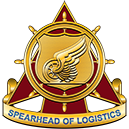The Trains Stop At Tampa: Port Mobilization During the Spanish-American War and the Evolution of Army Deployment Operations
BY Stephen T. Messenger
American History No. 104 (Summer 2017)
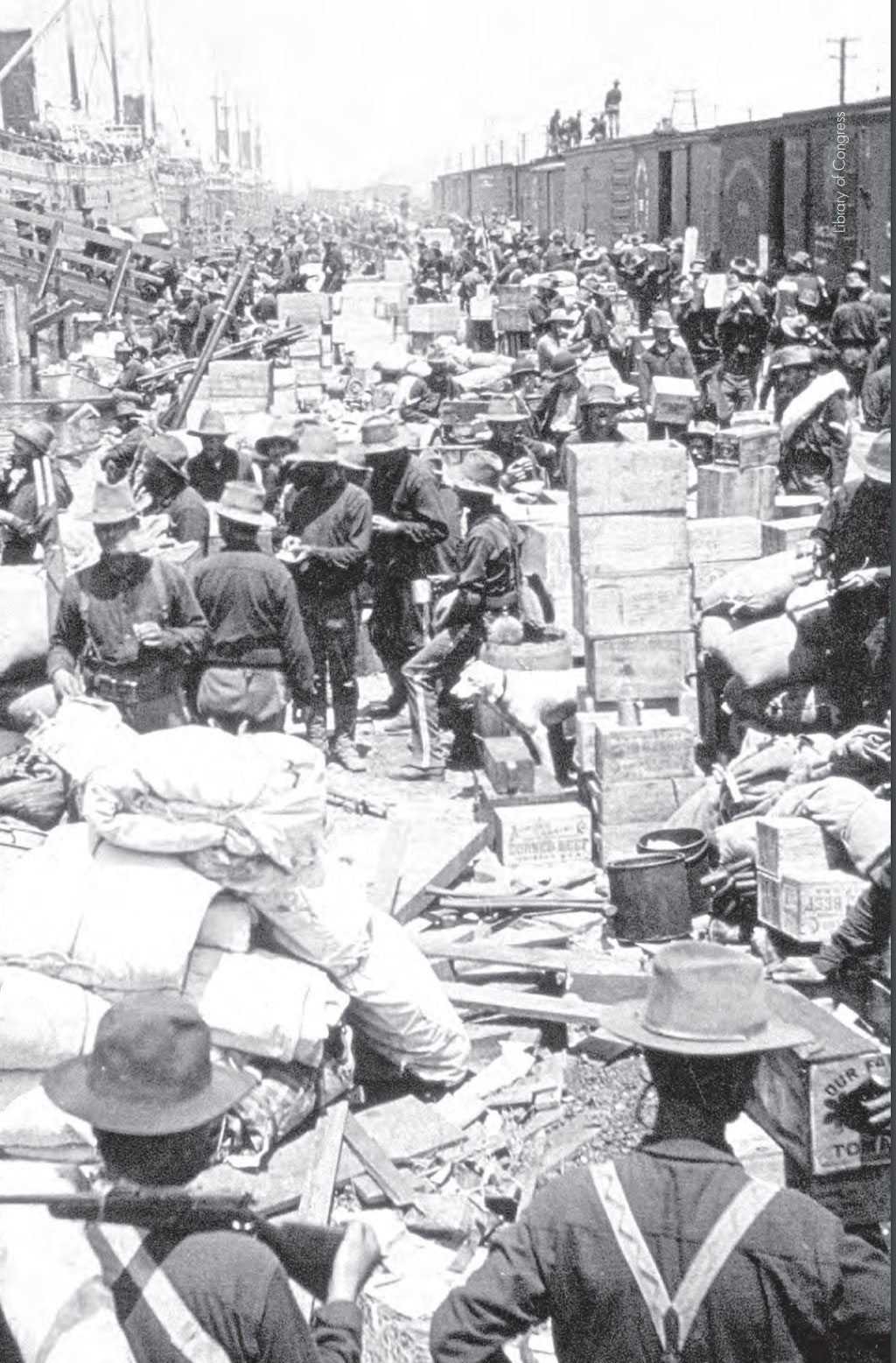
Loading transport ships in Tampa, Florida, bound for Santiago, Cuba
The American entry into World War I presented its military logistical planners with what must have seemed like an insurmountable problem. The scale and scope of World War I logistics operations was unfathomable at the time. The United States was eventually able to mobilize massive numbers of troops and materiel throughout the war, which contributed tremendously to the Allied victory. However, two decades earlier, another American expeditionary force met with very little success in deploying overseas. In the Spanish-American War, the United States mobilized soldiers destined for Cuba from a seldom used and little-known port in Florida called Tampa. The unsuccessful efforts at mobilizing a mere 25,000 troops highlighted a broken system that, following logistical evolution and improved methodology, led to successful World War I deployments less than twenty years later. The knowledge gained during the Tampa mobilization created the foundation of current Army deployment doctrine.

Port Mobilization During the Spanish-American War and the Evolution of Army Deployment Operations
The U.S. Army and Navy staged men and equipment in Tampa to prepare for the 1898 invasion of Cuba. The services conducted what planners today call the “deployment process.” This small scale mobilization was the first foreign expeditionary operation conducted by the Army since the Mexican American War in 1847. Critical to the Tampa operation was the application of establishing basing, maintaining tempo, and extending what the Army now calls operational reach, “the distance and duration across which a joint force can successfully employ military capabilities.”1
The evolution of the Army deployment process demonstrates the significance of the lessons learned from the force’s time in Tampa. The experience gained during the preparations for the invasion of Cuba in 1898 improved future operations and equipped the United States to move troops and materiel quickly and efficiently. The skills developed in Tampa enlightened mobilization planners and enabled them to establish processes to receive, stage, and deploy units and equipment in a more efficient manner using the principles of unity of command, synchronization, unit integrity, and balance.2
History of the Santiago Expedition
Cuba had been a Spanish colony since Christopher Columbus claimed it in the names of King Ferdinand and Queen Isabella in 1492. By the late nineteenth century, however, Cuban independence was on the minds of many of the island’s inhabitants. The Cuban insurrection against its Spanish colonial master began on 28 February 1895, although there had been indicators of an impending Composite Image: Soldiers with the 21st Infantry cook a meal next to boxcars on a siding in Tampa, 1898. Military History Institute Port Mobilization During the Spanish-American War and the Evolution of Army Deployment Operations This content downloaded from 132.159.80.40 on Wed, 20 Dec 2023 14:03:01 +00:00 All use subject to https: 36 Army History Summer 2017 insurgency as early as the 1850s. Numerous nonviolent efforts by the Cubans to gain independence from Spanish authority had repeatedly failed. However, political efforts drew in private American support for the rebels.3
The Spanish reacted by using military force to establish reconcentration camps for 300,000 Cubans beginning in 1896. With the insurgency growing larger, Spain attempted to solve the problem by agreeing to limited political autonomy in November 1897, but the revolutionaries declined the offer and sought complete independence. The United States, concerned with trade disruption, protested through diplomatic channels. American officials cited human rights violations, but the Cuban people received no respite from Spanish aggression and retributions.4
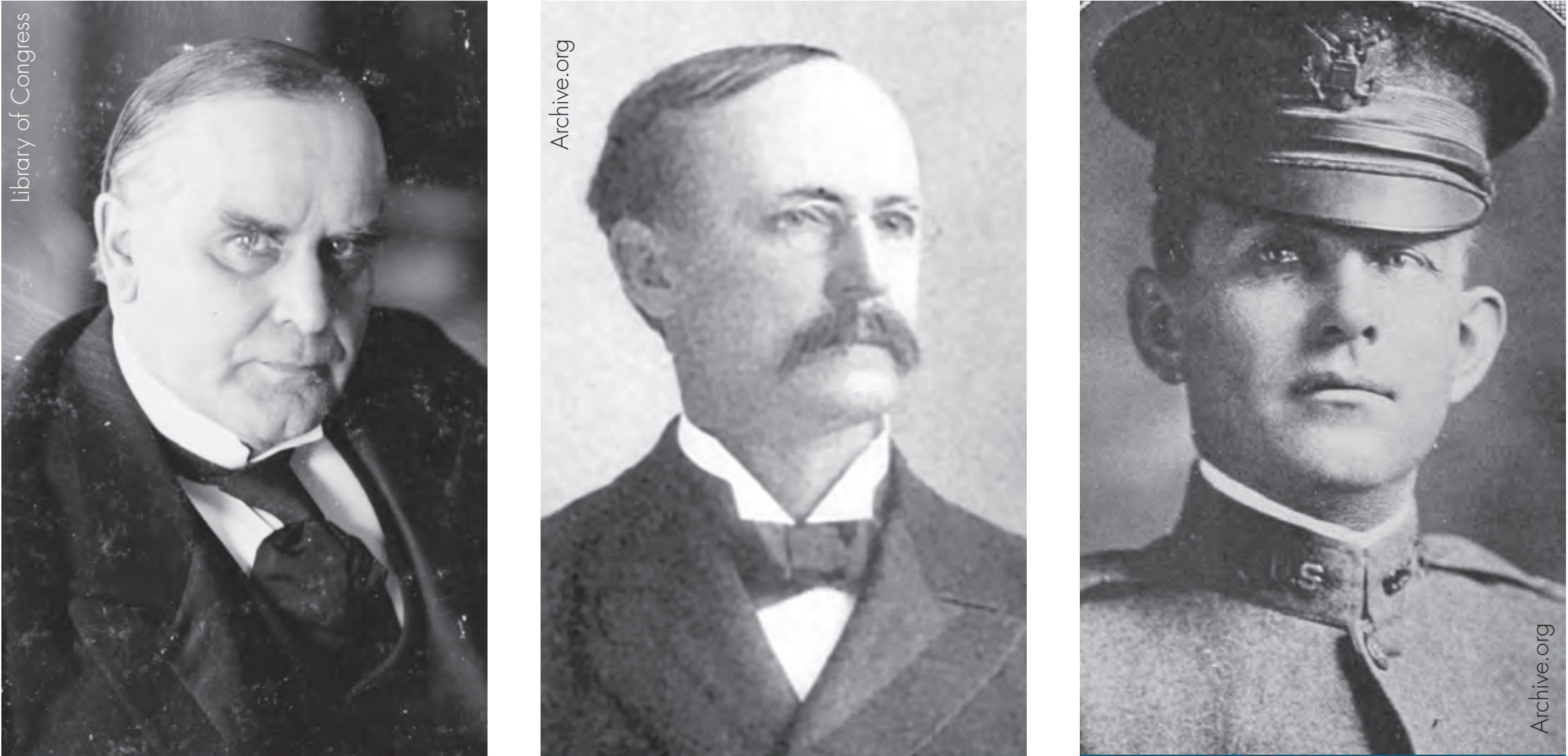
From left to right, President McKinley, c. 1989, Senator Thurston, c. 1899, Lieutenant Stewart, c. 1898.
On 12 January 1898, a large riot broke out on the streets of Havana that finally brought about American intervention. The instability of the situation concerned President William McKinley because of the threat to thousands of Americans living on the island and the millions of dollars invested in the Cuban economy. The riot compelled the president to send the armored cruiser USS Maine to Havana Harbor to project American power and protect American interests. The ship arrived in Havana on 25 January 1898. On 15 February, after three uneventful weeks, the Maine suddenly exploded, killing 260 sailors and marines.5 The investigation never linked Spanish action with the explosion, but the Maine incident quickly became the catalyst that sent the United States hurtling toward war with Spain.
President McKinley attempted to stem the public furor to go to war, but to no avail. After much consternation, he requested a $50 million appropriation, dubbed the “Fifty Million Bill,” for the purposes of national defense. The House of Representatives and the Senate unanimously passed the bill in early March, with $16 million earmarked for the Army and coastal defense.6 McKinley negotiated with Spain, which agreed to multiple demands for resolving the conf lict, with the exception of evacuating Cuba. Political pressure for war was fierce. U.S. Sen. John Thurston, a Republican from Nebraska, visited Cuba and reported 210,000 Cubans dying after Spain’s soldiers had driven them from their homes. Both houses of Congress encouraged intervention as Spanish forces and insurrectionists reached a stalemate: Spain could not stop the revolution and the Cubans could not drive Spanish rule from the island. The people of the United States pressed the government for action.7
The American preparations for war quickly escalated when, on 22 April, Congress gave the president the authority to call for volunteers to increase the size of the Regular Army from its current strength of 26,000. The following day, the president called for 125,000 volunteers. Congress declared war on 25 April and passed a bill the next day to double the size of existing Regular Army regiments.8 War planners decided that Tampa would serve as the embarkation point for the Cuban campaign, but the port lacked the infrastructure to execute the mission. Nevertheless, war had begun in bungling earnest. Second Lt. Merch Stewart described the mobilization as:
out of seeming chaos, brigades and divisions began to take form and substance. Gradually, also, regiments began to migrate Tampa-ward in preparation for we knew not what. Incidentally, we began to receive recruits whom we had no time to train, various articles of winter clothing, for which we had no use, and other impedimenta which were chiefly impedimenta.9
Time was of the essence, with men and equipment headed to Florida for the invasion of Cuba.
Tampa was a sleepy town on the Florida Gulf Coast with a population of 10,000 residents. Cigar making was the main industry. The town consisted of three banks, one movie theater, a transportation network consisting of gravel and planked roads, a handful of general stores, and one telegraph office. The main attraction was the Tampa Bay Hotel that rested on six acres with a silver dome covering a small casino. Henry B. Plant owned the property, along with the small one-track railroad leading nine miles from Tampa to the Port of Tampa.10 Plant had built the Port of Tampa to facilitate the flow of sea traffic from Key West and Cuba. In the port itself, a narrow channel allowed steamers access.11
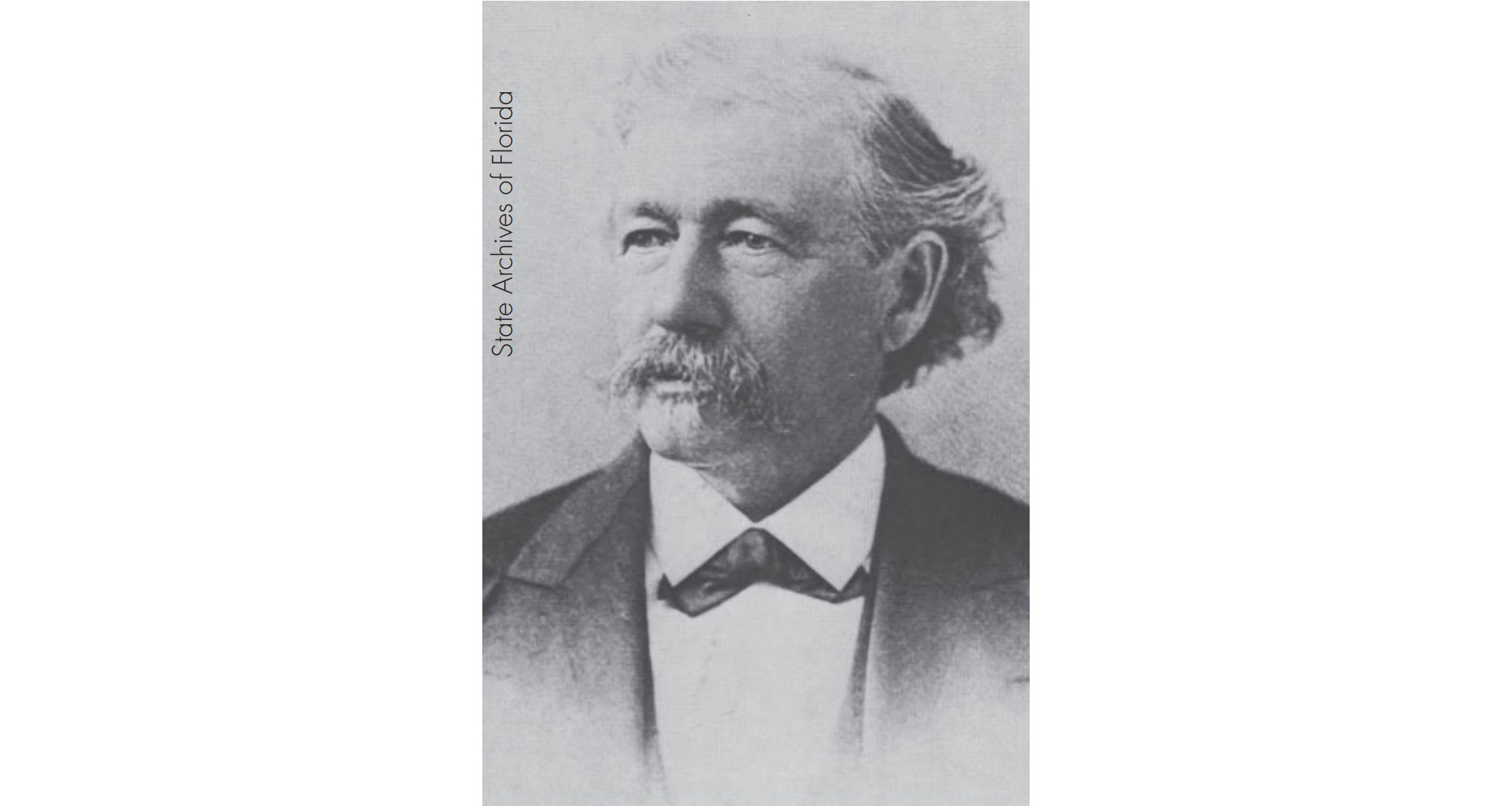
Library of Congress State Archives of Florida Henry B. Plant
The channel’s twenty-one foot depth was adequate for large ships, and the wharf allowed thirteen vessels to dock simultaneously.12
The War Department had selected Tampa and the adjacent bay for their strategic advantages. Tampa Bay’s geography was ideal to prevent Spanish cruisers from engaging transport ships during the loading process because the port was far enough inland to discourage enemy ships from entering and risk being trapped.13 The location also possessed the minimum estimated railroad and shipping facilities for transportation support and was the closest port to Cuba with adequate naval capacity.14 With these considerations in mind, planners chose Tampa “almost by administrative gravitation,” and the Army began assembling on 15 April 1898.15 In retrospect, had the planners known the size to which the assembled force would grow, they likely would not have chosen the Port of Tampa as the embarkation point.16
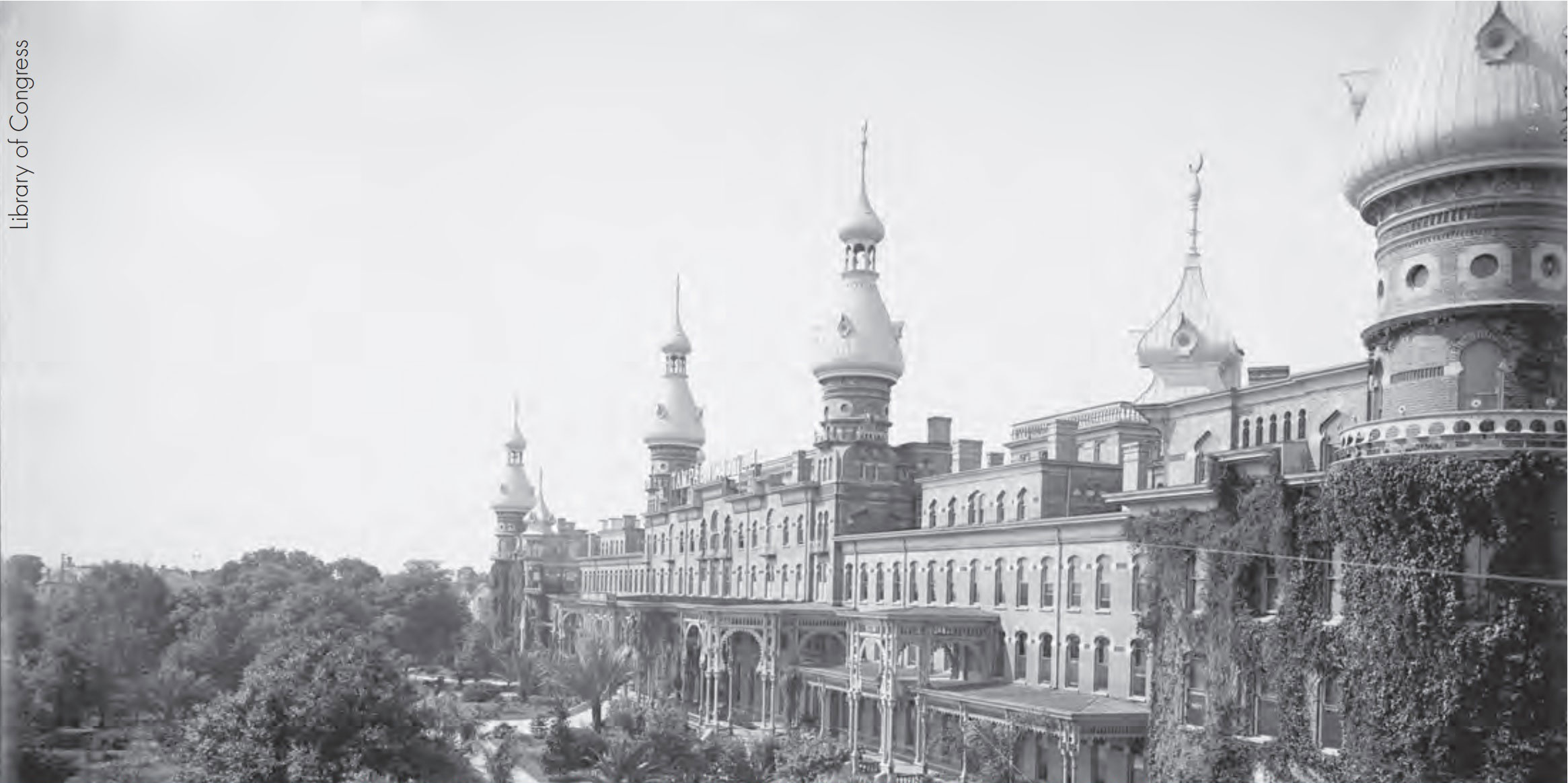
The Tampa Bay Hotel, c. 1898
At the start of the mobilization, Secretary of War Russell Alger ordered 5,000 Regular Army troops to prepare for quick movement into Cuba.17 Upon arrival in Florida, units camped in the sandy terrain and waited for their imminent movement overseas. The staging process at Tampa captured the essence of the Army’s modernday deployment doctrine designed to combine troops, equipment, and supplies into one cohesive fighting force.18 In effect, Tampa was both a port of embarkation and debarkation. This was in contrast to New York City during World War I, where New York was a port of embarkation for thousands of soldiers brought there by railroads and planners executed only the movement phase of deployment operations. Three factors during the planning process dictated the reasoning behind Tampa as the site of deployment: establishing basing, maintaining tempo, and extending operational reach. Planners selected this site to receive units, integrate them with their equipment, and quickly facilitate movement into Cuba via ocean vessels.
Tempo was critical to the deployment through Tampa.19 The U.S. Navy had sent a force to blockade the Port of Havana with additional orders to destroy the Spanish fleet and set conditions for an Army landing force. Tampa had to be able to quickly receive, stage, and move soldiers to Cuba following any naval action. Therefore, maintaining a consistent pace in the Cuban campaign was essential to preserving the initiative gained by the destruction of the Spanish fleet. The Army needed to provide soldiers and supplies quickly in support of the Cuban insurrection. Additionally, the War Department believed that the rapid arrival of American ground forces would demoralize Spanish forces and boost the morale of Cuban rebels.
Operational reach is the ability of a military force to project combat power and sustain mission effectiveness through supply lines. It relies on basing to deploy forces and sets the initial tempo of the operation.20 Deployment sites form the foundation of projecting an army’s ability to fight any campaign. As military theorist Carl von Clausewitz wrote, the larger an army becomes, the more dependent it is on the base, thus the flow of men and materiel to the field of battle from the base becomes more restricted as the size of the army grows.21 Military planners assumed a large degree of risk when they anticipated that the Army could build enough infrastructure capacity at Tampa to mobilize and deploy armed forces to retain the initiative.
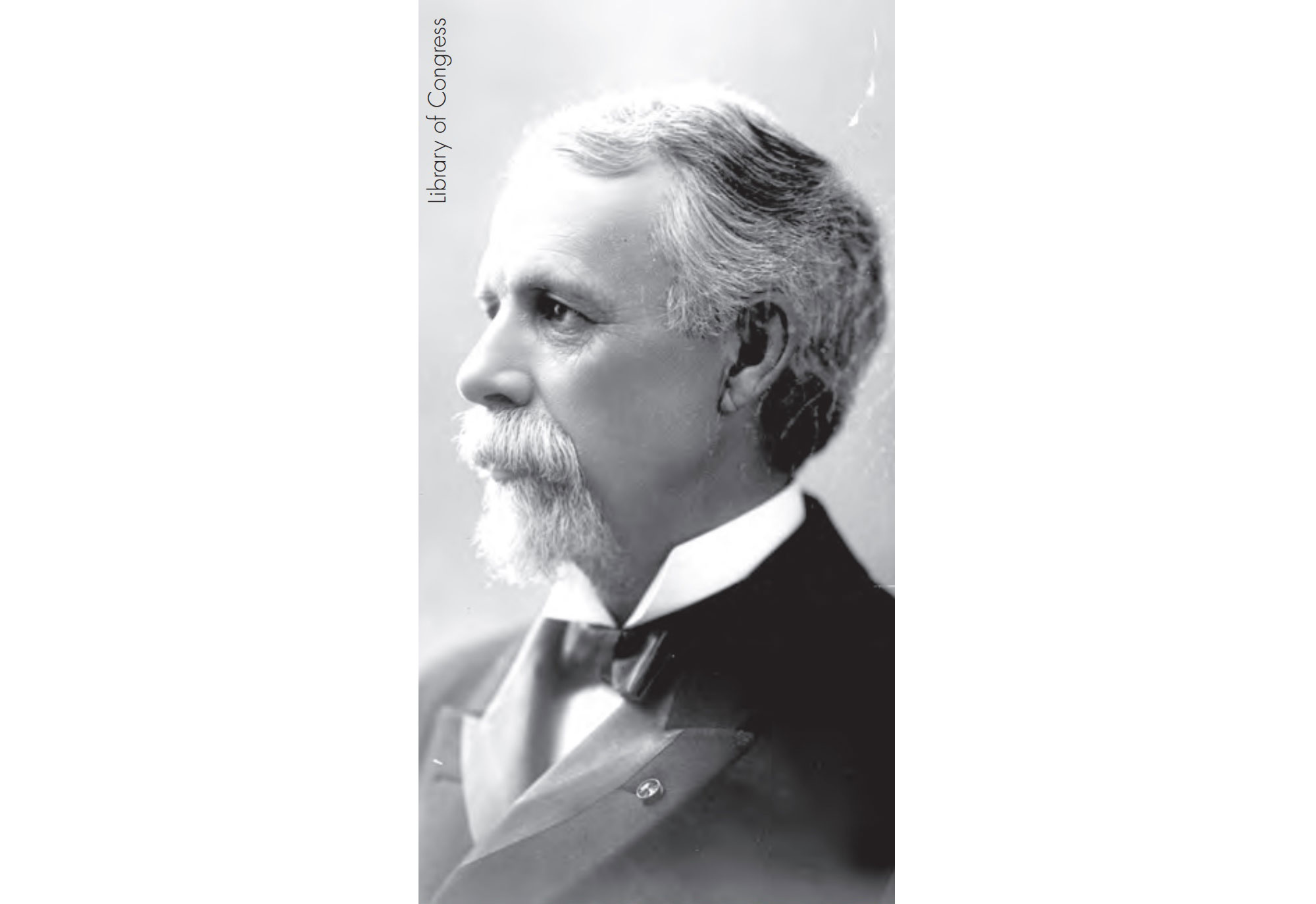
Secretary Alger, c. 1900
Beginning in early May 1898, mustered volunteers began pouring into Chickamauga Park, Georgia, for initial assembly, training, and follow on movement.22 From assembly points like this, enlistees typically moved to one of four sites: Camp Thomas, Tennessee; Tampa, Florida; Camp Alger, Virginia; and the Presidio of San Francisco, California.23 By the end of May, 163,626 soldiers had enlisted.24 While the government met the goal of increasing the fighting force, the Army’s organizational and institutional culture could only support a small, constabulary force. The Army’s entire logistics system consisted of a mere 22 commissary officers, 179 medical officers, and 57 quartermaster officers.25 This was simply not enough staff to support the increasing size of the Army. Still, there was no time to lose, and the desire to maintain the pace of deployment overruled logistics support. The original plan called for 5,000 soldiers to muster in Tampa. Sailing south, they would land in Cuba, conduct a reconnaissance-in-force, gain valuable intelligence, and aid the insurgents in whatever way they could.26 On 29 April 1898, an order from the adjutant general of the War Department directed Brig. Gen. William R. Shafter to “assume command of all the troops assembled there (Tampa).”27
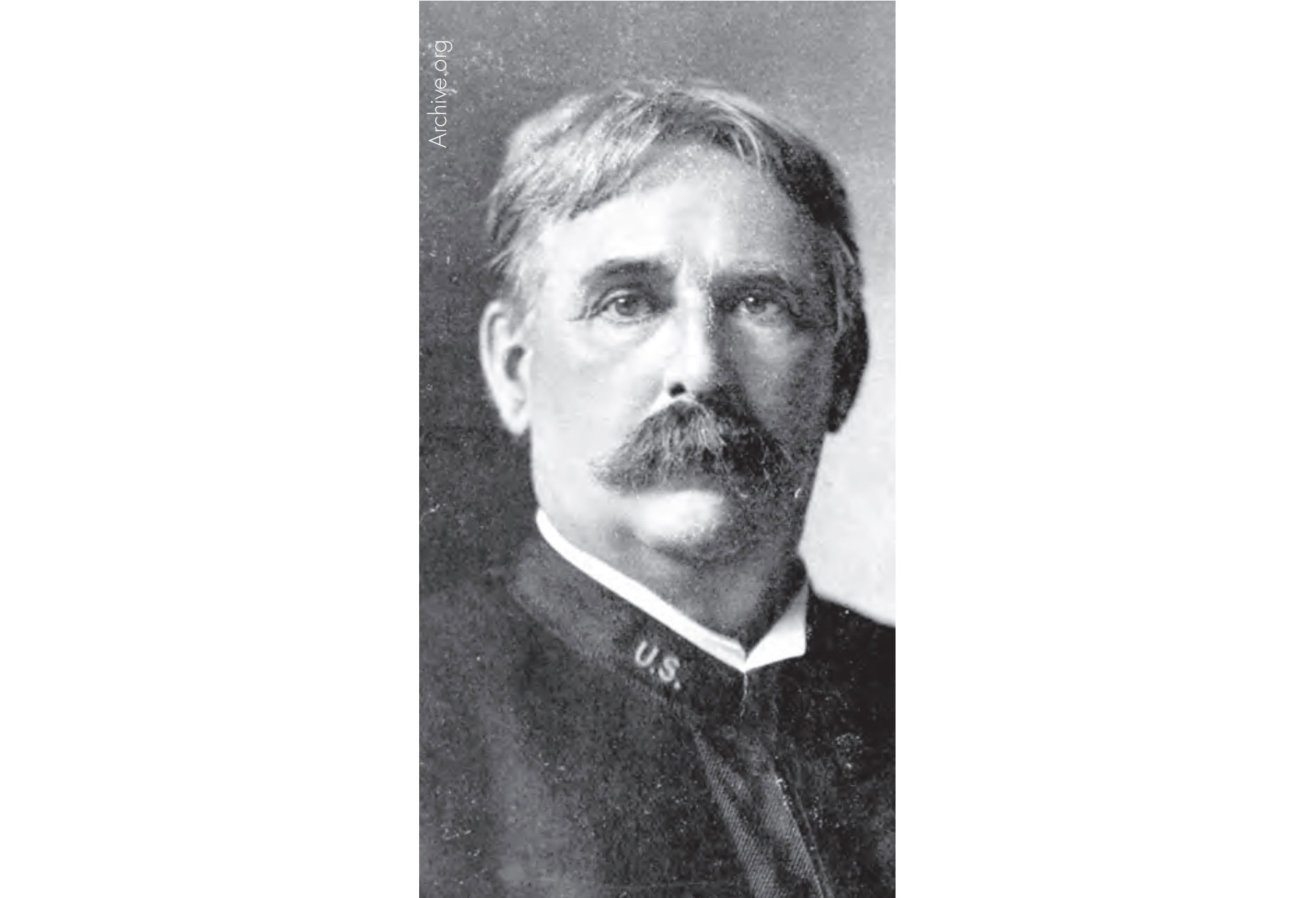
General Shafter
Shafter was born in rural Michigan and had enlisted in the Army before the Civil War. He earned the Medal of Honor for his conduct during the Battle of Fair Oaks, Virginia, on 31 May 1862, and continued his career across the plains in the Indian Wars throughout the 1870s. In 1897, Shafter received a promotion to brigadier general and assumed command of the Department of California. When the war with Spain began, Secretary of War Alger, Army Adjutant General Col. Henry Corbin, and Commanding General of the Army Maj. Gen. Nelson A. Miles unanimously chose Shafter as the expeditionary commander. Shafter was a large, stout man who weighed over 250 pounds following his years of sedentary garrison command. His chief commissary officer, Col. John F. Weston, stated Shafter “couldn’t walk two miles in an hour, [and was] just beastly obese.”28 Despite his weight, his peers described him as a brave soldier who contemplated decisions and did not make impulsive choices.29 Shafter’s one major shortcoming was his limited experience in the administration of large units. In Tampa, he failed to bring order to the port of embarkation, delegate command authority, or focus on the important details of unit departures.30 While senior leaders had chosen a seasoned commander to conduct combat operations in Cuba, they did not get an officer with the experience necessary to manage the vast sustainment challenges inherent with deploying the force from Tampa.
The Reception Process
The original call for the stationing of 5,000 troops at Tampa occurred one week before the official declaration of war on 25 April 1898.31 General Shafter arrived in Tampa on 30 April and received directions from the War Department. His orders were to maintain the pace of operations and sail at the earliest date possible with infantry, cavalry, artillery, and engineer forces. The American expeditionary force would land on the southern coast of Cuba to establish contact with General Maximo Gomez, the commander in chief of the insurgent army. The expedition would provide the rebels with supplies, arms, and ammunition. Shafter, though, was to avoid becoming decisively engaged, his main effort was to improve insurgent morale. However, Shafter soon received conflicting orders to delay any movement because there were Spanish warships spotted near Cuba. Preparations for deployment were to continue, and the expedition was to wait for further instructions.32

A map of the Greater Antilles Area of Operations 1898.
The plan for rapidly deploying the small contingent of 5,000 soldiers evolved into an unwieldy and lethargic force waiting for orders in the Florida heat. Moreover, in accordance with War Department directives, the number of troops began to increase—first to 12,000, and then to 25,000.33 The War Department did not anticipate the logistics needed to support this increase, and no one prepared Tampa for the challenges to come. On 10 May, Lt. Col. Charles F. Humphrey assumed command of the quartermaster department at Tampa. His command included ocean transportation and oversight of the depot quartermaster and chief quartermaster.34 Working with his assistant, Capt. James McKay, Humphrey focused his efforts on preparing the staging and movement process from Port Tampa to Cuba.35
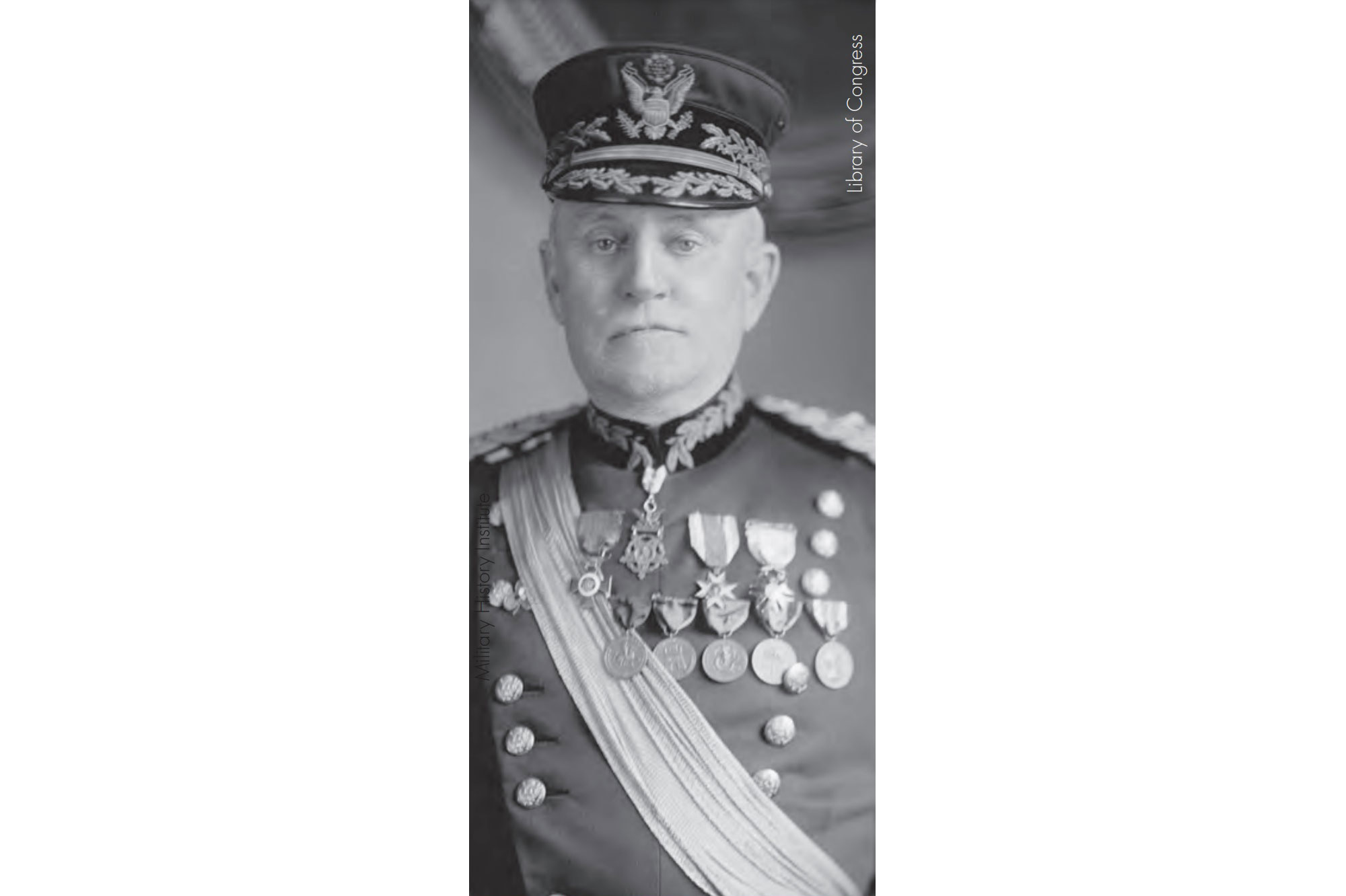
Charles F. Humphrey, shown here as a major general, c. 1907.
Shafter, promoted to major general of volunteers in early May, delegated the logistical management of the docks, but failed to establish a concept of reception for the thousands of troops about to arrive in Tampa. The modern-day reception process begins with receiving inbound units at transportation nodes and transitioning them to the next station. This process includes welcoming and providing guidance upon arrival, unloading equipment, marshalling troops into assigned areas, and providing sustenance and shelter for a temporary stay within the base.36 This orderly process coordinates incoming personnel and equipment while managing the flow of transitioning units. Tampa had no plan in place to manage this process effectively.
For 6 weeks the Regular army had been assembled at Tampa, enjoying a scene rather curiously combining aspects of a professional men’s reunion, a county fair, and, as the volunteer regiments began to arrive to augment the force, a major disaster.37
Planners had given very little thought to Tampa’s limited capabilities to transport and house men and materiel. The War Department continued to push troops and supplies into the area without assigning a commander to organize this complicated logistics effort. Additionally, Shafter did not assign a leader to coordinate the process from reception to embarkation.38 The result was general confusion for arriving troops. As one reporter wrote,
The United States troops who arrive in Tampa . . . are dumped out on a railway siding like so many emigrants. No staff officer prepares anything in advance for them. Regiments go off in any direction that suits them, looking for the nearest place where they may cook their pork and beans.39
Pvt. Charles Post of the 71st New York Volunteer Infantry arrived by train at nearby Ybor City, where he proceeded to walk three miles to the Tampa camp in the Florida heat. After his regiment suffered numerous heat stroke casualties on its march, the men settled in a wide-open area and dug latrines near the camp.40 The intended plan was for units to arrive and report to the headquarters in the Tampa Bay Hotel and receive their billeting locations.41 However, General Shafter and his command gave few instructions to units upon arrival.
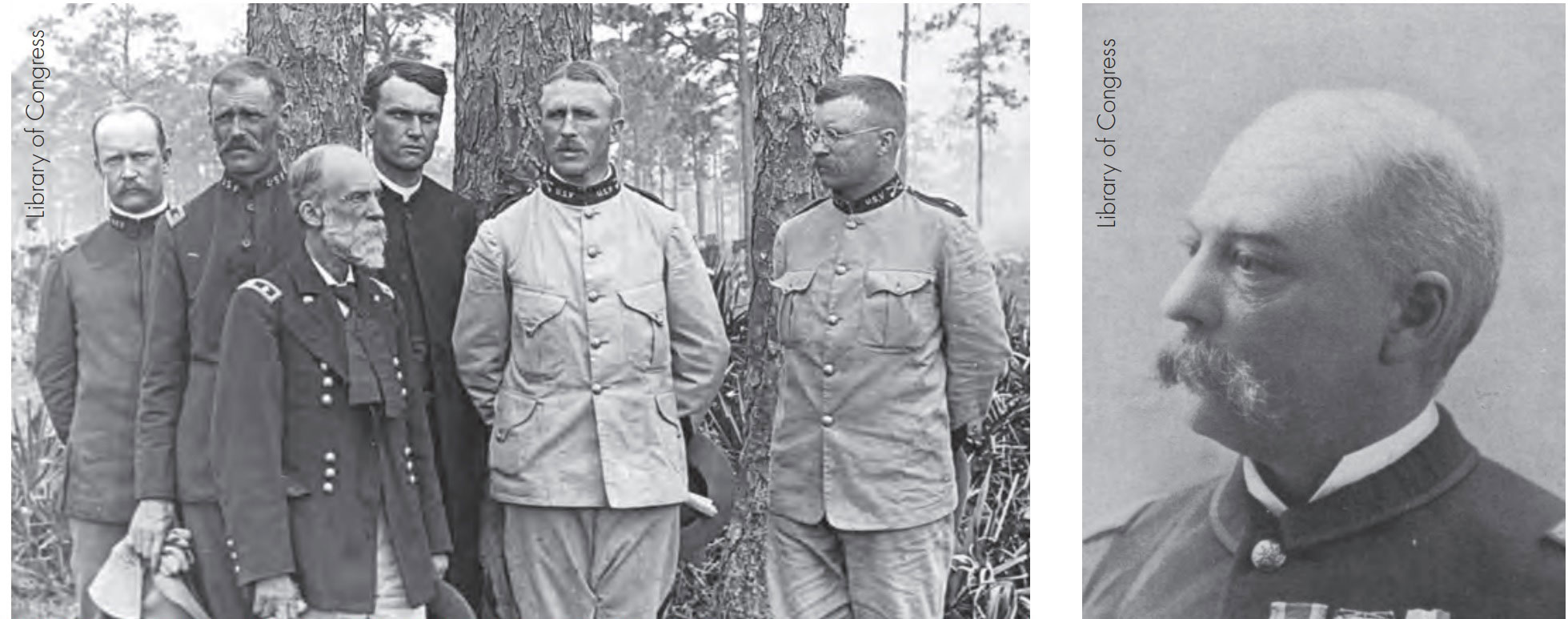
Image left: Staff of the 1st United States Volunteer Cavalry in Tampa, c. 1898. From left: Taylor MacDonald, Maj. Alexander Oswald Brodie, General Wheeler, unidentified officer, Colonel Wood, and Colonel Roosevelt. Image right: General Wade.
When Lt. Col. Theodore Roosevelt, with the 1st U.S. Volunteer Cavalry, reached Tampa, he described the conditions as “a perfect welter of confusion.” When the train arrived and disembarked the soldiers, there was no central authority to receive his “Rough Riders,” no guidance on where to camp, and no food for the first twenty-four hours. The future president stated that,
“everything connected with both military and railroad matters was in an almost inextricable tangle.”42 Roosevelt’s commander, Col. Leonard Wood, was in total agreement when he stated, Confusion, confusion, confusion. War! Why it is an advertisement to foreigners of our absolutely unprepared condition. We are dumped into a grove of short stumpy ground in the dark and our animals on an adjoining place filled with 2100 loose animals.43
Maj. Gen. Joseph Wheeler arrived in Tampa on 13 May to assume command of the cavalry division in V Corps. After reporting to Maj. Gen. James Wade, Wheeler received no instructions for three days while waiting for orders from the command.44
The War Department failed to plan for supply requirements as troops arrived in Tampa. Many of the units required four days of travel from their mobilization camps, but the supply system provided only two days of rations. The lucky ones received food from local residents and churches on arrival in the region.45 The incoming troops found limited camping grounds and an insufficient water supply.46 Three to five regiments arrived in Tampa every day. By 25 May, the expanding soldier population of now 17,000 troops began to overcrowd the Florida port. Due to increased congestion and lack of facilities, Shafter made the decision to open up additional camps in Lakeland and Jacksonville to alleviate the burden on the Tampa infrastructure.47 The reception process was a failure due to the lack of unity of command and because no one was in charge to synchronize unit arrivals with land allocation, supplies, or leadership. There was never any plan to support this influx of personnel, and there was no published timeline of unit arrivals. However, as bad as the troop reception was, the receiving of equipment was worse.
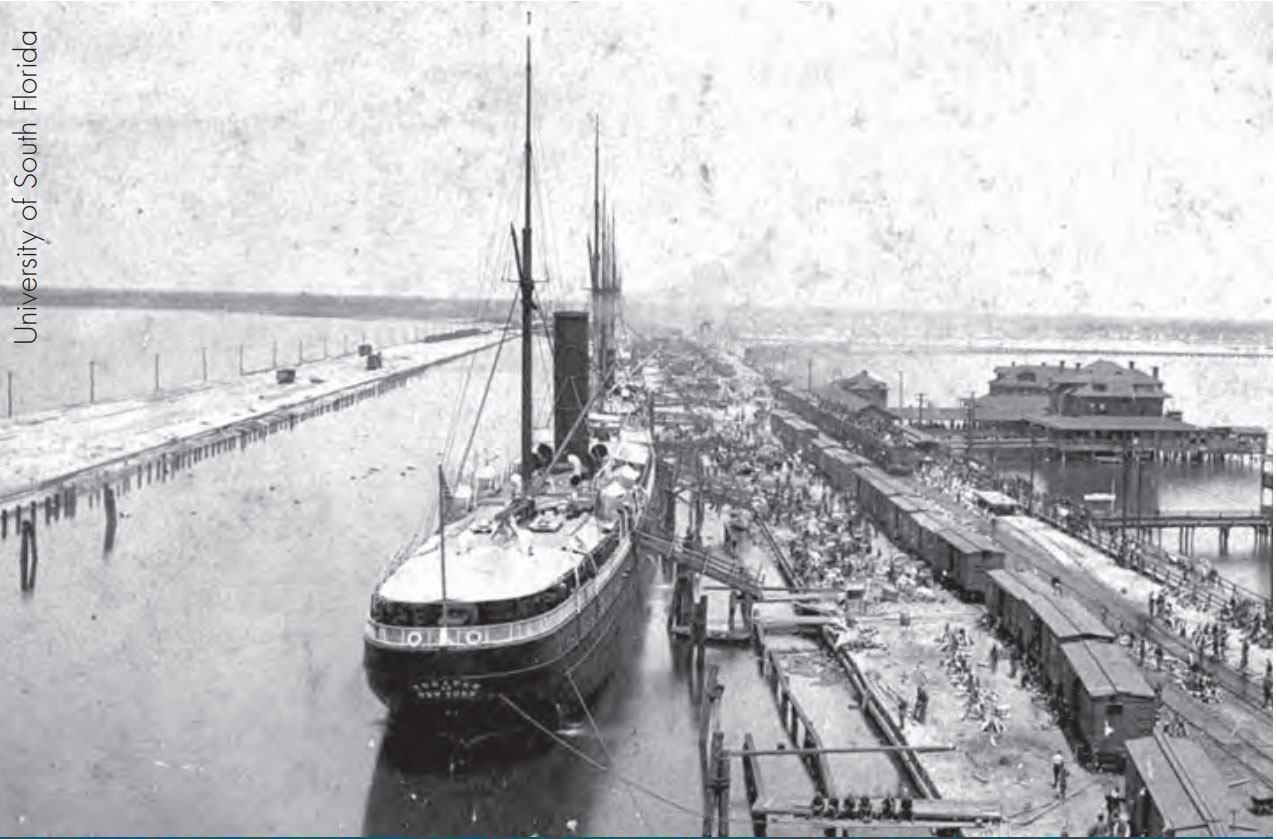
View of a dock at the port of Tampa with moored ships and boxcars being unloaded, c. 1898
In accordance with the time-honored Army tradition of “hurry up and wait,” the incoming soldiers’ rush to Tampa was followed by weeks of waiting. Meanwhile, quartermaster and commissary officers worked on the chaotic tasks of organizing the thousands of tons of arriving supplies.48 The two main issues faced were the lack of railroad infrastructure and the privatized commercial transportation options, which were monopolized by Henry Plant. There were only two railroad lines leading to the City of Tampa. From there, one line proceeded nine miles to the Port of Tampa. Plant independently operated this line and refused to allow other rail companies to use it.49 Complicating matters, Plant ran sightseeing trains on his line to allow citizens the opportunity to observe the military activities. He also allowed train and boat services to continue in the harbor.50 The backlog these two factors created was tremendous as equipment relentlessly poured into the small town.
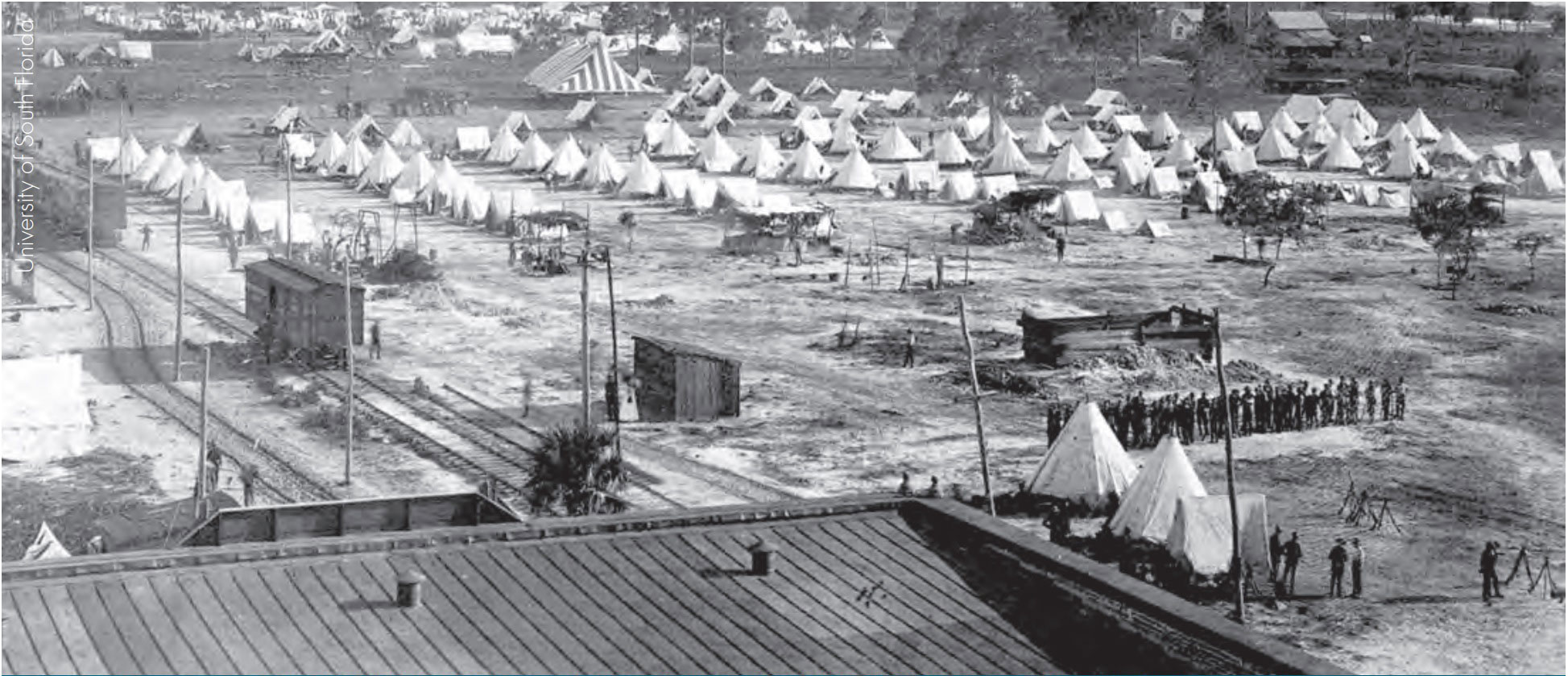
Aerial view of military encampment near Tampa, c. 1898
By 18 May, there were more than 1,000 freight cars ready to be unloaded with a processing rate of only three per day. Trains were waiting as far north as Columbia, South Carolina, due to the backlogs. Train cars that did make it to Tampa remained loaded because of the lack of warehousing By 18 May, there were more than 1,000 freight cars ready to be unloaded with a processing rate of only three per day. Trains were waiting as far north as Columbia, South Carolina, due to the backlogs. Train cars that did make it to Tampa remained loaded because of the lack of warehousing University of South Florida University of South Florida Aerial view of military encampment near Tampa, c. 1898 View of a dock at the port of Tampa with moored ships and boxcars being unloaded, c. 1898 This content downloaded from 132.159.80.40 on Wed, 20 Dec 2023 14:03:01 +00:00 All use subject to https: 42 Army History Summer 2017 and on site transportation.51 Only five government wagons and twelve hired civilian wagons were on hand to facilitate loading and unloading.52 and on site transportation.51 Only five government wagons and twelve hired civilian wagons were on hand to facilitate loading and unloading.52
Incoming railroad companies feuded with both the government and Plant. The local developer refused to let competitors use his rail line and ordered his employees to transfer freight solely with Plant equipment. This only stopped when the Army threatened to take over the Plant line.53 The War Department shipped supplies with such haste that it neglected to label the railroad cars and in some instances, the bills of lading were weeks behind and each container had to be hand inspected.
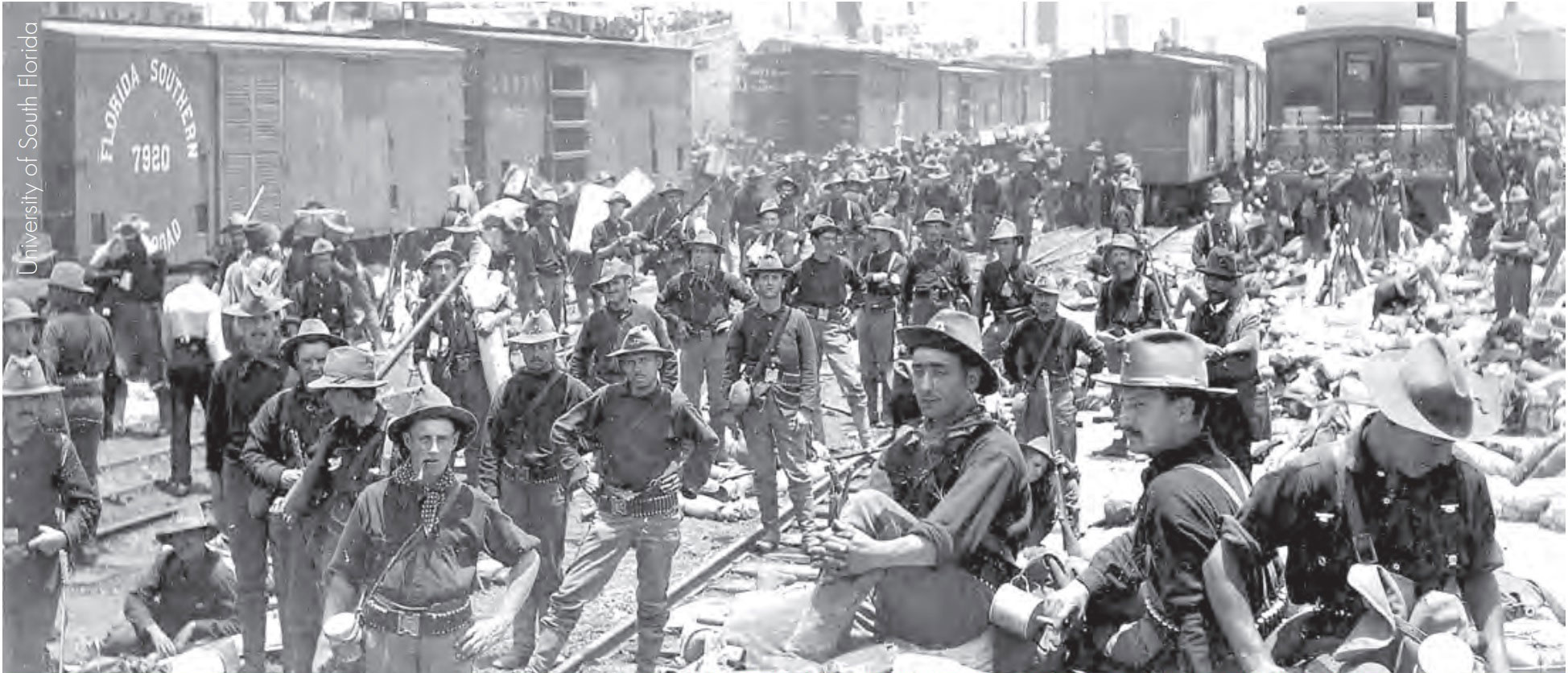
Soldiers of the 71st New York Volunteer Infantry wait with their gear at the port of Tampa.
Units attempting to find the equipment they had shipped often took whatever supplies they came across first, leading to further confusion.54 With very limited warehousing, the troops unloaded the cars slowly to preserve precious storage space, but failed to organize the cargo with any semblance of logic.55 The reception process was a total failure and backlogs mounted. The loading parties could not keep up with the inf lux of equipment, delaying the expedition’s readiness to sail. In contrast, Shafter required his expeditionary force staged and ready to react to a short-notice order to deploy to Cuba.
Staging Process
The staging process organizes personnel and supplies into combat formations, ready to deploy as a cohesive fighting force. It joins soldiers to their equipment, and places them in arranged locations to deploy, in accordance with a planned timeline and provides logistics support for units flowing through.56 The conditions established at Tampa failed to lay the groundwork for successful staging operations.
The water supply was short; machinery broke down; siege guns had to be carried bodily for miles; supply trains were stalled; mules and horses that should have arrived had been left behind in some unknown locality; troops coming in from a dozen different camps in a dozen different stages of unpreparedness—such were the few of the tangles, drawbacks and difficulties that had to be met, unraveled, and conquered before the great transport fleet could get on her way.57
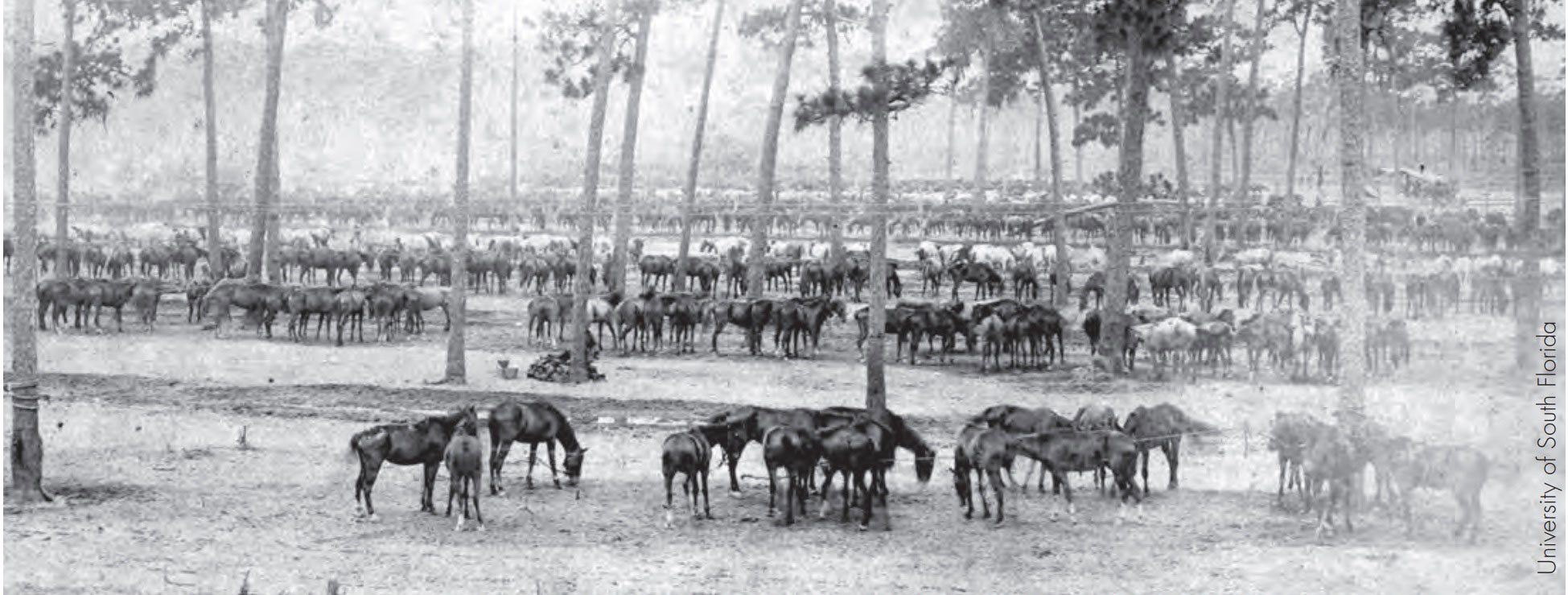
Horses corralled near Tampa waiting for shipment to Cuba
Yet, in anticipation of the Navy destroying the Spanish fleet, the War Department expected the expeditionary force to load transports at a moment’s notice and move quickly to Cuba. The expedition simply was not ready to embark due to the lack of preparations.
Providing logistical support to incoming units was problematic. The lack of water and sanitary facilities forced units to encamp in small towns several miles from Tampa. The small post office could not identify packages destined for staged soldiers due to the lack of mailing labels. Units received supply and organizational equipment in an untimely manner or not at all, and materiel shortages contributed to insufficient and incomplete training.58 Animals, including cavalry horses and mules to haul wagons, required more fodder than was available.59 Ammunition was not in adequate supply and the War Department could not accurately predict when sufficient quantities would arrive.60
The artillery force faced a unique problem with its field pieces, a condition that lasted through arrival in Santiago. Manufacturers shipped artillery components piecemeal in separate freight cars from different factories. Artillery batteries had to seek out separate shipments of caissons, carriages, field pieces, and ammunition to assemble and ready their guns.61 Many components remained on unidentified boxcars twenty-five miles outside of Tampa through the end of May.62 The original plans had called for transitioning the artillery batteries to a war footing and creating larger six-gun batteries, but the supply issues were overwhelming.63
The preparation of the transports was the final staging action necessary. When the United States declared war, the Army owned no shipping vessels. It managed to obtain four by the end of April and thirty by the end of May; however, none possessed the proper ventilation systems or facilities necessary for transporting large numbers of men. The government purchased these ships from privatized freightliners in the Gulf of Mexico.64
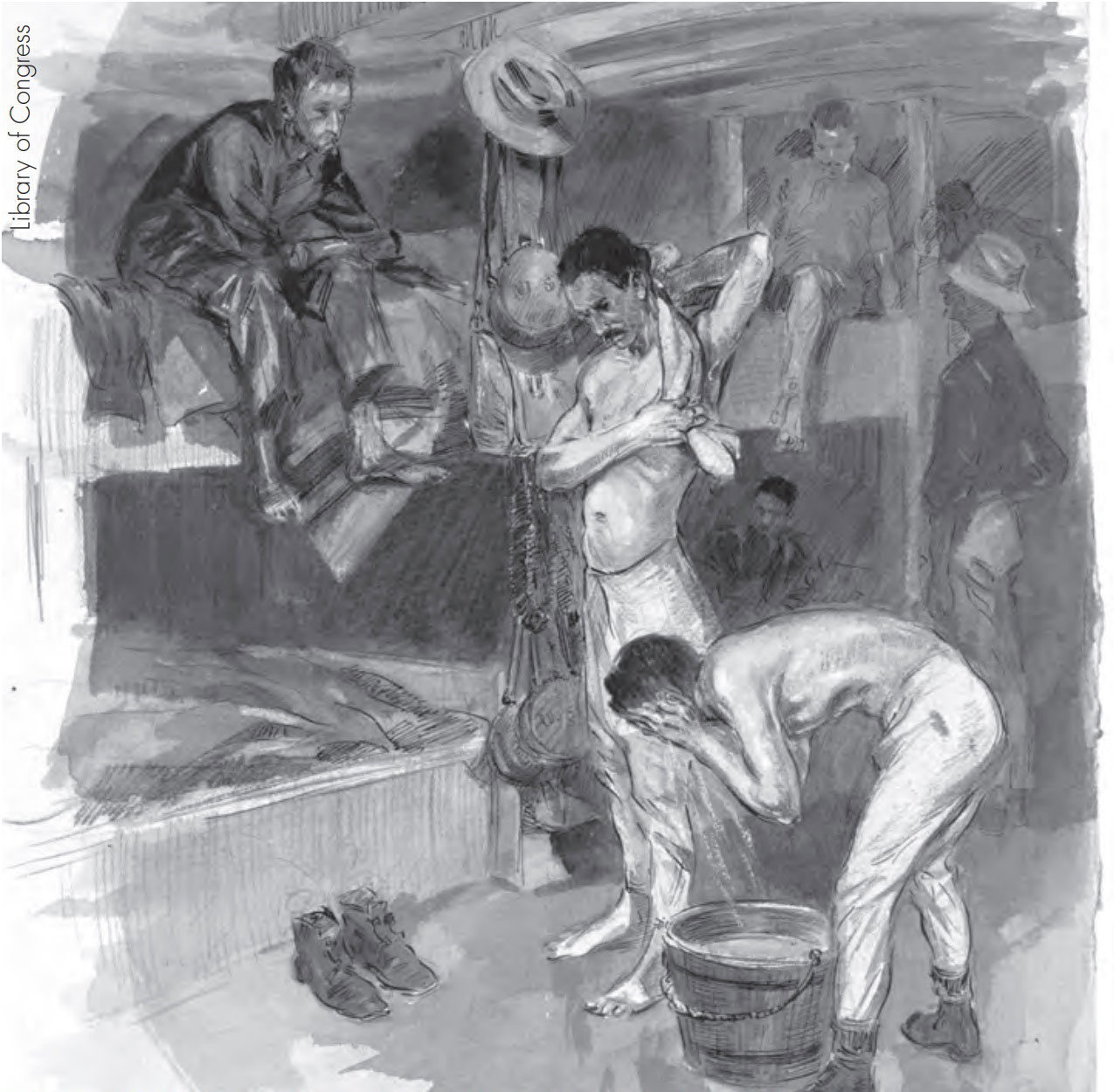
Sketch by William Glackens showing soldiers in their berths and bathing aboard a transport bound for Cuba, c.1898
The War Department invested a huge amount of manpower and resources to turn these freighters into troopships with bunks, water storage tanks, and proper ventilation.65 In total, the War Department purchased thirty-nine vessels at a cost of $7 million, a sum not included in the allocated “Fifty Million Bill.” When completed, the transports could sail for thirty straight hours but only provided minimal comfort for the troops.66 The men would have to take turns sleeping on bunks, and, in the worst case for one vessel, engineers only had enough room to install twelve toilets for a compliment of 1,200 soldiers.67
Workers converted the Miami and San Marcos from a cattle boat and a freighter, respectively, into transport ships. However, as one soldier from the 6th Infantry Regiment stated, “It was a misnomer to call these ships transports.”68 The quartermaster general originally estimated the new transport fleet’s overall carrying capacity at 25,000 soldiers, but this was quickly lowered to 17,000 due to space limitations.69
Most soldiers spent much of May in the hot Florida sun focused on preparing for war and entertaining themselves. General Miles issued orders on 30 May for officers to “labor diligently and zealously to perfect himself and his subordinates in military drill, instruction, [and] discipline.”70 Soldiers considered drill commonplace during staging, but the commanders wanted additional training. New volunteers with little to no combat experience arrived daily along with officers and noncommissioned officers largely unfamiliar with conducting training. In the 28 May edition of Harpers Weekly, correspondent Poultney Bigelow pointed out that units were training, but “the senior commanders had never seen their commands.”71 The oppressive heat shortened many drills due to soldier exhaustion, with the lack of water compounding the misery. Units completed drills early in the mornings and late evenings in order to avoid the heat. In addition, the limited space to maneuver supported only small-scale training exercises.72 Shafter considered this a liability and even contemplated moving a portion of the command northeast to Jacksonville, but the force never relocated and drills continued in the limited training space.73
Like the quartermasters, the commissary supply system was also inadequate at Tampa. The embarkation point experienced problems such as receiving rotten meat from the food contractors. Even when arriving on refrigerated train cars, soldiers opened food shipments that were often spoiled. The Department of Agriculture investigated and could find no evidence of tampering or wrongdoing.74 Nevertheless, unloading parties wore handkerchiefs around their faces as they transferred the putrid meat into ditches for quick burial. The troops dubbed the shipments “Alger’s Embalmed Beef” to assign blame to the secretary of war and his perceived lack of support for the Tampa expedition.75 The soldiers received their main supply of food from rations, which arrived via the Subsistence Department’s short notice purchases. Depot commissaries purchased and shipped sixty days of supply to Tampa, and Regular Army units en route to the embarkation point received thirty days of rations. This system, once it caught up to the number of soldiers in Florida, eventually stockpiled a ninetyday supply at Tampa for 70,000 men.76

Troops of the 3d Nebraska Volunteer Infantry march along Pablo Beach near Jacksonville, Florida, c. 1898.
The spoiled meat issue added to the overall concerns of the poor health of the camp. While there were no deaths in Tampa, there was a constant threat of dysentery and one outbreak of typhoid fever. The overcrowding, lack of supplies, animal waste, kitchen refuse, and rotten meat contributed to unsanitary conditions. However, the short stay in Tampa, compared to other camps, prevented unnecessary deaths from disease. The chief surgeon of the 5th Cavalry Division reported to General Wheeler the satisfactory Tampa camp conditions and health of the troops, with each unit possessing three to four weeks of medical supplies.77 Meanwhile, hundreds of soldiers died at various camps across the United States, including 425 who perished at Camp Thomas, Tennessee.78
Most of the volunteer units arrived without proper equipment. Planners designed supply stations at Tampa to equip newly enlisted soldiers with the needed gear during staging. However, lack of warehousing facilities coupled with shipping backlogs prevented an adequate on-hand supply. The availability of equipment determined distribution. At the quartermaster warehouse, a supply sergeant would guess the sizes of each soldier for uniforms, shoes, and hats. If incorrect, the exchange process could take as many as three days.79 The 28 May edition of Harpers Weekly mused that Congress declared war thirty days ago but,
not one regiment is yet equipped with uniforms suitable for hot weather. The Cuban Patriots and cigar-makers look happy in their big Panama hats and loose linen trousers, but the U.S. troops sit day and night in their cowhide boots, thick flannel shirts, and winter trousers.80
Most soldiers received only one set of clothing to replace their cold weather uniforms. The weapons situation was even more abysmal, with the depot commander refusing weapons requisitions for the units until they arrived at camp.81 This delay further exacerbated the supply problem.
The problems of inadequate supply and poor training led to an inordinate amount of idle time for the troops. Naturally, soldiers found plenty to do in Tampa to keep busy. Unfortunately, this also meant violating the second part of Miles’ orders to “maintain the highest character, to foster and stimulate that truly soldierly spirit and patriotic devotion to duty which must characterize an effective army.”82 Officers issued passes for the men to explore the local area, and the enlisted soldiers took advantage of this privilege. Some chose to walk peacefully around the Tampa Bay Hotel or visit the nearby towns. Others found ways to get into trouble, like Pvt. Frank Brito, who discovered an opium den in Ybor City.83 Unscrupulous entrepreneurs took advantage of the young population, as “there were plenty of locations for alcohol, good times, gambling, and prostitution.”84 A private with less than one month’s service received $10.35 in pay and could find plenty of ways to enjoy his paycheck. One night, Pvt. Charles Post assisted in retrieving unruly troops from Tampa; he observed hundreds of detained soldiers from his 1st Infantry Regiment.85
The waiting in Tampa continued through the last week of May. While the enlisted men occupied their time in the towns, the officers lounged in the Tampa Bay Hotel, reuniting and sharing war stories with old colleagues.86
Colonel Roosevelt noted general officers milling about the hotel with their staffs, women in pretty dresses, newspaper correspondents, and foreign onlookers from Great Britain, Germany, Russia, France, and Japan.87 Other notables seen around the hotel were Clara Barton, founder of the Red Cross; evangelist Ira Sankey; the adviser to the Cuban rebels, Capt. Andrew Rowan; Kaiser Wilhelm II’s observer, Count Gustav Adolf von Goetzen; and Roosevelt’s wife, Edith Carow Roosevelt.88 Maj. Gen. Shafter set up his headquarters in the hotel and continued to wait for word of the Spanish fleet’s destruction as the days ticked by.
Onward Movement Process
Onward movement is the forward progress of units transitioning from staging areas to follow-on destinations and applies to personnel and equipment.89 In Tampa, the changing nature of the strategic situation prevented Shafter from understanding how best to achieve the original goals of the McKinley administration, much less onward movement. While Shafter continued through all of May to prepare for a quick mission to provide moral and physical support to insurgents, the guidance from the president suddenly changed.
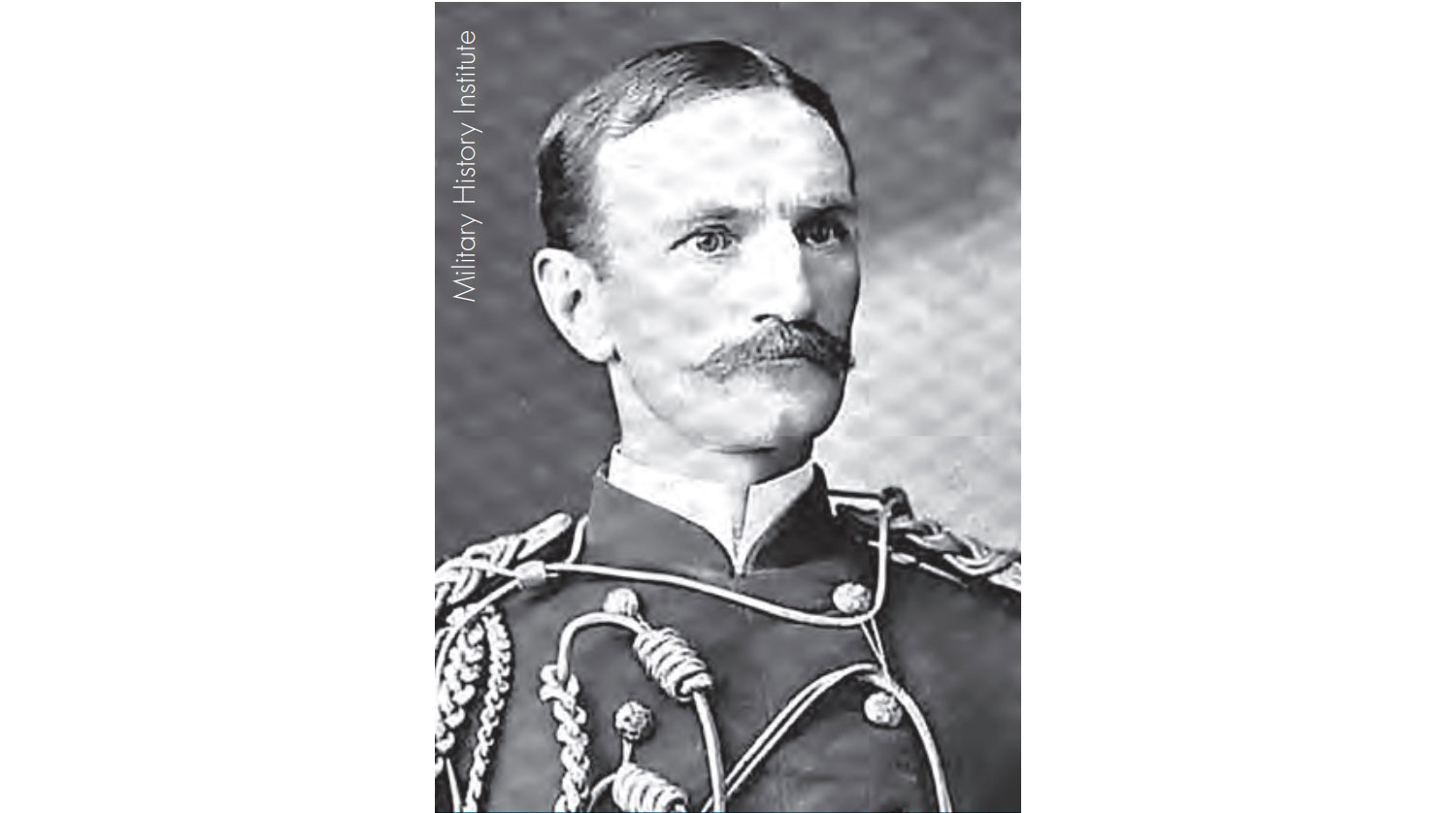
Colonel Miley
Lt. Col. John Miley, the aide-de-camp to Shafter, stated that on 26 May, the general received an order via telegram to prepare 25,000 soldiers for departure from Tampa. The War Department had issued the warning of a changing mission: the expeditionary force would now directly engage Spanish soldiers, but Shafter had no definitive details with which to plan.90 The following day, correspondence from Secretary of the Navy John Long shed some light on matters by emphasizing the Navy Department’s urgent pleas to mobilize soldiers to invade Cuba.91 Finally, on 30 May, General Miles issued orders to Shafter clarifying the exact mission of the expedition:
Go with your force to capture garrison at Santiago and assist in capturing the harbor and fleet. . . . Have your command embark as rapidly as possible and telegraph when your expedition will be ready to sail.92
This order expedited Shafter’s tempo of operations in loading supplies on the transports.
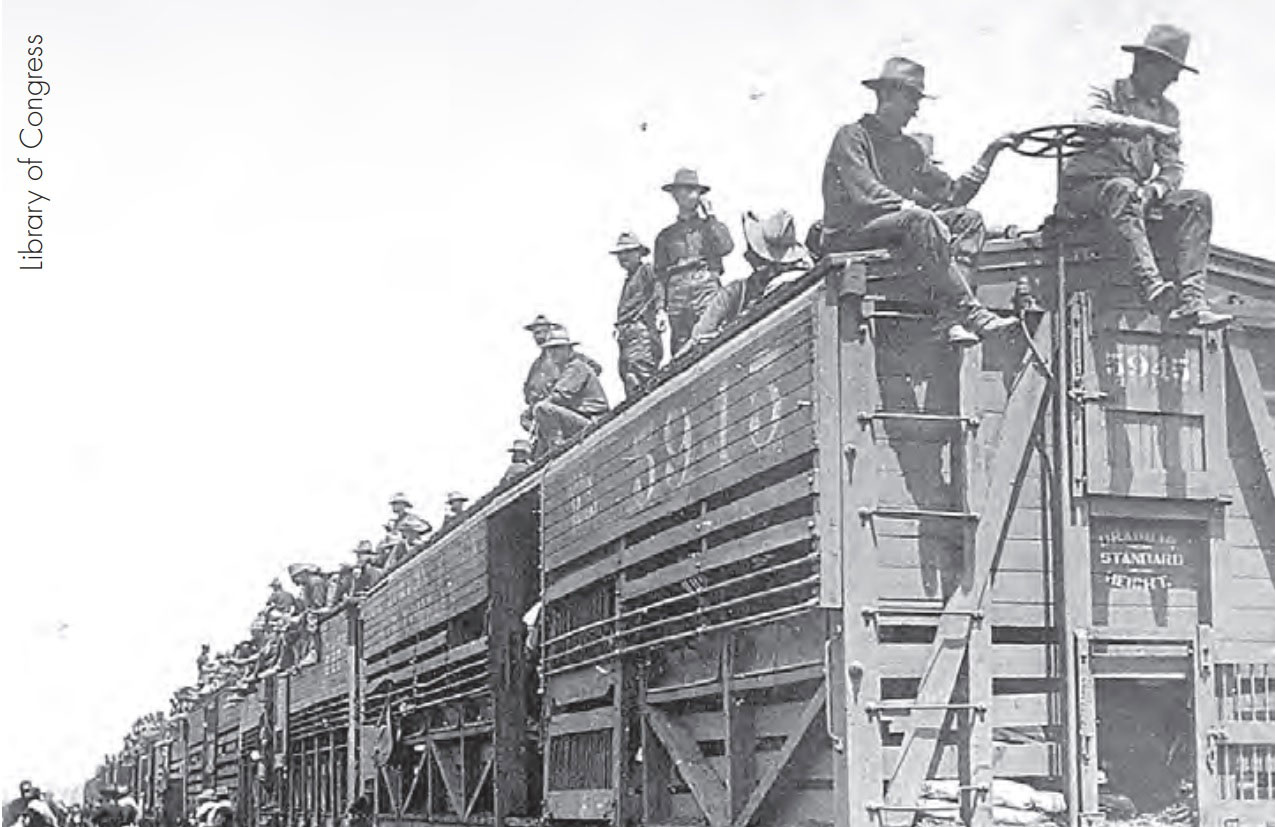
U.S. troops arrive aboard railcars in Tampa, c. 1898.
The force made all efforts to load the ships from 30 May through 6 June. Working well into the night, troops traveled forward from outlying camps. Supplies from warehouses in Tampa started movement toward the port, further congesting the single-track line. On 31 May, deck hands filled coal and water on the ships, and men began loading rations. The new orders called for 25,000 men to be supported for six months. This directive was subsequently lowered to two months along with an additional 100,000 rations scattered throughout the ships in the event of separation. The work of loading artillery wagons, guns, and caissons began on 1 June. Artillerymen now sensed the urgency of finding disparate components and linking them to form complete gun systems. The men spent considerable time consolidating commissary rations that shipped in separate railcars.93 The single-track line created and exacerbated delays in moving materiel to the port.
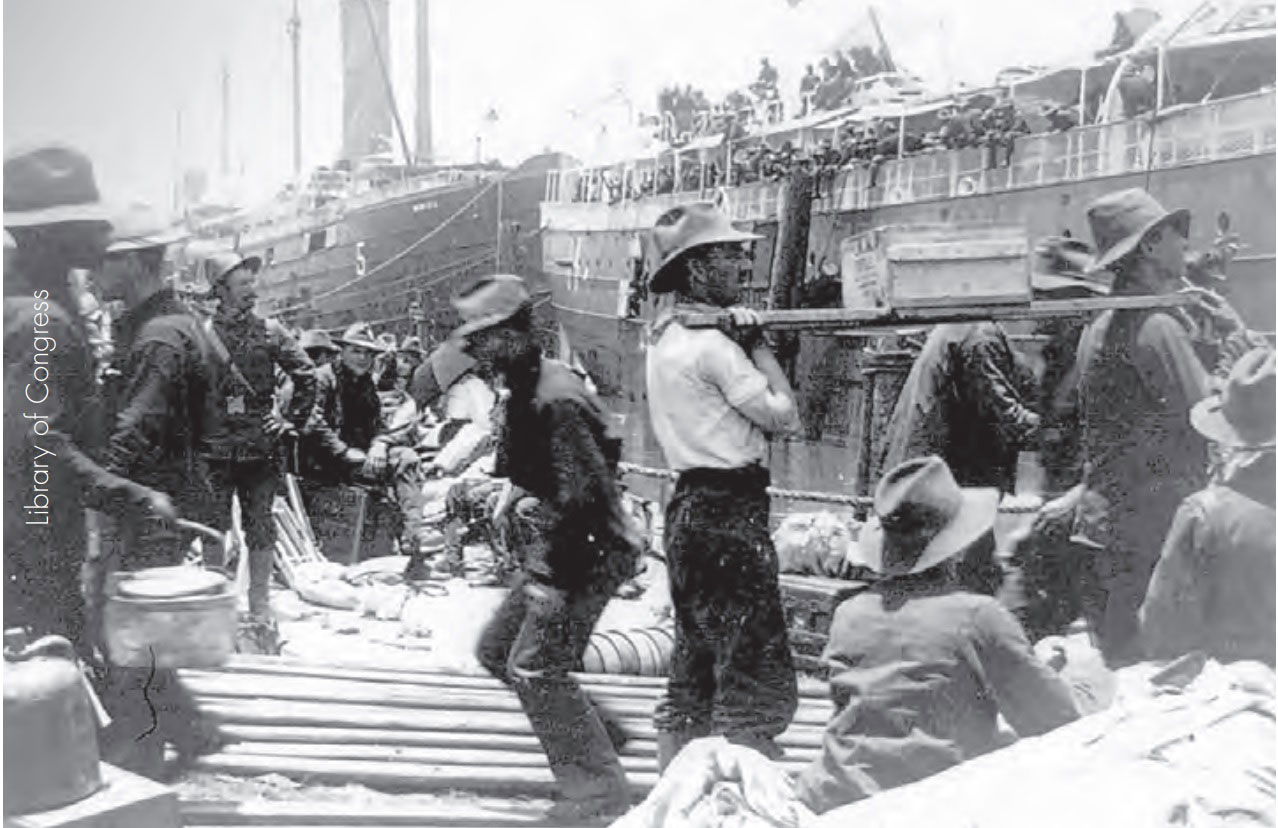
Supplies being loaded aboard ships at the port of Tampa, c. 1898.
Simultaneous activities at the harbor caused a bottleneck. Once equipment finally arrived at the dock, contracted stevedores became the driving force to load the ships. This was no easy task, as the goal was to maintain unit integrity with equipment as they assigned units to vessels. With limited berths, the ships continuously rotated within the narrow port to align with arriving railroad shipments, which caused further delays.94 The stevedores mostly loaded equipment from the railcars by hand across fifty feet of sandy terrain and then up steep ramps to the vessels. Once their shifts were over, many of these men fell asleep on the spot where they last stopped working due to exhaustion.95 All these difficulties notwithstanding, the contractors loaded over 10,000,000 pounds of materiel. The ration trains moved from one ship to the next to unload their cargoes before attempting to exit the single lane track. Soldiers assembled each artillery piece on the docks prior to loading. This practice ensured that the breech mechanisms, fuses, projectiles, and guns were present and facilitated the final and complete assembly of each gun. To add to the confusion, Plant kept the rail line open for civilian sightseers.96 Congestion had reached its peak.
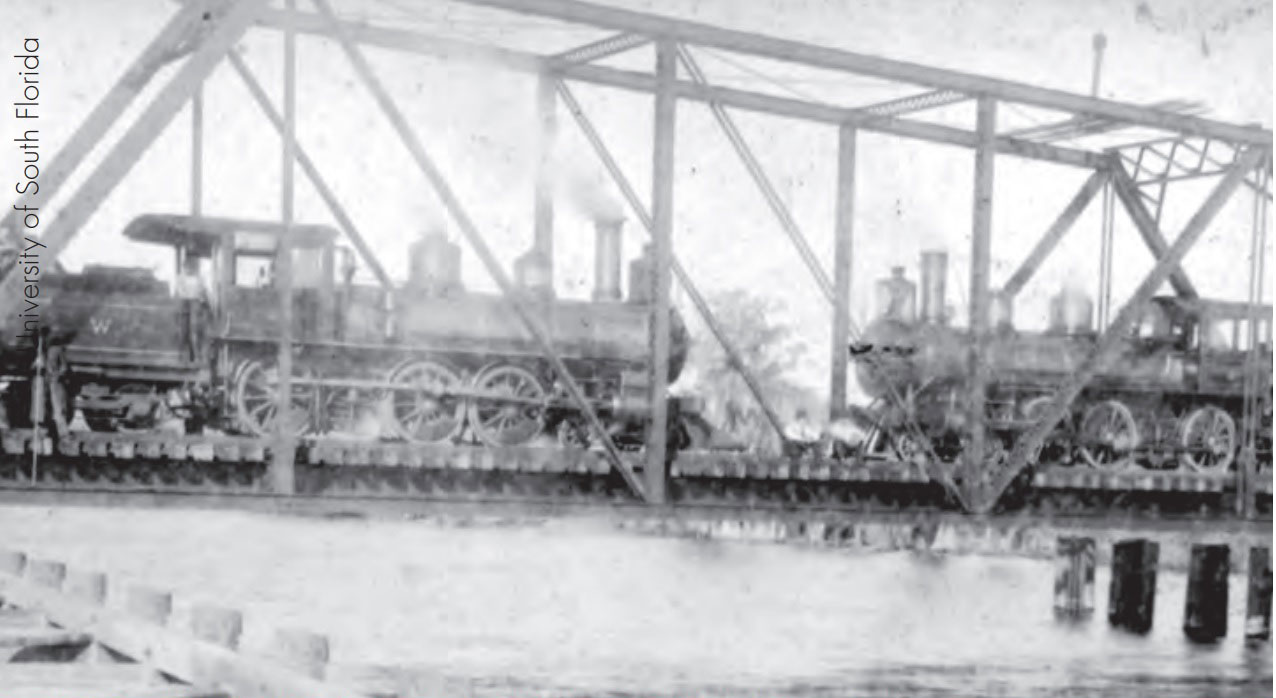
Two trains stopped on a trestle near the port of Tampa, c. 1898.
Under continuous pressure from Secretary Alger to maintain the pace and load the ships, Shafter relayed in his message on 4 June that he had encountered unforeseen delays due to units arriving late, track congestion, and a lack of facilities. He expressed his frustration at the small throughput capacity in Tampa and reaffirmed his efforts to sail as “early as practical.”97 Finally, the stevedores completed loading equipment at 1100 on 6 June and Shafter ordered that soldier embarkation begin at 1200.98
Both Colonel Humphrey and his assistant, Captain McKay, recalled the loading of the ships as a smooth, coordinated process. Humphrey claimed that it was “carried on speedily and systematically, and continued to completion without regard to hours or fatigue.”99 McKay also recollected the process as orderly and proceeding with no issues.100
However, soldiers’ accounts of the process were vastly different from those in charge at the port. The plan called for an orderly procession of units called forward. Trains were to arrive with troops and baggage together, and soldiers would report to Humphrey for their assigned ship. This process would maintain unit integrity and place the assigned units on the proper ships in accordance with manifests.101 In reality, however, the loading operation was much different. While the initial movement began in an orderly manner, it quickly deteriorated.
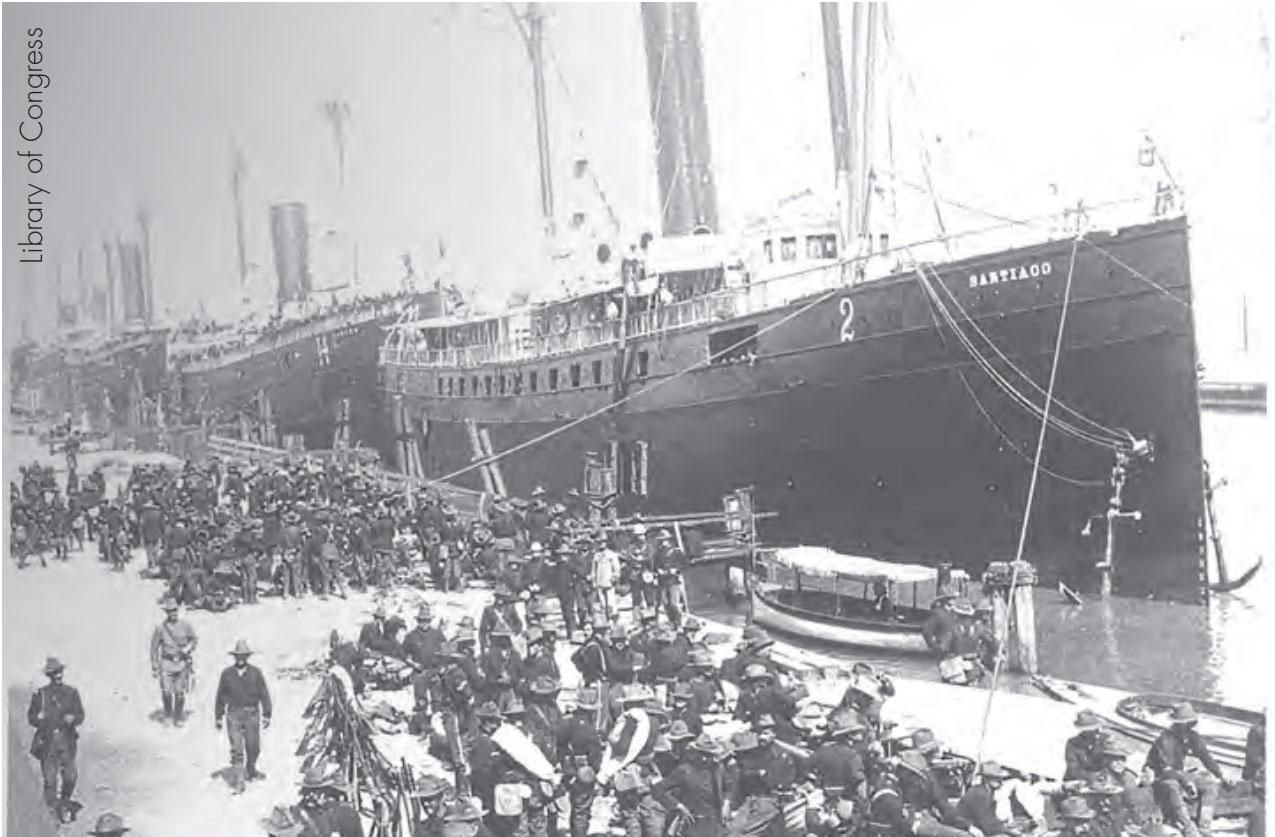
Troops prepare to board transport ships at the port of Tampa, 1898.
Soldiers initiated movement throughout the night of 6 June. Shafter reported his hopes to sail by 8 June.102 On the night of 7 June, Shafter received a telegram that the Navy had engaged the forts of Santiago and
If 10,000 men were here, city and fleet would be ours within forty-eight hours. Every consideration demands immediate army movement. If delayed, city will be defended more strongly by guns taken from fleet.103
With that telegram, Shafter’s staff notified the regimental commanders that those units not on ships by morning would remain behind. This order set off a frenzied rush to the ports. The headquarters staff evacuated the Tampa Bay Hotel to its train and found the rail lines congested and immobile.104
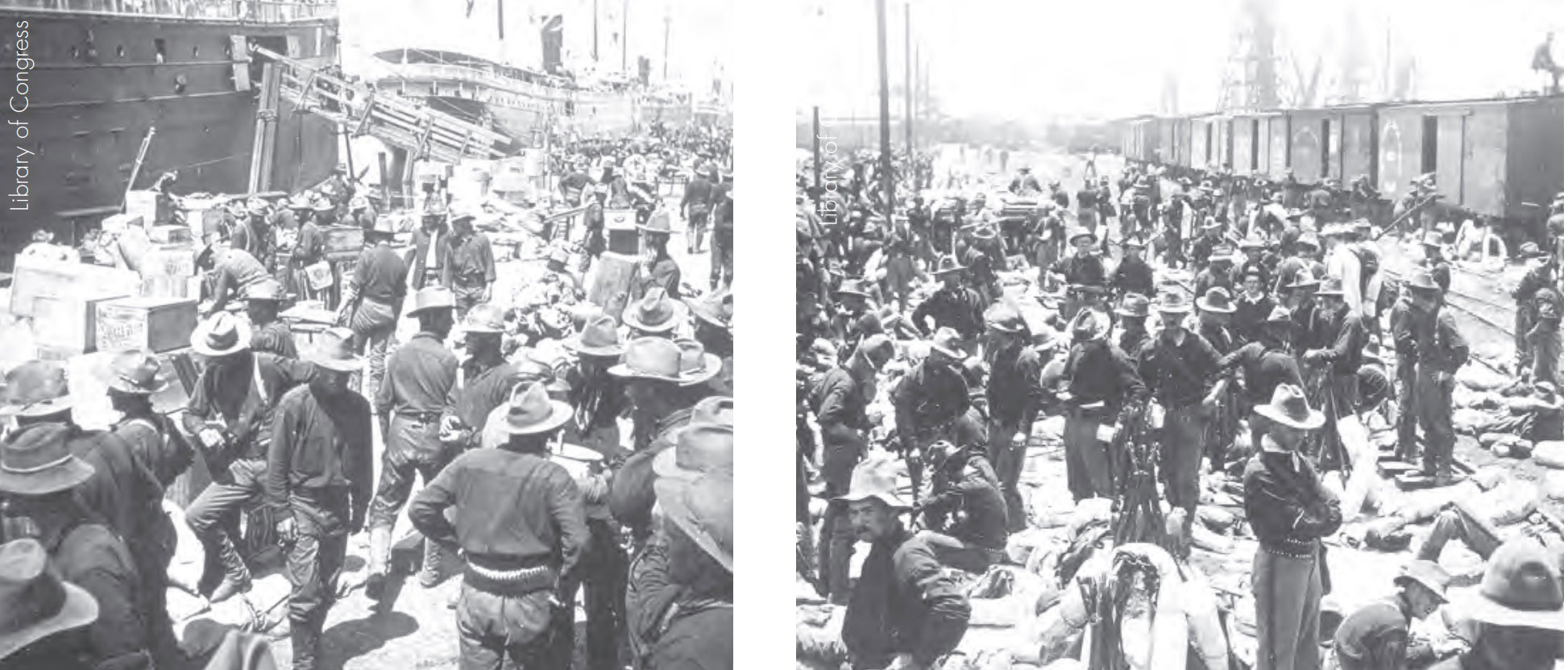
Image left: U.S. soldiers in Tampa await the order to board their assigned ships before sailing for Cuba, June 1898. Image right: Members of the 71st New York Volunteer Infantry gather on the dock in Tampa before sailing for Cuba, June 1898.
British war correspondent John Atkins heard the frantic order that “Those who are not aboard by daybreak will be left behind. Leave your tents standing.” He noted the contrast between the long wait in Tampa and the frenzied rush to the docks. Many units abandoned wagons and equipment that were never loaded.105 In the rush, units competed with one another by stealing the abandoned wagons, commandeering train cars, and even hijacking trains.106 One account from 2d Lt. Paul Malone of the 13th U.S. Infantry recounts his unit finding cattle cars with an attached train engine. After finding and rousting the train engineer, they traveled to the port.107
The 9th Infantry seized abandoned wagons and unoccupied freight trains. They interpreted the order as “you fight in Cuba only if you can get to the port and find a ship.”108
A soldier with the 71st New York Volunteer Infantry noted “that no one knew what boat you were going on, what time the boats would come to the pier, or anything else which a little system and some management might have provided.”109
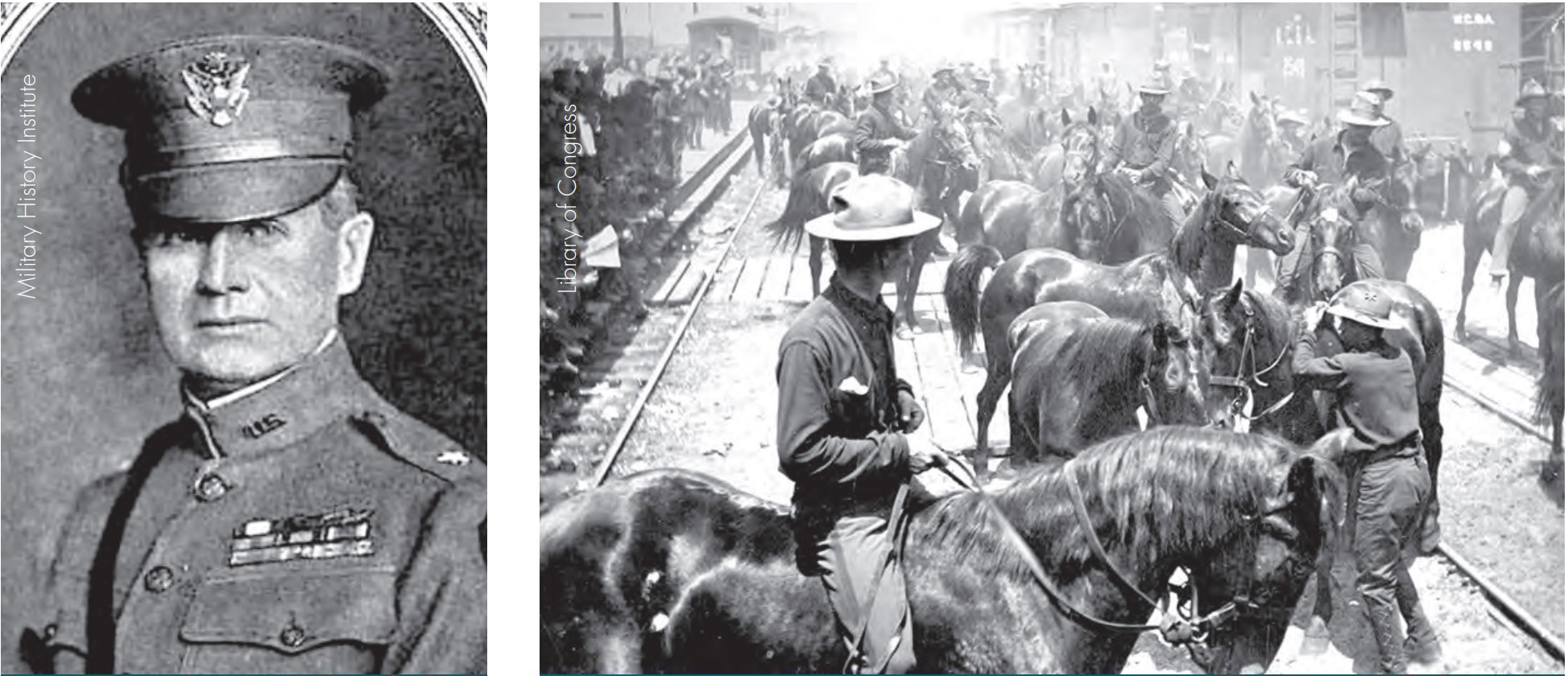
Image left: Paul Malone, pictured here as a brigadier general, c. 1918. Image right: Colonel Roosevelt’s “Rough Riders” arrive at the port of Tampa in June 1898.
Perhaps the most famous story came from Colonel Roosevelt when he described the eventful night as a “scramble.” The Rough Riders followed Shafter’s orders to proceed to the train station at midnight. When no train came for six hours, they seized an engine and some coal cars and backed down the track. Upon arrival to the port, the train dropped them off and the unit sought out Colonel Humphrey for vessel assignment.110 When they finally found him, Humphrey haphazardly assigned them to the Yucatan, previously allocated to the 2d Infantry Division, V Corps and the 71st New York. Roosevelt rushed his men on board faster than the other units and was confronted by Capt. Anthony Bleecker of the 71st New York.111 When asked to surrender the ship, Roosevelt reportedly replied, “Since we have the ship, I think we’ll keep it—much as I would like to oblige you.”112 The 71st spent the next two nights without a vessel, but Humphrey eventually assigned the unit to the Valencia, a newer and more comfortable ship.113 War correspondent George Musgrave noted,
With the capacity of each transport, and the roster of each regiment before him, the youngest officer could have made effective assignment and saved such dire confusion, which took two days to untangle, and entailed much sun exposure and hardship on the soldiers.114
The chaos in the port was influencing the war’s strategic objectives. The confusion caused delays in the timeline of departure, and the War Department felt they were missing their opportunity to win the war quickly and decisively. Shafter found out just prior to loading that there was not enough room for all of his 25,000 soldiers and their equipment.115 The newly converted freighters could not hold the anticipated capacity, even after exceeding the ships’ original capabilities. For example, the Cherokee was equipped for 570 men but carried 1,040.116 Supplies remained on the docks in unopened freight cars. The Gatling gun detachment did not sail due to the limited space.117 Upon assessing the capacity of the ships, Col. Wood received orders he could only take two of his three cavalry squadrons but no horses.118 Not only did the lack of basing facilities slow the tempo of operations, but also the lack of supplies and horses would limit the operational reach of the expedition. All of this notwithstanding, by 1400 on 8 June, most vessels departed the dock and were in position to leave the next morning.
Many authors have written about the Army’s failure to synchronize its movement in the mad dash to the port. This was a failure of command and organization. No one officer was in charge of calling forward troops or of the port’s synchronization. A single leader needed to arrange actions in time, space, and purpose to facilitate the continuous movement and maintain order at the port. The lack of personnel and resources dedicated strictly to deployment management prevented a timely flow of troops and equipment. The single-track line to the Port of Tampa exacerbated the situation by the Army’s reliance on the transportation provided by the Plant Company. The continuous flow of supplies to Tampa City from the rest of the country congested the rail line and disrupted the flow of resources. Logistics planners still had not solved this problem forty days into the operation. The poor transportation infrastructure affected the tempo of the operation creating a culmination point before the expedition was underway. In the postwar investigation, Humphrey testified that he did not know if the train congestion problem was ever unraveled. He also faulted the lack of loading order for the supplies and troops. Humphrey ordered units to load on a first-come, first-served basis, disrupting unit integrity of troops and equipment.119 The process in which Shafter himself telephoned or telegraphed the departing unit from Tampa on their way to the port was a reactive, unplanned process. Shafter simply failed to plan for the movement of 25,000 soldiers down a single railline.
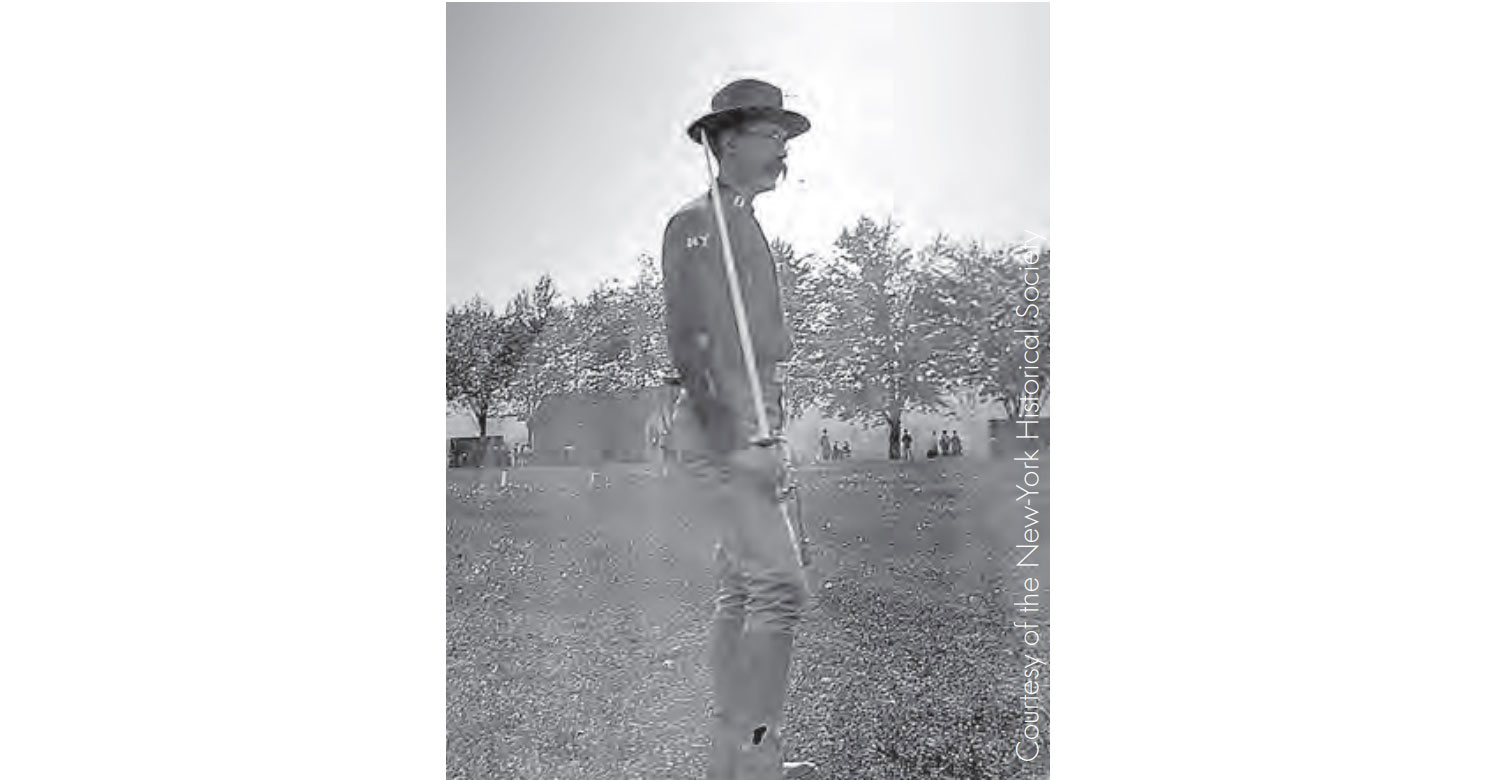
Captain Bleecker at the Creedmoor Rifle Range, Queens, New York, 24 May 1902.
Once the expedition was loaded, Shafter collapsed in exhaustion aboard his ship, the Seguranca, around 1400 on 8 June after having been awake for forty straight hours.120 Responding to the sudden timeline acceleration, he managed to get the bulk of his forces onto ships in a twenty-four hour period. However, an important message arrived from the secretary of war around 1400 stating, “Wait until you get further orders before you sail.”121 Shafter’s aide awakened the commander, who groggily stated that he would fix it in the morning. After Col. Edward McClernand awakened the general a second time to ask for compliance with the order, Shafter roused himself out of his sleep and stated, “God, I should say so,” and he recalled the vessels anchored in the harbor back to the port.122 The cause for the delay was the sighting of a Spanish armored cruiser and torpedo-boat destroyer reported near Nicolas Channel, a straight off the northwest coast of Cuba.123 Shafter immediately ensured all his ships were in the safety of the port under the watchful eye of supporting field guns and escort vessels at the bay’s entrance.124 The expeditionary force returned to its staging posture until further notice.
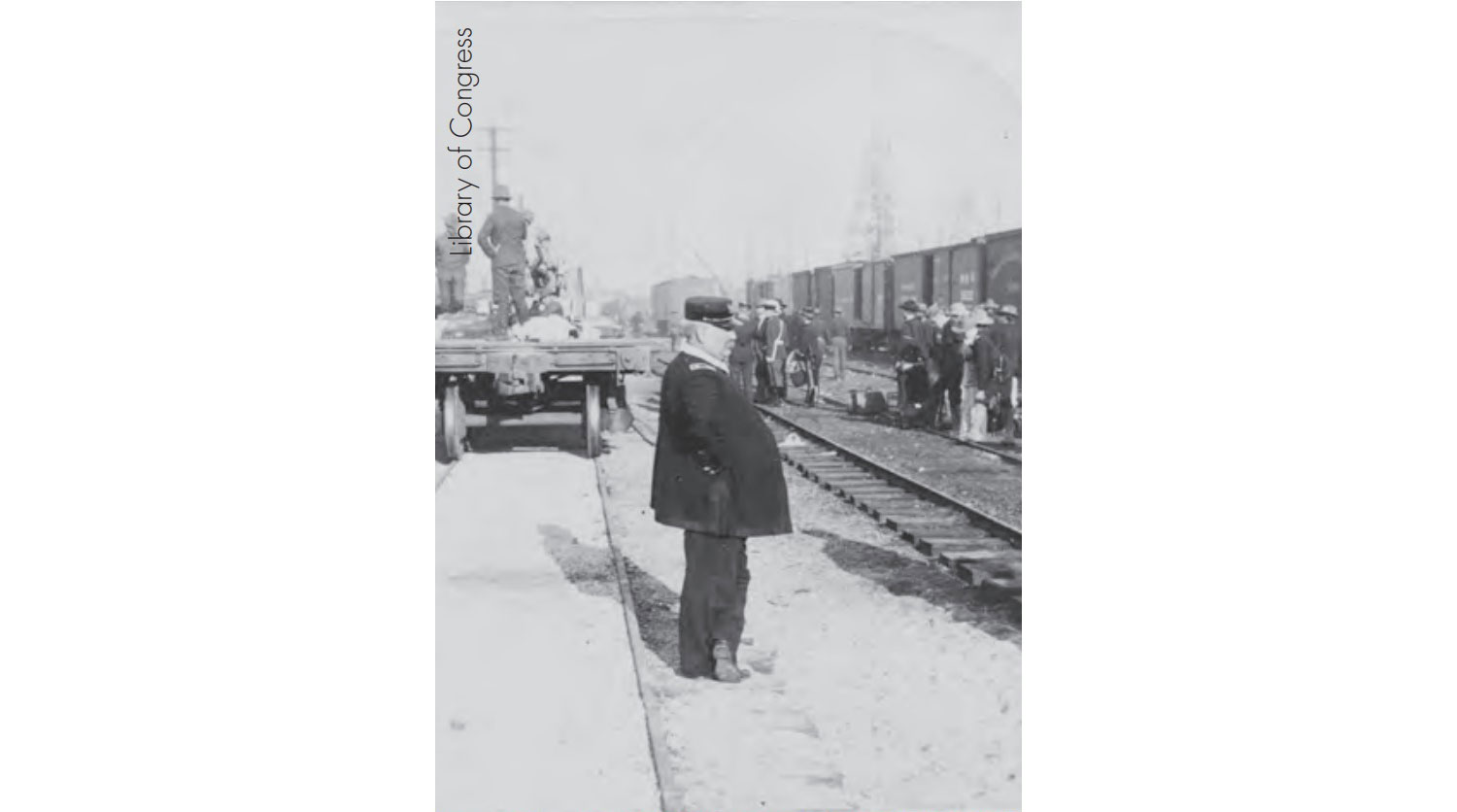
General Shafter observes the unloading of railcars in Tampa.
Shafter decided to house his men aboard the ships in their hot, unventilated compartments to maintain readiness in preparation for the orders to depart. However, construction teams did not build sufficient living facilities onboard the ships to support more than a short journey to Cuba, and the nearest place to camp was back in Tampa, nine miles away. The units unloaded the animals and issued limited passes to the soldiers to disembark the vessels. The soldiers were required to be aboard ship no later than 2100 every night. They also had the option of bathing in the bay.125
From Private Post’s perspective, the conditions were less than ideal. The beds contained only twentyfour inches width of sleeping space. The food on his ship, the Valencia, consisted of corned beef with hardtack cooked on a steam pipe from the engine room. The drinking water was “sluggish fluid mixed with particles of charcoal for health’s sake. It looked like muddy glycerine and tasted like bilgewater.” Aboard the vessels, the men were completely without purpose. Units conducted some landing drills on empty beaches, but even these turned into an excuse to swim. Very few soldiers ventured into town for fear of missing the expedition. This kept alcohol consumption to a minimum for most of the troops, an unintended benefit. The temporary hold, however, created two advantages. The long awaited medical supplies finally arrived, and stevedores loaded them aboard the ships. More importantly, the expedition was actually ready to sail at a moment’s notice.126
On 12 June, after three days of waiting, the War Department issued orders to sail the following day. This time there was no transportation nightmare in loading the ships. The logistics party refueled the ships with coal and water, hoisted the animals on board, and continued loading supplies as the ships individually departed.127 On 13 June, two months after the first units had arrived in Tampa, the ships steamed out of the bay heading for Cuba.
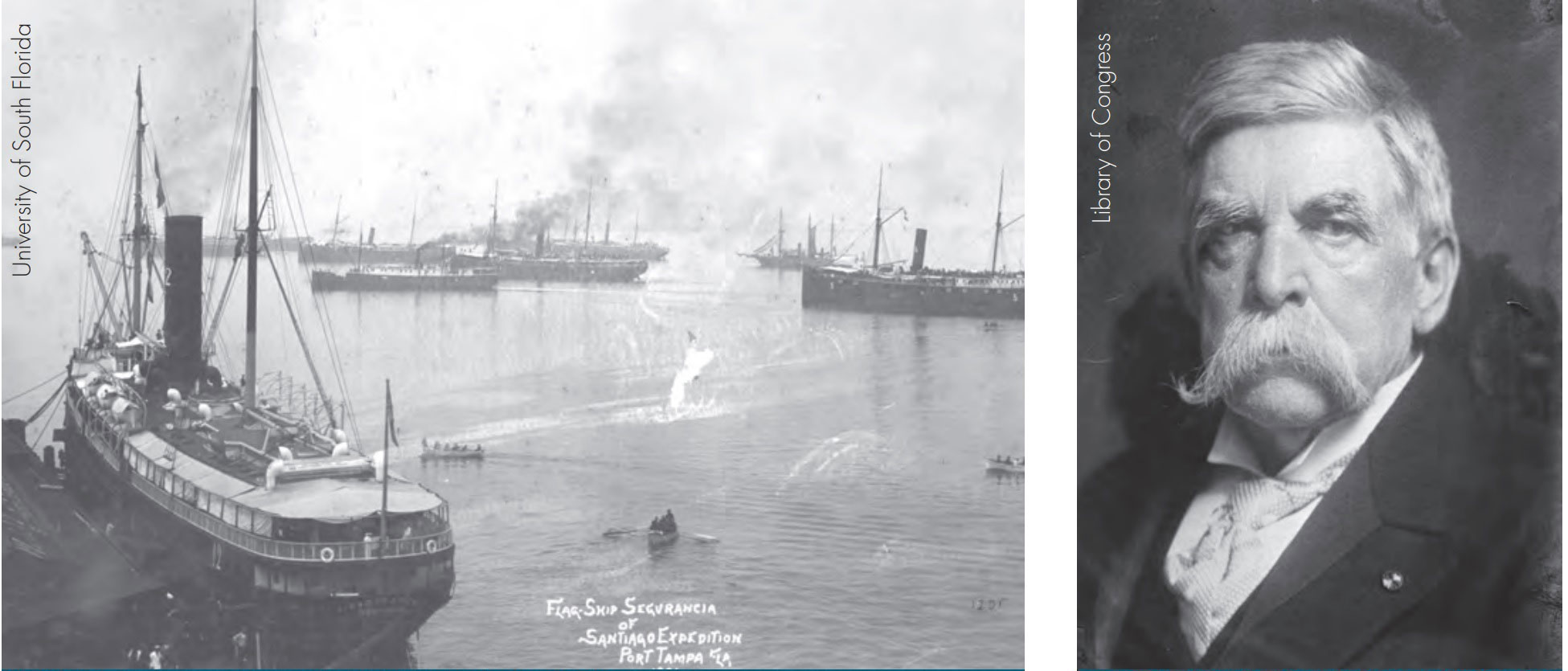
Image left: The expedition flagship Seguranca at the pier in Tampa before departing for Cuba. Image right: Grenville Dodge, c. 1900.
After the Spanish-American War’s conclusion, public criticism erupted over the lack of medical support during the conflict. The press directed its outrage at what it deemed criminal neglect in camps, hospitals, and during transit. President McKinley, sensing political pressure, appointed retired major general Grenville Dodge to chair a commission that would come to bear his name. The Dodge Commission conducted its investigation between 26 September 1898 and 9 February 1899.128 The report produced by the commission, which included interviews with eyewitnesses and firsthand accounts, provided valuable insight into the logistical process and problems encountered at Tampa.
Conclusions from the report noted four major deficiencies related to the deployment operation. First, the Army effectively staffed the quartermaster department to support an army of peacetime proportions, not a force exceeding 25,000. Second, the congestion at Tampa was due to the lack of administrative oversight in the quartermaster and railroad sections. Third, there was a total failure of planning for ship transport capacity that decreased the fighting force by 8,000 soldiers and its ambulance carrying capability. Finally, there needed to be a division of labor between the quartermaster and transportation departments instead of both working similar issues simultaneously.129
Implications for World War I Operations
The lessons learned from the failures of this deployment impacted future operations. The Army had failed to establish adequate basing, its operational reach was hampered by logistical and transport problems, and its tempo was disrupted by a lack of command oversight on the docks, as well as by conflicting and confusing orders—all of which were detrimental to the mobilization process. These deficiencies were corrected and the deployment process improved at debarkation points in New York City, and elsewhere, during World War I.
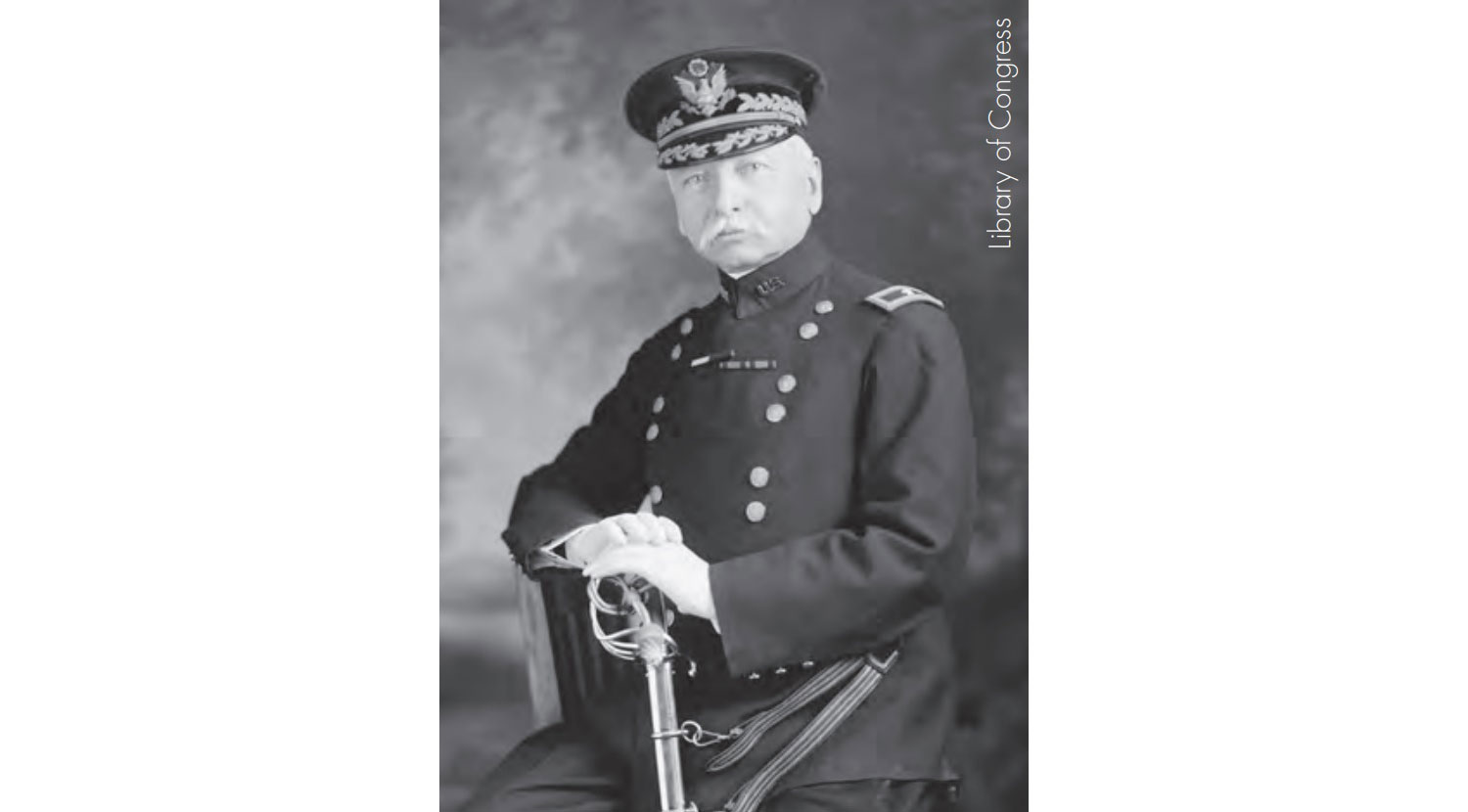
Edward McClernand, pictured here as a brigadier general, c. 1912.
Base selection is critical to support contemporary deployments. The War Department chose Tampa because of its proximity to Cuba and because it met the minimum logistical requirements, including two railroad tracks entering the town, a port that could hold a small number of ships, and a projected water supply for the soldiers. Even t houg h Ta mpa had met t hese minimum requirements, there was not enough additional planning for the needs of 25,000 incoming troops. World War I planners understood the limitations of a port like Tampa and chose the Port of New York as the embarkation facility. The port in New York was one of the largest in the world and possessed more than ample facilities—railroads, docks, housing, food and water supplies—to mobilize millions of soldiers. The port could expand as needed to meet increased requirements, unlike Tampa’s inability to grow effectively.
Unity of command is a principle critical to managing throughput of basing operations. A single commander for the logistics aspect of deployment allows solitary focus on controlling and operating port deployments. This commander has the ability to adjust resources as necessary, control movements in the deployment area, and arrange support for units in transition.130 In Tampa, there was no single commander for the deployment operation. General Shafter was responsible for the overall operation, but at no time over the forty-day period did he take control of the process to relieve the congestion. Colonel Humphrey was responsible for the staging and loading of supplies along with the arrangement of soldiers on transports once called forward. However, his responsibility was limited to the port area. Then—2d Infantry Division commander and future Brig. Gen. Arthur Wagner stated in his memoirs that the expedition commander shou ld have granted authority to a single officer and charged him with the loading process.131 At no time was there a single point of contact for the deployment process to task and shift resources for alleviating congestion.
The Port of New York in World War I was vastly different. Unity of command was assigned to ports, ensuring that resources could be adequately allocated. Maj. Gen. J. Franklin Bell commanded the New York port of embarkation and managed all movement through the port.132 American planners understood that “adequate and clear lines of communications were critical to organizing and sustaining large-unit operations.”133 Bell used his command authority and robust staff to manage port flow. This unity of command stands in contrast to Shafter’s leadership—he lacked the institutional knowledge to assign a deployment commander with a large enough staff to manage port operations.
Military planners traditionally associate the tempo of operations to combat-related activities. However, efficient and effective mobilization of units requires a steady pace and rhythm to bring soldiers into combat at their optimal performance. Tampa demonstrated tempo with varying peaks and valleys. Initially, the War Department sent 5,000 soldiers to Cuba to support the insurgency, followed by a forty-day lull while troops mustered in Florida. Shafter ordered a mad dash to the transports only to wait for three days in miserable conditions aboard hot, cramped vessels. This entire process contributed to a degraded fighting force. The deployment process at Tampa diminished combat preparedness, and the force did not arrive in Cuba in an optimal state of readiness.
The pace of deployment is maintained through the Army adage, “slow is smooth, and smooth is fast.” This momentum can be facilitated using synchronization, which manages the timing of supply in the correct order and coordinates with supporting activities “to ensure the tempo of deployment is uninterrupted.”134 Soldiers at the Port of New York performed synchronization activities admirably after recognizing a train congestion issue that clogged the ports. The decentralized system of railroad transportation created a backlog of railcars leading into New York.135 However, the government established the Shipping Control Committee in February 1918, which organized a single system to coordinate the flow from unit mobilization stations to the Port of New York, to transport overseas, and finally onto the French ports. The Operations Division in Washington performed synchronization oversight coordinating with the Railroad Administration, the Port of New York, the U.S. Navy, and the British Ministry of Shipping. The detailed planning synchronized the flow of movement in direct contrast to the activities in Tampa. New York was not without its difficulties and failings, as machinery breakdowns, labor disputes, and fuel shortages often delayed sailings and disrupted the massive mobilization. However, the New York operation managed to move almost one hundred times the number of men as the Army did in Tampa, and with far fewer issues.136
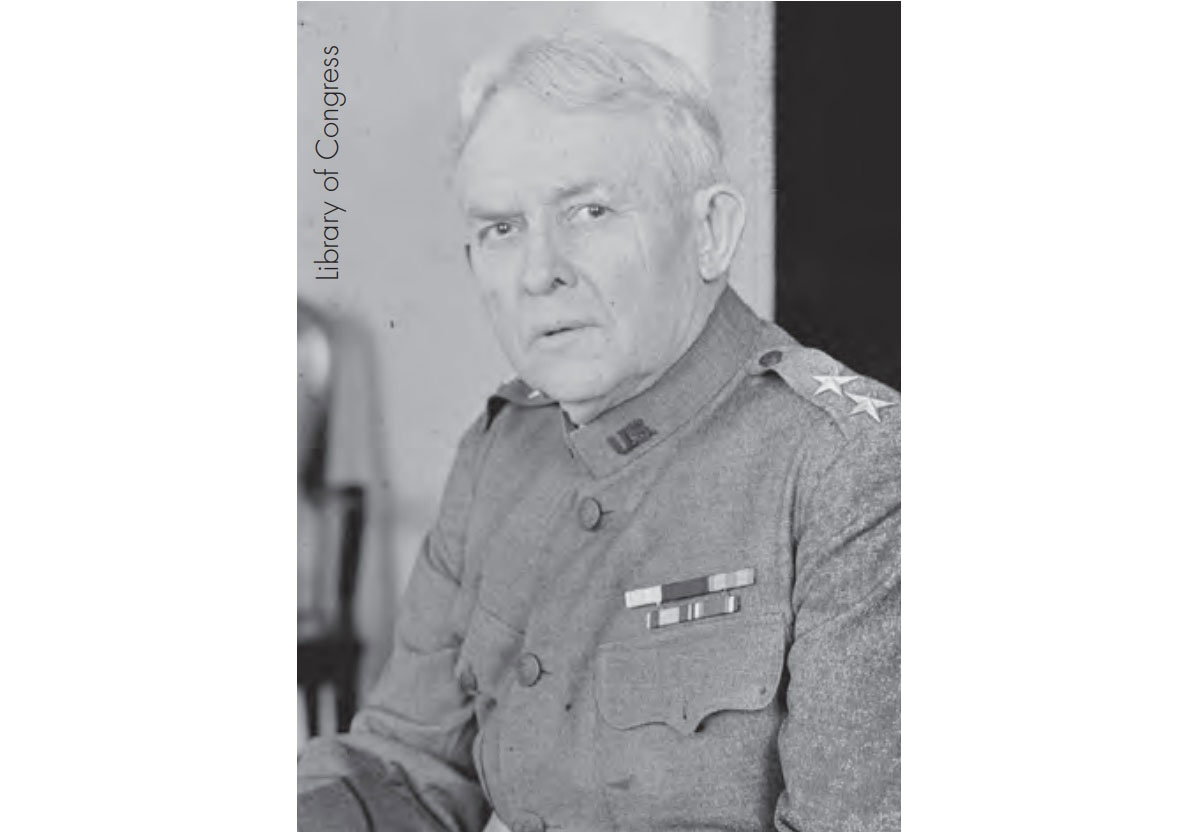
Library of Congress General Bell, c. 1917
Operational reach and tempo are mutually supportive and stem from establishing proper basing at the beginning of operations. Basing establishes the operational reach for follow-on missions. Planners originally designated Tampa as a temporary port facility established for the rapid deployment of soldiers to Cuba. However, the mission evolved, and 25,000 troops mobilized and reported to Tampa without the required sustainment resources on-site. This created two single points of failure: rail capacity and sea transportation. The lack of rail capacity disrupted momentum in loading the vessels. Congestion led to confusion with assembling rations and field guns for eventual deployment. The shortage of vessels created a storage capacity problem and reduced the number of soldiers able to depart on the expedition. These shortfalls resulted in the inability to transport all combat power, leaving 8,000 soldiers and important supplies, such as ambulances and cavalry horses, on the docks. These two assets were crucial to maintaining momentum.
Unit integrity is the movement of soldiers and associated equipment together on a common platform to simplify the deployment process, leverage the chain of command, and increase training opportunities. While the intent in Tampa was to keep units together, they arrived at the ports with directions to board ships assigned to other units. The lack of understanding of vessel capacity and capability unnecessarily separated units from their equipment. Most notably, the cavalry sailed to Cuba without its horses and fought as infantrymen, and the medical soldiers sailed on different vessels than did their ambulances. In World War I, the Army solved unit integrity issues during the troop movement phase by issuing soldiers equipment in New York and having them carry it directly aboard the ships. This eliminated the task of loading gear at home station and tracking it throughout the process. Supply activities consisted of 138 warehouses with ample supply of materiel to issue transitioning soldiers.137
Balance ensures the correct support system is in place to process deploying units, thereby extending operational reach.138 An excess of sustainers creates confusion while a shortage creates backlogs in the system. Colonel Humphrey was not only in charge of the quartermaster department at Tampa, but assigned as the chief quartermaster of the expedition. In his testimony, Humphrey stated, “I did not see how I could perform the duties, as I was there on other business.”139 There was no dedicated staff, other than the hired stevedores, to facilitate onward movement and extend operational reach. The result was that Tampa became a port of ineffectiveness once the ships sailed. The remaining supplies, food stocks, horses, and ambulances did not rejoin the expedition. The second compounding factor was that the privatized railroad eliminated all balance from military mobilization. Without control and synchronization of the railroads, the expedition relied on the Plant Company to transport freight and passengers the final nine miles to the port, an arrangement that was detrimental to the mobilization effort.
In 1918, the Army solved these problems by dedicating support infrastructure solely to the deployment process. The Port of New York had more than 2,500 officers assigned whose mission was to facilitate the movement of forces.140 The federal government mitigated rail congestion by seizing the railroad infrastructure under the National Defense Act of 1916 along with taking over the North-German Lloyd and HamburgAmerican Steamship companies.141 Federalized control of transportation assets eliminated friction between civilian and government agencies.
Conclusion
The Spanish-American War required an immediate mobilization of men and equipment. The original plan of sending 5,000 troops through Tampa escalated quickly to 25,000 men as strategic objectives shifted from supporting insurgents to fighting a full-fledged war against the Spanish in Cuba. Clausewitz states that an army “remains dependent on its sources of supply and replenishment,” that bases “constitute the basis of its existence and survival,” and that the “army and base must be conceived as a single whole.”142
Operations in Tampa failed to connect the strategic with the tactical actions of sustainment in three areas: basing, tempo, and operational reach.
Clausewitz posits, “No one starts a war . . . without first being clear in his mind what he intends to achieve by that war and how he intends to conduct it. The former is the political purpose; the latter its operational objective.” This principle establishes the course of the war in “scale of means and effort” that influences an operation “down to the smallest operational detail.”143 Clausewitz argued for clear war plans, a reasoning that permeates into the logistics of supplying and transporting an army into theater to meet political objectives by linking tactical actions. He asserts that maintenance and supply are critical to sustaining an army. He contends that subsistence by means of depots is one of four ways to provide for a force, and the base of operations is critical to its survival.144 This is a holistic approach to sustaining the operational reach and tempo. The flow of men and equipment to the field of battle is paramount, and “one must never forget that it is among those that take the time to produce a decisive effect.”145 Clausewitz understood the importance of sustainment as laying the foundation for the political and military end state.
The failure to link strategic and tactical goals, the changing guidance from the War Department, and insufficient resources to maintain deployment momentum created unnecessary disruptions to operational capabilities. By 1918, the evolution of planning and executing mobilizations saw great gains in synchronizing and integrating unit flow from home station to France. This was due to having a single commander in New York and supporting forces with the sole mission of deploying units through the port. The War Department learned to oversee holistic transportation plans through rail, port, and sea, resulting in massive numbers of soldiers, along with all supporting materiel, being successfully moved around the country and deployed overseas.146
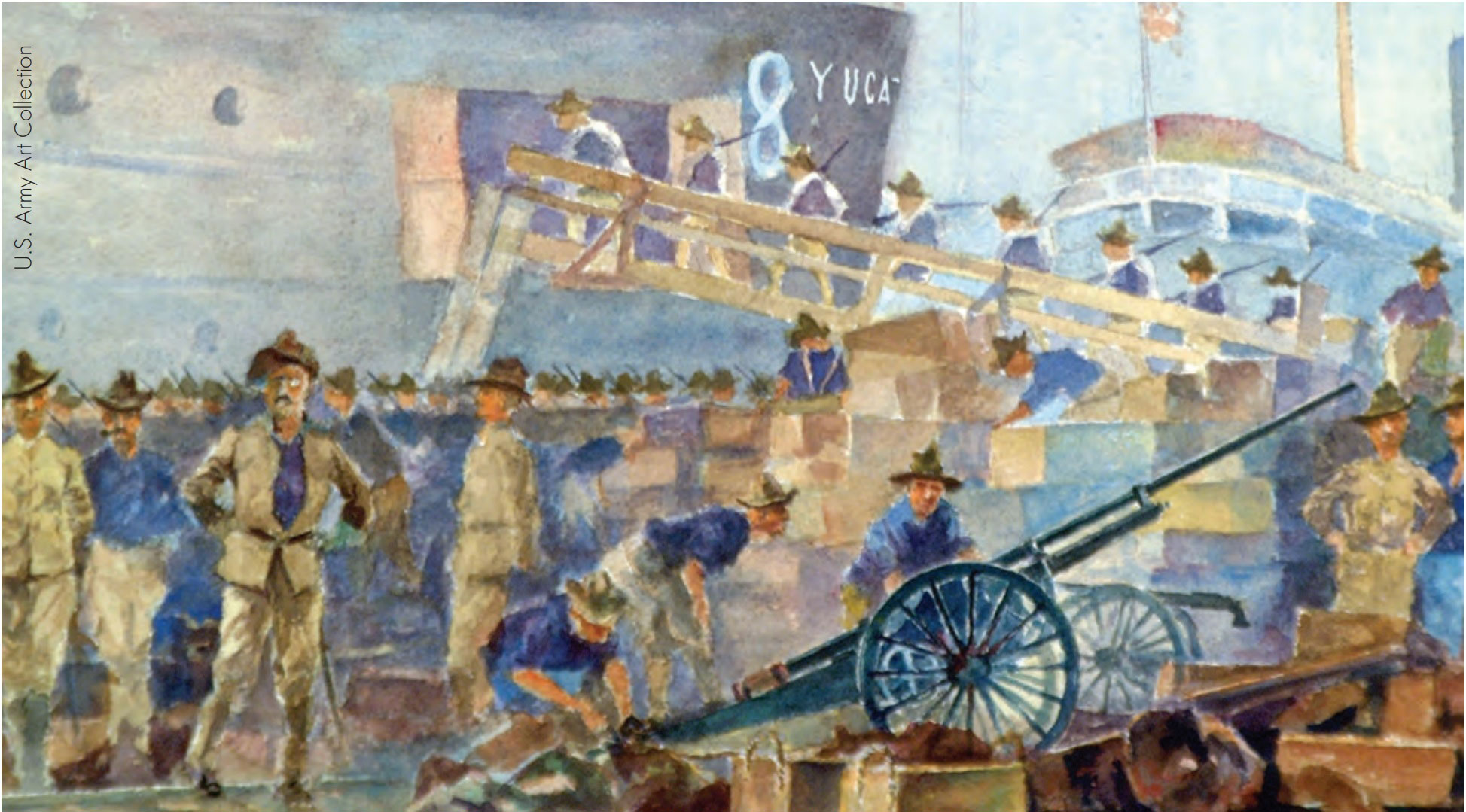
Charles Johnson Post, Embarking for Cuba, Port Tampa, Florida, June 1898
The movement of troops and equipment from countless locations within the country to a central port of embarkation was required for follow-on movement to the war zone. New York City was the primary hub for overseas transit to France. Created in 1917, the Embarkation Service was the central organization tasked with overseeing all ports of departure in the United States. The New York port of embarkation employed 2,500 officers working in various roles at piers, staging camps, and hospitals. New York Harbor and its subports deployed 1,798,000 soldiers by the war’s end—with a peak of 51,000 troops dispatched overseas in one day—which exceeded all previous single-port records.147
Commanded by General Bell, the New York Port of Embarkation controlled movement operations as a single system, flowing a total of 5,130,000 tons of equipment through Armistice Day.148 In comparison to deployment operations in Tampa, the ports of New York were a model of efficiency and control during World War I.
Author’s Note The author would like to extend special thanks to Dr. Ricardo Herrera, who was instrumental during the writing process and encouraged the author to submit this article for publication.
Footnotes
1 Army Doctrine Reference Publication (ADRP) 3–0 discusses ten elements of operational art. Basing, tempo, and operational reach are all critical to pursuing “strategic objectives, in whole or in part, through the arrangement of tactical actions in time, space, and purpose.” ADRP 3–0, Unified Land Operations (Washington, D.C.: Government Printing Office, 2012), pp. 4-1–4-3.
2 Field Manual (FM) 3–35 states that reception, staging, onward movement, and integration “is designed to rapidly combine and integrate arriving elements of personnel, equipment, and materiel into combat power that can be employed by the combatant commander.” Moreover, four principles underpin the reception, staging, onward movement, and integration (RSOI) process: unity of command, synchronization, unit integrity, and balance. FM 3–35, Army Deployment and Redeployment (Washington, D.C.: Government Printing Office, 2010), pp. 4-1–4-2.
3Walter Millis, The Martial Spirit: A Study of Our War with Spain (Boston, Mass.: Riverside Press, 1931), pp. 1–31. See John Lawrence Tone, War and Genocide in Cuba, 1895–1898 (Chapel Hill: University of North Carolina Press, 2008) on the Spanish policy of reconcentration and prosecution of the war against Cuban insurgents.
4 G. J. A. O’Toole, The Spanish American War (New York: W. W. Norton, 1984), p. 20.
5 O’Toole, The Spanish American War, pp. 20–21.
6 Millis, The Martial Spirit, pp. 116–17.
7 John M. Thurston, “Senate Speech March 24, 1898,” in Patriotic Eloquence Relating to the Spanish-American War and Its Issues, ed. Robert Fulton and Thomas Trueblood (New York: Charles Scribner’s Sons, 1903), pp. 304–08.
8 Richard Titherington, A History of the Spanish American War of 1898 (New York: D. Appleton, 1900), p. 105.
9 Frank Freidel, The Splendid Little War (Boston, Mass.: Little, Brown and Company, 1958), p. 38.
10 A. C. M. Azoy, CHARGE! The Story of the Battle of San Juan Hill (New York: Longman’s, Green and Company, 1961), p. 38.
11 Freidel, The Splendid Little War, p. 60.
12 Graham A. Cosmas, An Army for Empire: The United States Army in the Spanish-American War (Columbia: University of Missouri Press, 1971), p. 187.
13 Edward J. McClernand, “The Santiago Campaign,” in The Santiago Campaign, ed. Joseph T. Dickman (Richmond, Va.: Williams Printing Company, 1927), p. 3.
14 Kenneth E. Hendrickson, The Spanish-American War (Westport, Conn.: Greenwood, 2003), p. 10.
15 Cosmas, An Army for Empire, p. 187.
16 Russell A. Alger, The Spanish-American War (New York: Harper & Brothers, 1901), p. 65.
17 Ibid., p. 69.
18 FM 3–35 states reception, staging, and onward movement are designed “to rapidly combine and integrate arriving elements of personnel, equipment, and materiel into combat power that can be employed by the combatant commander.” FM 3–35, Army Deployment and Redeployment, p. 4-1.
19 ADRP 3–0 defines tempo as “the relative speed and rhythm of military operations over time with respect to the enemy.” ADRP 3–0, Unified Land Operations, pp. 4–7.
20 ADRP 3–0 defines operational reach as “the distance and duration across which a joint force can successfully employ military capabilities.” This element of operational art relates to the ability to “create, protect, and sustain a force. Ibid., pp. 4–5.
21 Carl von Clausewitz, On War, trans. and ed. Michael Howard and Peter Paret (Princeton, N.J.: Princeton University Press, 1984), pp. 343–44.
22 Cosmas, An Army for Empire, p. 126.
23 Hendrickson, The Spanish-American War, p. 28.
24 Herbert H. Sargent, The Campaign of Santiago de Cuba, vol. 1 (Cambridge, Mass.: Harvard University Press, 1907), p. 108.
25 Ibid., pp. 89–90.
26 Ibid., p. 114.
27 Correspondence Relating to the War with Spain, Vol. 1 (Washington, D.C.: Government Printing Office, 1902), p. 9.
28 Cosmas, An Army for Empire, p. 194.
29 Wayne H. Morgan, America’s Road to Empire: The War with Spain and Overseas Expansion (1965; repr., New York: John Wiley and Sons, 1966), p. 71.
30 Cosmas, An Army for Empire, p. 194.
31 James A. Huston, The Sinews of War: Army Logistics, 1775–1953 (Washington, D.C.: Center of Military History, 1997), p. 280.
32 John D. Miley, In Cuba with Shafter (New York: Charles Scribner’s Sons, 1899), pp. 1–4.
33 Huston, The Sinews of War, p. 280.
34 Report of the Commission Appointed by the President to Investigate the Conduct of the War Department with Spain, 56th Cong., 1st sess., 1900, S. Doc. 221, vol. 7, p. 3638.
35 Miley, In Cuba with Shafter, pp. 9–10.
36 FM 3–35 defines the reception process as “unloading personnel and equipment from strategic transport assets, managing port marshalling areas, transporting personnel, equipment, and materiel to staging areas, and providing logistics support services to units transiting the port of debarkation.” FM 3–35, Army Deployment and Redeployment, p. 4-1.
37 Millis, The Martial Spirit, p. 241.
38 Cosmas, An Army for Empire, p. 195.
39 Ibid., pp. 170–71.
40 Charles Johnson Post, The Little War of Private Post (Boston, Mass.: Little, Brown and Company, 1960), pp. 68–69.
41 Dale L. Walker, The Boys of ‘98: Theodore Roosevelt and the Rough Riders (New York: Tom Doherty Associates, 1998), p. 143.
42 Theodore Roosevelt, The Rough Riders (1899; repr., Williamstown, Mass.: Corner House, 1979), pp. 53–54.
43 David F. Trask, The War with Spain in 1898, (New York: Macmillan, 1981), p. 184.
44 Joseph Wheeler, The Santiago Campaign 1898 (Boston, Mass.: Rockwell and Church, 1898), pp. 5–6.
45 Charles H. Brown, Correspondents’ War (New York: Charles Scribner’s Sons, 1967), p. 212.
46 Miley, In Cuba with Shafter, p. 11.
47 Cosmas, An Army for Empire, pp. 130–31.
48 Huston, The Sinews of War, p. 280.
49 Alger, The Spanish-American War, p. 65.
50 Freidel, The Splendid Little War, p. 60.
51 Cosmas, An Army for Empire, p. 195.
52 Huston, The Sinews of War, p. 281.
53 Cosmas, An Army for Empire, p. 195.
54 David Rutenberg and Jane Allen, eds., The Logistics of Waging War: American Logistics 1774–1985, Emphasizing the Development of Airpower (Gunter Air Force Station, Ala.: Air Force Logistics Management Center, 1985), p. 49.
55 Huston, The Sinews of War, p. 281.
56 FM 3–35 defines the staging process as “organizing personnel, equipment, and basic loads into movement units; preparing the units for onward movement; and providing logistics support for units transiting the staging area.” FM 3–35, Army Deployment and Redeployment, p. 4-1.
57 Thomas J. Vivian, The Fall of Santiago (New York: R. F. Fenno, 1898), p. 74.
58 Sargent, The Campaign of Santiago de Cuba, pp. 112–23.
59 Morgan, America’s Road to Empire, p. 70.
60 Cosmas, An Army for Empire, p. 129.
61 Huston, The Sinews of War, p. 283.
62 Brown, Correspondents’ War, p. 271.
63 Dwight E. Aultman, “Personal Recollections of the Artillery at Santiago, 1898,” in The Santiago Campaign, ed. Joseph T. Dickman (Richmond, Va.: Williams Printing Company, 1927), p. 184.
64 Huston, The Sinews of War, p. 279.
65 Alger, The Spanish-American War, p. 74.
66 Cosmas, An Army for Empire, p. 197.
67 C. D. Rhodes, “The Diary of a Lieutenant,” in The Santiago Campaign, ed. Joseph T. Dickman (Richmond, Va.: Williams Printing Company, 1927), p. 335.
68 B. T. Simmons and E. R. Chrisman, “The Sixth and Sixteenth Regiments of Infantry,” in The Santiago Campaign, ed. Joseph T. Dickman (Richmond, Va.: Williams Printing Company, 1927), p. 68.
69 Huston, The Sinews of War, p. 282.
70 Harvey Rosenfeld, The Diary of a Dirty Little War: The Spanish-American War of 1898 (Westport, Conn.: Praeger, 2000), p. 94.
71 Trask, The War with Spain, p. 182.
72 John Black Atkins, The War in Cuba: The Experiences of an Englishman with the United States Army (London: Smith, Elder & Co., 1899), p. 51.
73 Rosenfeld, The Diary of a Dirty Little War, p. 85.
74 Huston, The Sinews of War, p. 279.
75 Rosenfeld, The Diary of a Dirty Little War, p. 96.
76 Huston, The Sinews of War, p. 279.
77 Valery Havard, “The Medical Corps at Santiago,” in The Santiago Campaign, ed. Joseph T. Dickman (Richmond, Va.: Williams Printing Company, 1927), p. 207.
78 Trask, The War with Spain, pp. 160–61.
79 Rosenfeld, The Diary of a Dirty Little War, p. 99.
80 Walker, The Boys of ‘98, p. 138.
81 Cosmas, An Army for Empire, pp. 169–72.
82 Rosenfeld, The Diary of a Dirty Little War, p. 94.
83 Walker, The Boys of ‘98, p. 140.
84 A. B. Feuer, The Santiago Campaign of 1898: A Soldier’s View of the SpanishAmerican War (Westport, Conn.: Praeger, 1993), pp. 15–16.
85 Post, The Little War of Private Post, p. 71.
86 Freidel, The Splendid Little War, p. 40.
87 Roosevelt, The Rough Riders, p. 55
88 Walker, The Boys of ‘98, p. 137.
89 FM 3–35 defines onward movement as “moving units from reception facilities and staging areas to tactical assembly areas or other theater destinations; moving non-unit personnel to gaining commands; and moving sustainment supplies to distribution sites.” FM 3–35, Army Deployment and Redeployment, p. 4-1.
90 Miley, In Cuba with Shafter, pp. 15–16.
91 Correspondence Relating to the War with Spain, p. 16.
92 Miley, In Cuba with Shafter, p. 18.
93 Ibid., pp. 19–23.
94 Huston, The Sinews of War, p. 282.
95 Freidel, The Splendid Little War, p. 60.
96 Miley, In Cuba with Shafter, pp. 23–24.
97 Correspondence Relating to the War with Spain, p. 25.
98 Huston, The Sinews of War, p. 283.
99 Charles F. Humphrey, “The Quartermaster’s Department at Santiago de Cuba,” in The Santiago Campaign, ed. Joseph T. Dickman (Richmond, Va.: Williams Printing Company, 1927), p. 196.
100 Report of the Commission, vol. 6, pp. 2,655–2,678.
101 Miley, In Cuba with Shafter, p. 25.
102 Correspondence Relating to the War with Spain, p. 28.
103Ibid., pp. 29–30.
104 Miley, In Cuba with Shafter, p. 32.
105 Atkins, The War in Cuba, pp. 63–69.
106 Hendrickson, The Spanish-American War, p. 30.
107 Paul B. Malone, “The Thirteenth U. S. Infantry in the Santiago Campaign,” in The Santiago Campaign, ed. Joseph T. Dickman (Richmond, Va.: Williams Printing Company, 1927), pp. 92–93.
108 Edwin V. Bookmiller, “The Ninth U. S. Infantry,” in The Santiago Campaign, ed. Joseph T. Dickman (Richmond, Va.: Williams Printing Company, 1927), p. 60.
109 George R. Van Dewater, “The Seventy First Regiment, New York Volunteers at Santiago de Cuba,” in The Santiago Campaign, ed. Joseph T. Dickman (Richmond, Va.: Williams Printing Company, 1927), p. 129.
110 Roosevelt, The Rough Riders, pp. 55–59.
111 Freidel, The Splendid Little War, pp. 67–68.
112 Feuer, The Santiago Campaign, pp. 16–17.
113 Freidel, The Splendid Little War, pp. 67–68.
114 George C. Musgrave, Under Three Flags in Cuba: A Personal Account of the Cuban Insurrection and Spanish-American War (Boston, Mass.: Little, Brown and Company, 1899), p. 260.
115 Cosmas, An Army for Empire, p. 196.
116 Rhodes, The Santiago Campaign, p. 335.
117 Azoy, CHARGE!, pp. 55–57.
118 Walker, The Boys of ‘98, p. 143.
119 Report of the Commission, vol. 7, pp. 3,639–3,652.
120 McClernand, The Santiago Campaign, p. 6.
121 Correspondence Relating to the War with Spain, p. 31.
122 McClernand, The Santiago Campaign, p. 6.
123 Correspondence Relating to the War with Spain, p. 31.
124 Miley, In Cuba with Shafter, pp. 34–35.
125 Ibid., pp. 34–37.
126 Post, The Little War of Private Post, pp. 77–93.
127 Miley, In Cuba with Shafter, p. 40.
128 Vincent J. Cirillo, Bullets and Bacilli: The Spanish-American War and Military Medicine (Piscataway, N.J.: Rutgers University Press, 2004), pp. 100–103.
129 Report of the Commission, vol. 1, pp. 147–48.
130 130. FM 3–35, Army Deployment and Redeployment, p. 4-1.
131 Arthur Wagner, The Santiago Campaign (Kansas City, Kans.: Franklin Hudson Publishing, 1906), pp. 23–24.
132 Huston, The Sinews of War, p. 345.
133 Michael Matheny, Carrying the War to the Enemy: American Operational Art to 1945 (Norman: University of Oklahoma Press, 2011), p. 29.
134 FM 3–35, Army Deployment and Redeployment, p. 4-1.
135 Rutenberg and Allen, The Logistics of Waging War, p. 65.
136 Huston, The Sinews of War, pp. 347–48.
137 Ibid., p. 146.
138 FM 3–35, Army Deployment and Redeployment, p. 4-2.
139 Report of the Commission, vol. 7, pp. 3638–3639.
140 Huston, The Sinews of War, p. 346.
141 Rutenberg and Allen, The Logistics of Waging War, 65; Huston, The Sinews of War, p. 345.
142 Clausewitz, On War, p. 341.
143 Ibid., p. 579.
144 Ibid., pp. 332–38.
145 Ibid., p. 344.
146 Rutenberg and Allen, The Logistics of Waging War, p. 65.
147 Huston, The Sinews of War, pp. 345–48. 148.
148 Ibid.
"Get the Boys Home—Toot Sweet."
A Private's-Eye Biew of World War I Demobilization
By Crant T. Harward
Army History, No. 115 (Spring 2020)
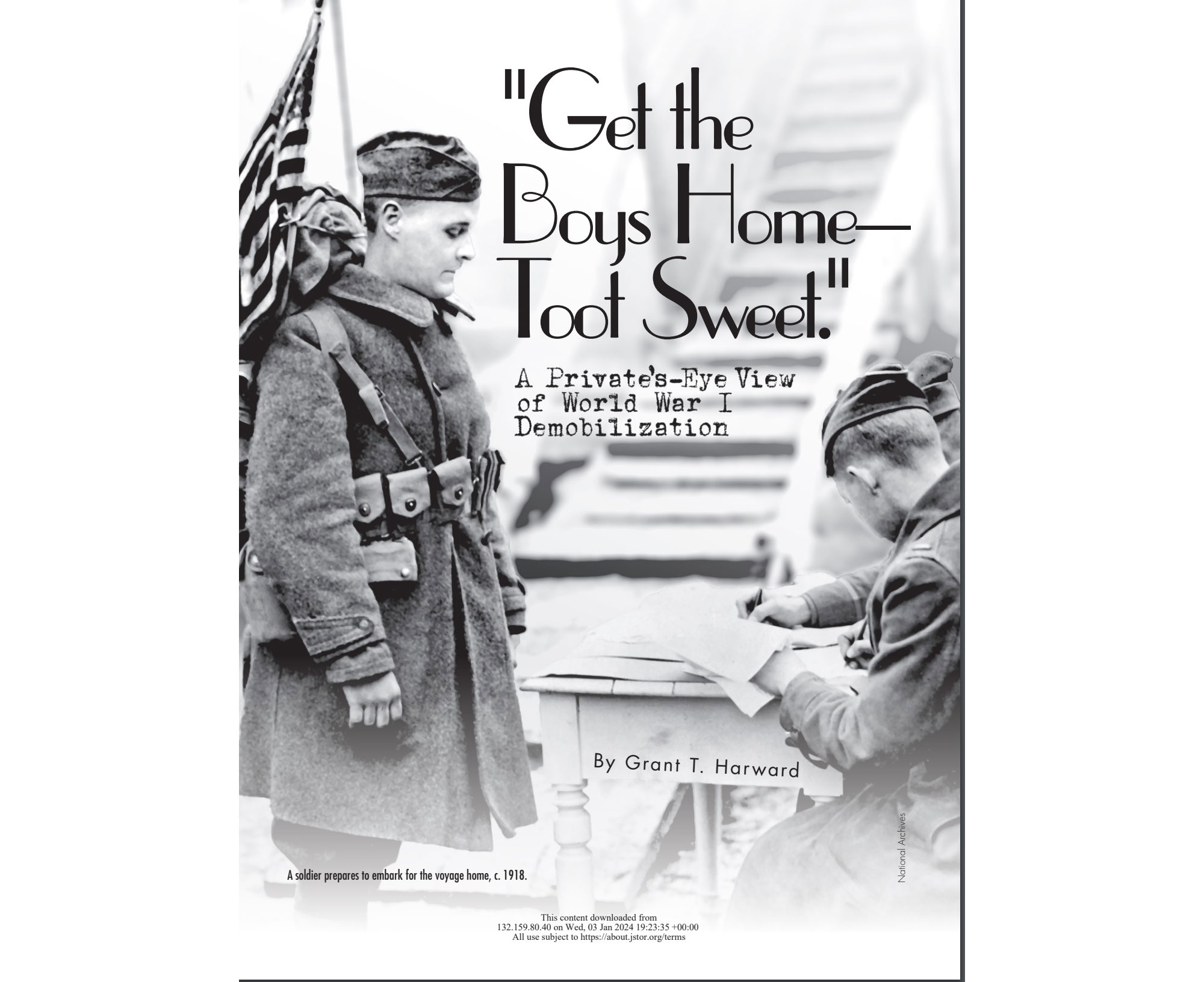
A soldier prepares to embark for the voyage home, c. 1918.
"The papers here are printing headlines ‘get the boys home– toot sweet’ but there is nothing definate as to going home yet. All the talk is of being sent to Russia,” Pfc. Alonzo E. Reed Jr. wrote his mother on 2 February 1919.1 Lonnie (as family and friends called him) used “toot sweet,” the anglicized French phrase tout de suite meaning “right now,” popularized by doughboys in France. His letter illustrates the conundrum facing the U.S. Army on the Western Front following the Armistice. The American Expeditionary Forces (AEF) needed to be ready to fight if peace negotiations collapsed and also to support an ongoing Allied intervention in the civil war in Russia, but they also had to demobilize rapidly because the American public expected soldiers to return from overseas “toot sweet.”
Lonnie served with a railroad regiment in France that helped transport most of the AEF to ports for home. His collection of letters, stored at the archives of the U.S. Army Medical Department (AMEDD) Center of History and Heritage, provides a unique private’s-eye view of the AEF’s demobilization a century ago. This article covers Lonnie’s military service between May 1918 and November 1919 and uses his correspondence to highlight various aspects of Army demobilization.
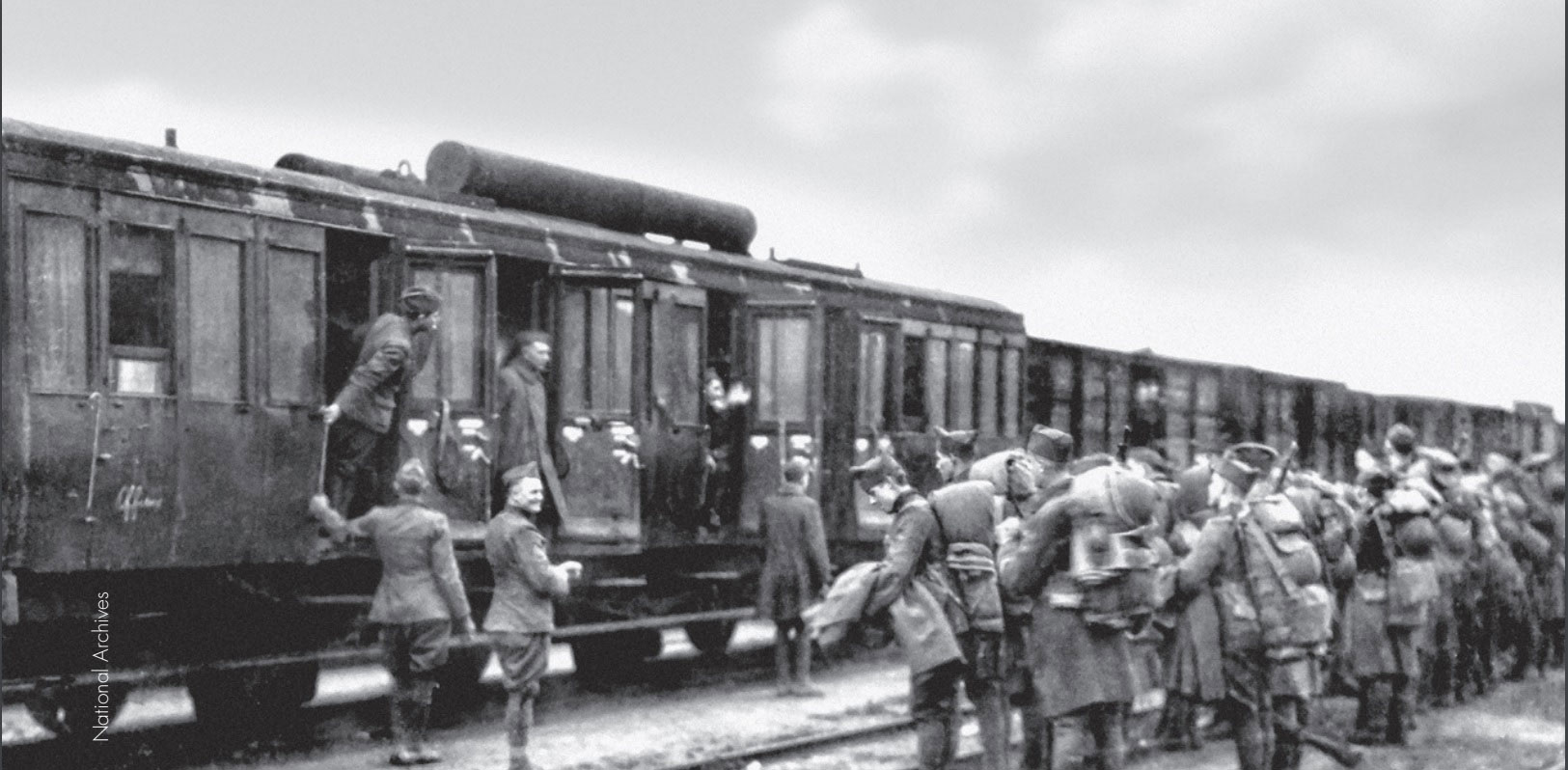
Troops board a train to a port of embarkation, 7 January 1919.
Lonnie, like many American youths, was anxious to demonstrate his honor and manliness by becoming a soldier after the United States declared war on 6 April 1917.2 By then, World War I was in its fourth year. Although armies fought across the globe, the most important theater was in Europe and specifically in France on the Western Front, where the British and French armies were locked in deadly combat with the German army. A vast network of trenches protected soldiers from deadly firepower, leaving the Western Front deadlocked, but attritional battles steadily wore down the opposing forces. The United States entered the war just as the Eastern Front was collapsing because of revolution and civil war in Russia, thus prompting Germany to rush to defeat Britain and France on the Western Front before the United States could come to their aid. With no time to waste and little margin for error, Congress bucked American tradition and passed the Selective Service Act on 18 May 1917, placing its faith in an Army of conscripts rather than volunteers.3 Even so, the Army still accepted volunteers under certain conditions for most of the conflict.
Lonnie Reed was one of these volunteers. He was born on 30 August 1899 to Alonzo E. and Mary E. Reed in Colorado Springs, Colorado. His parents had moved from Indiana to Colorado to mine gold, but after strikes and floods they returned home. Consequently, Lonnie grew up in Monon, a town 90 miles northwest of Indianapolis, with his older sister Lucy and younger brothers Charles, John, and Myron. He graduated from high school soon after the United States entered World War I, but had to wait until he turned 18 to volunteer. The Selective Service targeted men 21 to 31 years old and accepted volunteers until 15 December 1917. Even then, anyone not registered for the draft could still volunteer. An initial surge of volunteers was followed by a steady stream until 8 August 1918 when all volunteer enlistments were suspended.4 Lonnie had suffered a bout of polio as a boy that left his legs weak, but he remained determined to serve. On 4 May 1918, Lonnie excitedly scribbled on a postcard from Indianapolis, “Rejected for Navy. But accepted for Army.”5 He wrote his sister, “Well one of my chief ambitions has been realized, the wearing of a uniform. The Navy did not desire my presence in their midsts, so like the fox + sour grapes a changed my mind about wanting in + joined the Army . . . I enlisted in Indplis as an ambulance driver in the Medical Dept as that was the only place I could be used in any truly active capacity in France.”
Taking a train to St. Louis, Missouri, Lonnie reported to Jefferson Barracks where “we were worked thru the ‘mill’ the name given the examining bldg” for six hours that “was as hard a days work I have ever known.”6 The Army nearly rejected him. “The Dr’s at J.B. had quite a consultation concerning my feet and my card was marked passed for limited service, because I talked him out of turning me down entirely. As for limited service one Dr said I could never go to France, the Dr’s here say I will.” Lonnie’s medical company was supposed to be attached to pioneer engineers, troops tasked with constructing trenches, causing him to excitedly claim “the fatalities in this work are greater than any branch of the service,” as he expected to serve near the front.7 After five days, he returned to Indianapolis, reporting to Fort Benjamin Harrison to begin training. He proudly instructed his parents, “P.S. Now you can fly your service flag.”8 Meanwhile, British and French armies, reinforced by the few U.S. formations already in France, confronted a massive German spring offensive.
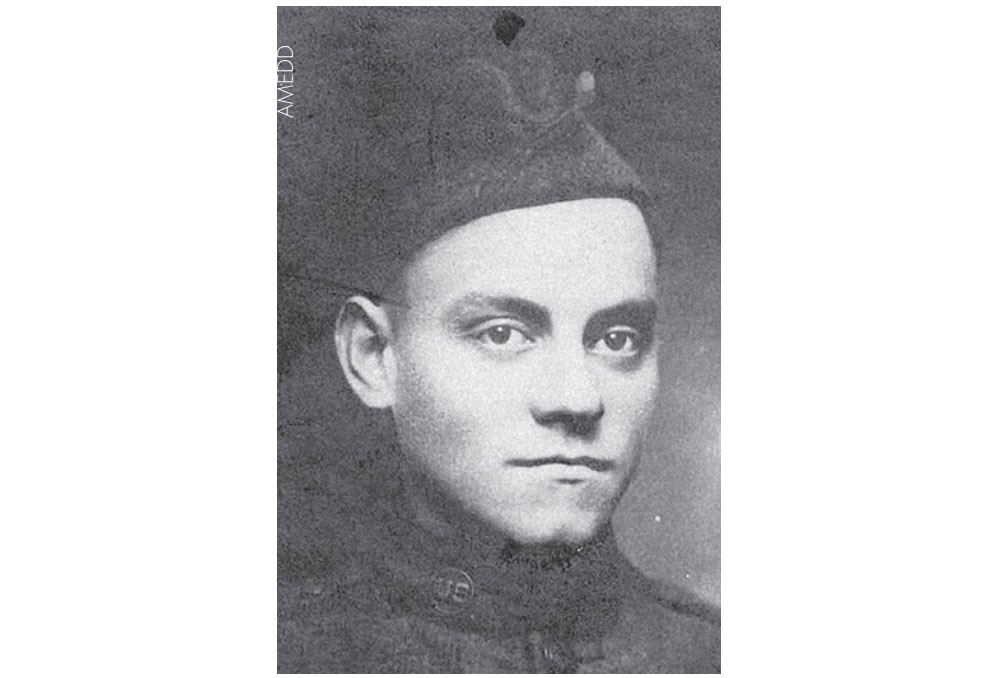
Private Reed
The Army rushed to transport troops overseas during the crisis, and training suffered. The AMEDD grew from 9,000 to 350,000 men creating shortages in personnel, especially doctors and surgeons, because training new ones from scratch took years.9 The Selective Service plucked physicians from civilian practice to be hurriedly trained as medical officers.10 In contrast, most medical enlisted men had little or no prior civilian medical experience. Although Lonnie was to be a “chauffeur” and not a “sanitation man” (then a common term for a medic), the Army required him to have some basic medical training. Ambulance companies officially had a four-week training program consisting of over two hours of drill each morning followed by classroom instruction every afternoon in auto mechanics, nursing, bandaging, first aid, or messages, signals, and general orders.11 Lonnie informed his brother Charles that his first week was “more the life of a school boy than a soldier.”12 Not all his training was so scholastic, however. A nearby field had been transformed into trenches mimicking those on the Western Front, complete with dressing stations and shelters for stretcher bearers. “The barb wire entanglements could be electricly charged to prevent their being cut and believe me any one who could get through would be super human.”13
Yet training was rushed, insufficient, and crowded out by other duties. Lonnie confessed to his sister, “All I know about medicine here is if a man is nearly sick, give him quinine, is broken out with rash, paint him with Iodine, if bones are broken let him alone, but if gassed, knock him in the head.”14 He helped process newly arrived draftees by giving vaccinations and nursing those who arrived with illnesses or who soon became sick because of crowded camp conditions. Lonnie was disappointed to discover the arriving soldiers were training as railway engineers, instead of pioneer engineers, so he would not be transporting wounded near the front. On 7 June, his medical company received its overseas supplies of medicine, first aid belts, and packages along with its field kitchen, but the engineer regiment it was assigned to still needed to train. In the meantime, Lonnie reported, “As the business of driving an ambulance is dragging a little slow I was placed on special duty at the Dental office while the 61st have their teeth fixed to a first class condition. My work consists of sterilizing instruments after use on each victim.”15 Finally, on 29 June, Lonnie departed with the 61st Engineers. “I am happy to know that I am able to be one of the fellows on this train, and I don’t believe that there is one, who is here for a more patriotic stand point,” he opined, “I guess that this is shooting men there pretty fast as I have not been in the Army quite two months.”16 Concurrently, German attacks continued to batter the Allied line in France, but the crisis at the front had already passed even as American soldiers arrived in growing numbers.
Nearly 85 percent of doughboys left for France through ports in or around New York.17 Soldiers traveled in high spirits. Lonnie reported, “The time was passed in Singing and yelling chiefly. About 1130 we were in Cleveland, but I was so sleepy that I mearly put my head out the window and gave one yell and went back to sleep.”18 After fifty-five hours, he disembarked and rode a crowded ferry to Camp Upton passing battleships, the Statue of Liberty, Brooklyn Navy Yards, the interned German passenger liner Vaterland, and the Brooklyn Bridge along the way. On 8 July, after fewer than six days, the 61st Engineers left the port, and not a moment too soon for Lonnie, because, as was true of most embarkation camps, “This is a poor camp and full of vermin.” Up to the last minute, he worried about being turned back as unfit for duty. “We have not taken the final examination yet, but I am beginning to feel confident that I will pass as it will now have to be done in such a hurry that they may miss my feet and I have nothing else to fear for.” His imminent departure prompted him to reflect,
When we leave the States I realize that we are launching upon the greatest enterprise of our life and must be equipt physicly mentaly and moraly, to survive, all ready I have seen and known of many of the unpleasant incidents of Army life which spell the ruination of a man’s life and I think that I am better prepared for this trip now than I have ever been in my short life, and god helping me will come back a bigger, cleaner stronger boy than the one that you know, or else die that way in a good cause.19
The only record of Lonnie’s voyage was a postcard provided to every soldier when they boarded with the message “The vessel on which I sailed has arrived safely overseas.”20 A peak of 311,359 soldiers embarked overseas in July with a total of 1,600,000 Americans arriving in France between April and November 1918.21
A great number were service troops needed to sustain combat troops in battle. On 10 August, Lonnie disembarked with the 61st Engineers at Brest and they quickly were assigned to Rennes under Base Section No. 5. Initially, the AEF naively had believed the French would supply its forces, but France lacked personnel and rolling stock to supply the Americans, and French railroads were battered. Therefore, the AEF created a service force with the mission “to relieve the combatant field forces from every consideration except that of defeating the enemy.”22 First known as the Lines of Communication, on 9 March 1918, the AEF reorganized this service force and renamed it the Services of Supply (SOS). The SOS was responsible for the Quartermaster Corps, Medica l Department, Engineer Department, Ordnance Department, Signal Corps, Air Service, General Purchasing Board, Gas Service, Construction Department, Transportation Department, Motor Transportation Department, and the Light Railways and Highways Department.23 By the Armistice, the SOS had 546,596 soldiers and, with the 173,008 troops in supply trains, headquarters, and hospitals with large combat units, comprised nearly 37 percent of the AEF.24 The SOS divided France into three zones: the advanced section on the front, the intermediate section, and seven base sections (six in France and one in Britain) on the coast. Base sections unloaded and transported the supplies to the intermediate section where they were sorted and sent to the advanced section to be distributed on the front.25 Base Section No. 5 was the primary point of disembarkation for men and materiel because Brest, which could handle 30,000 troops and 6,000 tons of supplies a day, was the only deepwater port available to the AEF. Rennes was its center of rail operations with a locomotive terminal and repair shops enabling Base Section No. 5 to transport 125,000 troops and 25,000 tons of supplies every month.26 Lonnie initially drove ambulances for an infirmary in Rennes until 26 September when he was transferred to Laval, a town several hours closer to Paris.
The Allies had launched a massive counteroffensive in August—including an AEF attack at St. Mihiel followed by another at Meuse-Argonne—that steadily drove the German army back along the whole front. On 3 October, Lonnie wrote his mother, “The papers give promising news each morning and some of the fellows are talking about packing up and starting back to avoid the rush.”27 Indeed, the War Department ordered a secret study on demobilization around this time.28
Lonnie’s life in Laval was idyllic. The 61st Engineers maintained a small station in town where railway crews rested and ate. He spent most of his time preparing food for the railway engineers because his small medical detachment, which did not even have an ambulance, had little to do otherwise. Lonnie wrote his uncle,
“Your letter sounds like you were writing to some heroic soldier, as for me I am an aristocratic ‘yank’ spending the fall and winter abroad living in a hotel too, fine eats, feather bed, two kinds of water, clean + dirty and congenial company. There are only a few soldiers here (american) but there are a great many Russians . . . As for the war you know a whole lot more about it then I do, I have never heard a rifle shot yet, and it don’t look like I would either.”29
Lonnie was fortunate never to experience frontline combat in the trenches.
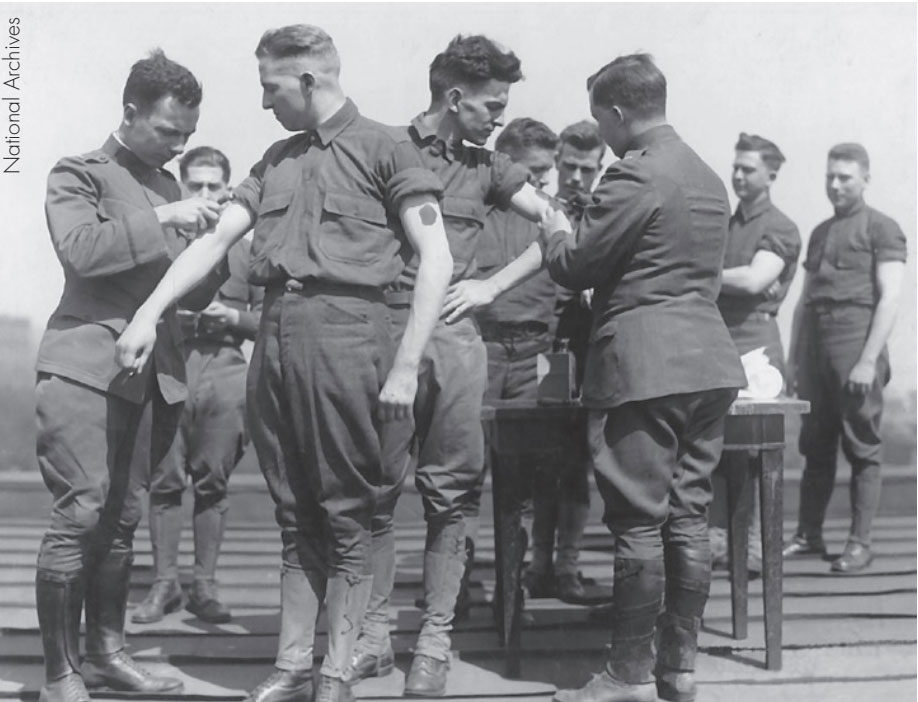
Soldiers receiving immunizations, c. 1917
The reason Laval boasted a large Russian population was complicated. After suffering horrendous casualties in 1914 and 1915, France desperately turned to Russia, believing it had near limitless personnel reserves. It offered French war materiel in exchange for Russian men. Russia had also taken heavy losses, yet was in dire need of arms, so it struck a deal with France. Eventually, Russia sent 43,000 soldiers organized in four brigades to fight for the French: two brigades on the Western Front formed the Russian Expeditionary Force (REF), another traveled to the Salonika Front in Greece, and one more arrived in France but never fought.30 The REF entered combat in July 1916 and performed satisfactorily, although there were troubling signs of indiscipline and poor morale. News of the Russian Revolution in March 1917 made the situation much worse. After a failed French spring offensive, the REF was pulled off the front in April 1917. However, a brigade rebelled in August 1917 because it had not yet been repatriated to Russia and occupied a town, which resulted in a standoff. Ultimately, reliable Russian soldiers, backed by French troops, disarmed the revolutionary Russian soldiers after a brief battle in September 1917. The Bolshevik revolution in Russia in November 1917, which triggered a civil war, further delayed the REF’s repatriation. Until they could return home, the French gave the Russians a choice to fight, work, or be imprisoned. A few joined the Russian Legion to keep fighting and most agreed to work, but a sizable minority refused either option and were held in internment camps in North Africa.31 Laval became headquarters for Russian work units laboring across France and a depot for the Russian Legion fighting on the front.32 Consequently, Russian soldiers were a familiar sight for Lonnie.
The Transportation Department kept railway crews busy by feeding men and materiel into the meat grinder of the Meuse-Argonne, which was fast becoming the largest and bloodiest battle in Army history. The SOS estimated that by the Armistice, the AEF required over fifty-one pounds of supplies for each man every day.33 The War Department dumped supplies into French ports, but according to the SOS chief of staff, the “real neck of the bottle” was shifting supplies from ports to the front.34 The Transportation Department, soon reorganized into the Transportation Corps, worked under the French State Railway.
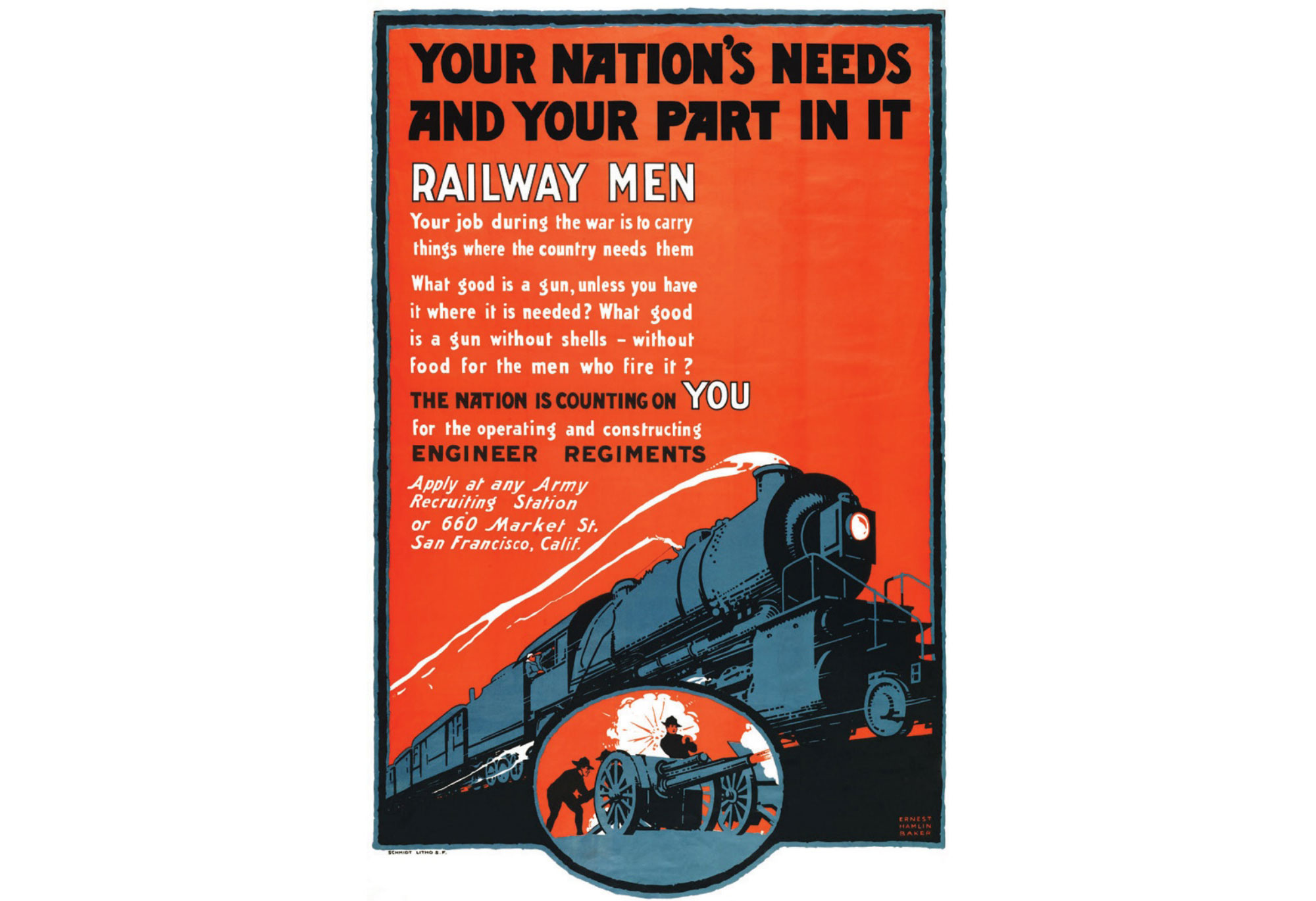
Advertisement about the need for railway men.
The Transportation Corps often clashed with the French State Railway because the French preferred short runs by small trains, and French station masters could sidetrack shipments or keep empty train cars on a whim, but the Americans wanted to make long runs with large trains.35 Only when more powerful locomotives and additional railcars arrived from the United States could the Transportation Corps realize these plans. Engineers laid 1,002 miles of track, operated 1,667 locomotives, and assembled 19,697 railcars and other rolling stock with parts shipped from the United States before the Armistice.36 Lonnie watched troop trains pass through Laval. On 18 October he wrote, “I wouldn’t trade shoes with anyone just now, but everyone cannot be stationed in Laval and yet they are crazy to get across, ‘poor fellows.’ I would like to serve my time at the ‘front’ and their go home, but that does not appear to be my destiny, so I’m content.” Lonnie ate well, bought American newspapers, mingled with locals, and volunteered for the local French Red Cross. Although sharing in the same cultural conceit as most doughboys, he developed a relatively enlightened view of France. After an argument with a French interpreter about whether the United States or France was the better country, he wrote, “[A] s far as I’m concerned, this is the frenchman’s country and they are welcome to it, but we need not tear it down because everything here is not as we are accustomed to; nor because they were not strong enough to handle the present situation.”37 Lonnie felt life had become somewhat monotonous in Laval, but new activity would begin after relentless Allied attacks forced German leaders to agree to a truce.
War-weary France met the Armistice on 11 November with delirious celebrations. Lonnie reported, “The natives here surely are sociable since the eleventh and that date has been celebrated in a manner most appropriate.”38 When official word of the Armistice arrived in Laval after dinner, “In a half hour all the bells were ringing and flags began to appear from every house + building along the street. The crowds started moving in a sort of parade, and the Barracks at Camp Upton, c. 1918 Longwood Public Library This content downloaded from 132.159.80.40 on Wed, 03 Jan 2024 19:23:35 +00:00 All use subject to https: 29 Russian band came in front of the hotel and played several seclections, including the Star Bangled Banner. The people certainly were happy. That night the town was wild, us americans[sic] turned out in ‘Squad formation’ there were about sixteen or eighteen all told, but before the ‘last act,’ we sure had thise[sic] town natives thinking the place was full of us.” The next night was the same except for the addition of fireworks and a boat with red, white, and blue lanterns reflecting off the water in a canal. “The people here light a fire cracker and throw it in the largest crowd near. It is a wonder people are not seriously hurt, but then it is typical of the way many things are done here. Well I met a great many natives, (particularly females) during those evenings and had a fine time.”39 Over the next week Lonnie traveled to Rennes to visit friends, then his friends came to Laval to visit him, and finally he went with a lieutenant to tour nearby Le Mans. Yet Lonnie’s jubilant letters were dampened by concerns about “the flu,” especially after finding out his sister Lucy, away at college in Bloomington, was ill.
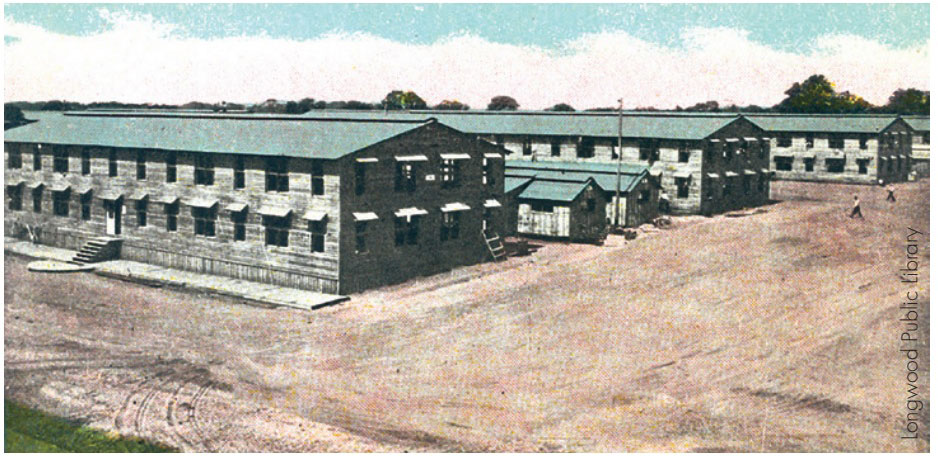
Barracks at Camp Upton, c. 1918
Known as the Three Day Fever, Grippe, Grip, knock-me-down fever, Flanders Grippe, Spanish Grippe, and most commonly Spanish flu, this new strain of influenza struck soldiers and civilians in America and Europe between 1918 and 1919.40 The deadly illness emerged in the United States, but the first wave in April 1918 killed few and received scant public attention despite quickly arriving in Europe. Neutral Spain’s uncensored press first reported the illness, hence its nickname. The AMEDD had anticipated a resurgence of the influenza over the winter and had taken extra precautions, but the flu’s second wave beginning between September and October was far deadlier. It overwhelmed military authorities as one million soldiers, over a quarter of the Army, became ill.41 The Spanish flu also sickened millions of civilians. Troopships packed with doughboys acted as veritable plague ships, arriving in France with scores dead and hundreds sick.42 Although 75 percent of those exposed could fight off the disease, the rest became very ill. Few actually died from influenza. Instead, secondary infections, most often pneumonia, usually killed the afflicted.43 The AMEDD recorded 46,992 soldiers died from the Spanish flu or its complications by the Armistice— only 3,500 fewer deaths than in battle.44 All combatant armies suffered similarly. Many hundreds of thousands of civilians also succumbed to the Spanish flu in the United States and Europe, not to mention more victims across the rest of the globe. Fortunately, Lonnie’s sister Lucy recovered.
While the AMEDD fought the Spanish flu, the War Department hurried to plan for demobilization. Of 4,178,172 mobilized soldiers, 2,810,296, or 67 percent, were draftees known as “emergency men” who had to be sent home immediately.45 Most of the rest were volunteers (fewer than 300,000 soldiers were prewar regulars or national guardsmen), but even volunteers expected to be discharged as soon as possible. Moreover, families at home demanded the soldiers’ rapid return. The War Department considered four criteria for demobilization: length of service, occupation, locality, and unit. The first three options would have separated soldiers as individuals, which would have required experienced personnel, extensive paperwork, and time. Additionally, most soldiers had been overseas less than six months. Holding men arbitrarily based on occupation was likely to cause tensions, and local draft boards lacked uniformity. Finally, separating soldiers individually would hollow out divisions that needed to remain militarily effective just in case the Armistice collapsed and fighting resumed in Germany. Thus, the War Department decided to demobilize by unit because it was simple, discharged a broad cross section of men, and kept combat divisions intact. Regular Army divisions, which had many draftees, would be the last to demobilize.46 On November 16, the War Department announced its decision to the public and started to demobilize 1,500,000 men in the United States and 2,000,000 men in France in the following order: casuals (unassigned soldiers); surplus or special service troops; troops in England; Air Service personnel; troops in Italy; combat divisions; and finally, SOS troops.47 Releasing soldiers in the United States (who usually were near home already) was simple, but coordinating AEF soldiers’ return across the ocean was much more difficult. France no longer gave priority to troop trains and the British stopped providing troopships.
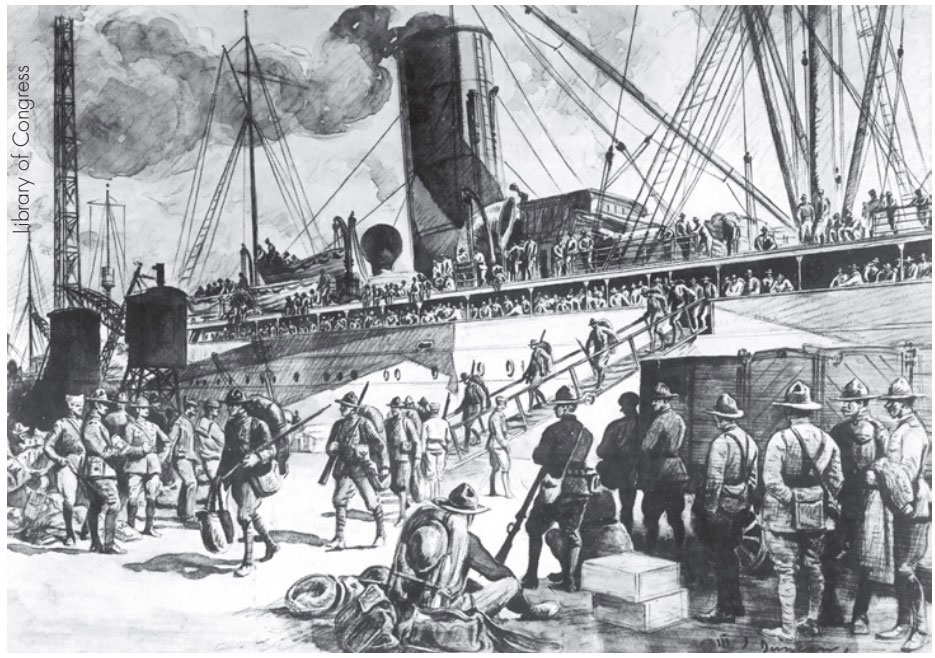
A sketch by Walter Jack Duncan of U.S. troops arriving in Brest, France
Brest became the main port of embarkation as Base Section No. 5 threw its railroad operations into reverse. Soon trains passed through Laval going the opposite direction. On 24 November, Lonnie reported that, “The wounded soldiers are on their way home now, and the idea that they are on their way back to America is better than medicine, and makes them forget their aches and pains. Some of the fellows are in pretty bad condition but they all smils[sic] and joke with us, when we’re at the depot.” He often had the chance to listen to the Russian band in Laval. “I am always meeting someone who speaks English. Yesterday I met a Russian who speaks six different languages. I didn’t suppose that one of those big overgrown creatures could be so intelligent.”48 Not all doughboys kept going west. On 11 December, Lonnie complained, “This town is ruined now, and there are going to be thousands of soldiers stationed here, the first train of several is to arrive here to-day, and then goodbye old Laval; but then I supposed I shouldn’t feel selfish and try to feel bad over spilt milk.” His medical company in Rennes finally received an ambulance “now that the war is over and the ‘flu’ well in controll[sic], so I am not going to leave here on my own efforts to try and drive it, and anyway its only a ford.”49 The new arrivals did not impress Lonnie. “Well, they are in now and every body in Laval knows it too. I hate to criticize any bunch of US soldiers that have been thru the mill at the front, and have acquitted themselves so well, when I have never even heard a gun crack; but such an uncivilized lot of troops I never saw. Our little town is ‘ruint’ . . . The french tho’t that if we were a sample of american[sic] soldiers, why, bring on a whole division, we were often asked when the soldiers would be here, now they ask ‘when will they go?’”50

Cherbourg St.-Malo Le Havre Orléans Chaumont Troyes Château-Thierry Reims Gondrecourt Toul St.-Mihiel PARIS Calais Amiens Soissons Verdun Dunkerque Langres Neufchâteau Is-sur-Tille Lyon Dijon Le Mans Tours Châteauroux Cosne Bourges Angers Nantes St.-Nazaire La Pallice Brest Lorient Caen Bayonne Bassens Toulouse Nice Marseille Rouen Laval Rennes ITALY SWITZERLAND UNITED KINGDOM SPAIN BELGIUM GERMANY NETHERLANDS LUXEMBOURG ANDORRA Section Boundary Base Sections 1–7 District of Paris Intermediate Section Advance Section Principal Route Secondary Route Tertiary Route KEY LOGISTICAL SECTIONS RAILROAD SUPPLY ROUTES March 1918 AEF LOGISTICAL NETWORK FRANCE. For a Larger Image
Such attitudes were not limited to Laval. Franco-American relations cooled after the Armistice as resentment grew on both sides. The French saw Americans as troublesome and Americans perceived the French as ungrateful.51 Nevertheless, when President Woodrow Wilson’s train passed through Laval on the way to the Paris Peace Conference, he received an enthusiastic welcome. On 27 December, Lonnie wrote, “My first Christmas away from home, but it was far better than some had, I know.” After Christmas dinner with his mates, he had an “engagement with a little friend” and attended a concert by the Russian band. “The leader of the band, before the war, was the first violinist with the Moscow opera orchestra, so you know the band is worth hearing.” The Army also provided a present. “On the 10th of Jan we are entitled to a service stripe for six months service, but it seems like six years sometimes. Of late however time has been on wings.”52 Although time flew, Lonnie remained rooted in place.
Railway crews were vital to demobilization, so the 61st Engineers would be among the last to leave France, and Lonnie would stay to support their mission. On 7 January, after driving back from Rennes where he had seen a minstrel show and attended a boxing match on New Year’s Eve, he broke the news to his mother, “The best I have to tell, is that the present outlook for the near future, is very promising not for a homecoming but for existence in France . . . An outfit operating on a R[ailwa]y cannot be relieved every so often like an outfit at the front, for it takes time to get crews accustomed to a road and everything working smoothly. And now there is as much or more traffic then there ever has been; with troops and material coming back from the front.”53 The Transportation Corps reorganized rail operations along the same lines as in the United States and the 61st Engineers’ three companies were assigned to the 16th Grand Division. Laval became even more crowded. Lonnie complained, “My worst troubles at present is that a couple of American officers are trying to crowd in and get a house where they have no business.”54 The spike in the number of troops meant military police (MP) appeared in the town for the first time. “This town is now so full of M.P.s that they make life a misery for some . . . One M.P.came inside and tried to make one fellow put his coat on. Oh the place is ‘getting good.’”55 Unsurprisingly, discipline began to slip during demobilization, especially as soldiers had plenty of free time.
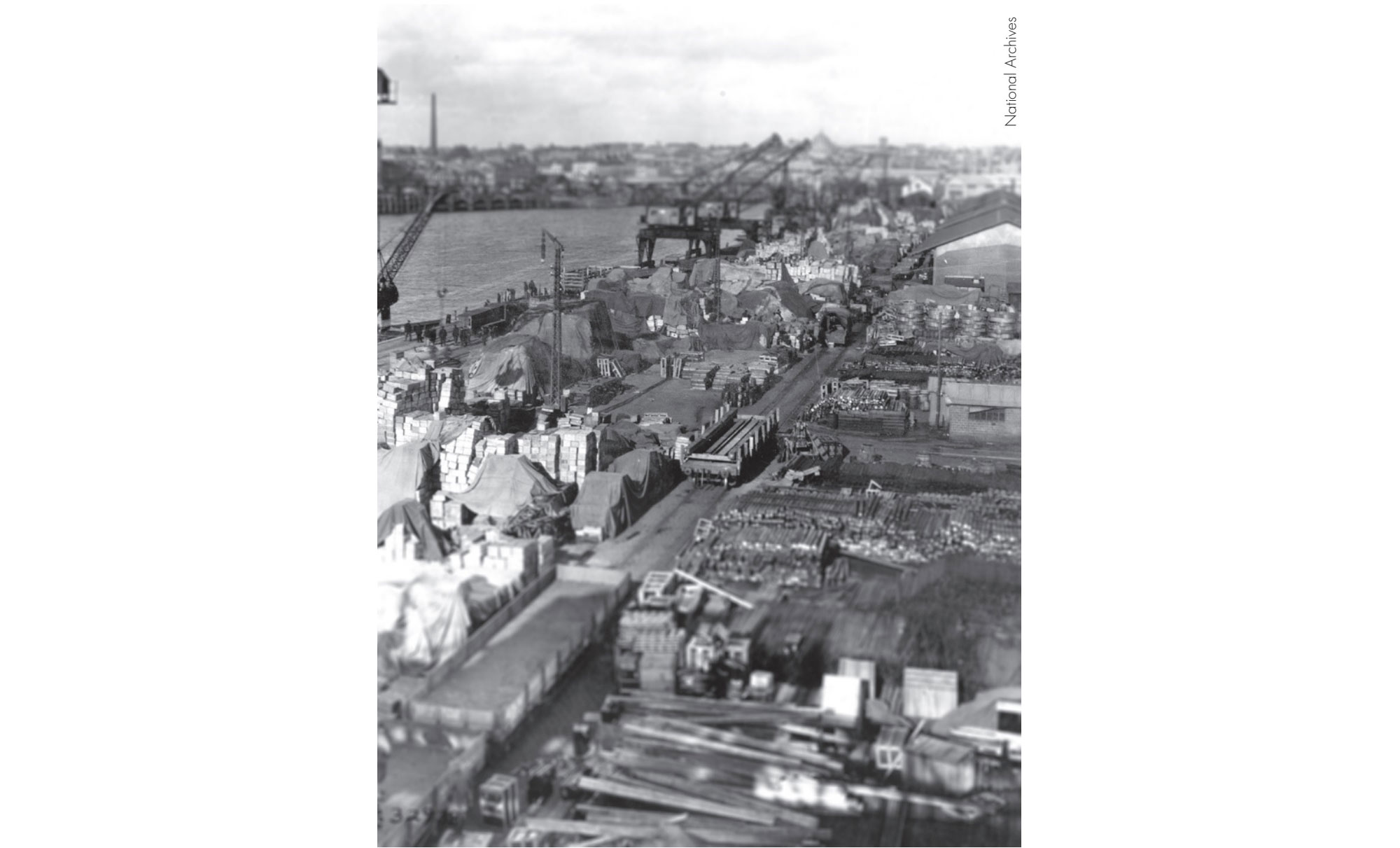
A typical scene at French dockyards during the war, Nantes, France, c. 1918
The AEF focused on training after the Armistice, but faced resistance from doughboys. The French had asked for American help to begin rebuilding regions devastated by war, but AEF commander General John J. Pershing argued this would delay demobilization. He said inadequately prepared troops should use the time to train in case fighting resumed. And the American public would not tolerate soldiers being used as laborers.56 On 30 January, Pershing arrived in Laval on his special train. “The automobiles were unloaded and the A.E.F. commander went out to review some of his fighting forces which are soon to be returning home. The French put out a great display of flags but there were few who saw ‘Jack’ as he was on a purely business trip. The 61st has the honor of furnishing the engine crew which pulled him from here to Rennes and that is worth mentioning,” Lonnie wrote.57 Soldiers resented the training, especially combat veterans who felt they had little to learn.58 There were limits to how much soldiers could train, so the AEF began organizing sports, vocational training, education, and liberal leave to keep troops occupied until they boarded trains for a port.59
Meanwhile, a third wave of influenza struck North America and Europe between December 1918 and April 1919, peaking in February when Lonnie himself got sick.60 On 7 February, he wrote two letters—one telling his mother he “had a severe cold,” and another informing his sister “I am recovering from an attack of the grippe and have not been out side until the last day or so.”61 On 25 February he reported, “The ‘flu’ is raging here as bad or worse than ever before, but since I have just recovered I do not feel in any danger myself. Two of our family [we are billeted with] are sick now and I have to do some extra work.”62 This outbreak seemed particularly cruel as it killed many soldiers who had survived terrible battles. The news of these deaths in France added to growing public outcry in the United States about the perceived slowness of demobilization.
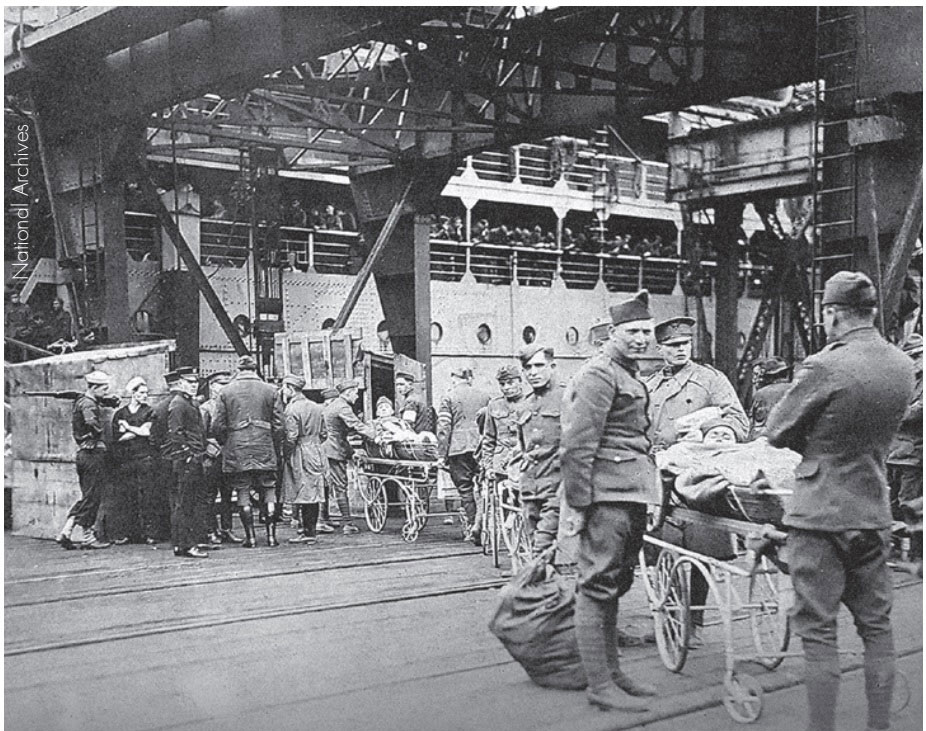
Wounded soldiers are loaded aboard a troop transport for the voyage home.
In the same letter, Lonnie recorded that a handful of railway engineers had volunteered for six months’ service in Russia. The Allies had chosen to intervene in the Russian Civil War to guard stocks of Allied war materiel and rescue the Czechoslovak Legion, a force consisting of captured Austro-Hungarian troops recruited to fight for the Allies, who became stranded in Russia. In August 1918, the first of 9,000 soldiers who had been stationed in the Philippines landed in Far East Russia at Vladivostok and seized part of the Trans-Siberian Railway in an attempt to reach the Czechoslovak Legion from the east. In September 1918, another 5,000 AEF soldiers in North Russia disembarked in Archangelsk and joined Allied and White Russian forces trying to link up with the Czechoslovak Legion from the west. The morale of the AEF in North Russia deteriorated during the winter. Some troops nearly mutinied. The AEF never did connect with the Czech Legion before leaving North Russia in August 1919. The AEF in Siberia remained to evacuate the Czech Legion and supply the White Russians until April 1920. As such, the AEF needed railroad engineers to operate the Trans-Siberian Railway.63 The 61st Engineers was a likely unit from which to recruit, as Lonnie boasted, “[S]ince the armistice was signed we have hauled 40,000 more troops to port of embarkation then all the other regiments in France put together, besides train after train load of freight. We have the best record of any outfit; and all the single engine crews are to be transferred to the army in Russia.”64 In actuality, only eight engineers left the 61st Engineers for Russia.
Lonnie now received a request to return to Rennes but was reluctant to leave Laval. He had grown comfortable where he was and had a local girlfriend. He had befriended a widowed Belgian Red Cross nurse and become close with her 18-yearold daughter Odette, who was a stenographer for a French colonel. He wrote his sister, “She is a good girl in every sense of the word which makes her an exception here. She is pretty and a girl who would not be shaded, even in the States.” He claimed he had no desire to marry her “by choice or otherwise,” although he admitted he had been angry when “Madame” had earlier informed him marriage was out of the question.65 Lonnie was also now the acting mess sergeant, although three recommendations for his promotion were ignored because the medical detachment already had enough noncommissioned officers.66 As he waited to find out if the request would become an order to return to Rennes, he began fantasizing about traveling elsewhere. On 2 March he wrote his mother “No I have not taken my furlough yet and will not while the flu is raging. Later I am planning a trip to Paris and all other principal cities of France and then go to Italy, I had tho’t of going to England but since I cannot go on into Scotland will go to Italy instead.”67 Although uninterested in going to Russia, he informed his sister, “P.S. I am concidering going to Turkey for six months, keep it quiet tho’.”68
The Army had begun looking for volunteers for six months service in the former Ottoman Empire because of ongoing negotiations in Paris. Allied peacemakers debated what to do with territories previously ruled by now defunct empires. Rather than annexation or colonialization, they agreed upon mandates. A mandate was a territory considered unready for self-rule that would be administered by an Allied power in trusteeship until they deemed it ready for independence.69 There was talk of creating a U.S. mandate in Armenia. A military fact-finding mission was dispatched in August 1919, but it came to nothing.70 Lonnie’s plans to travel to other countries never bore fruit either.
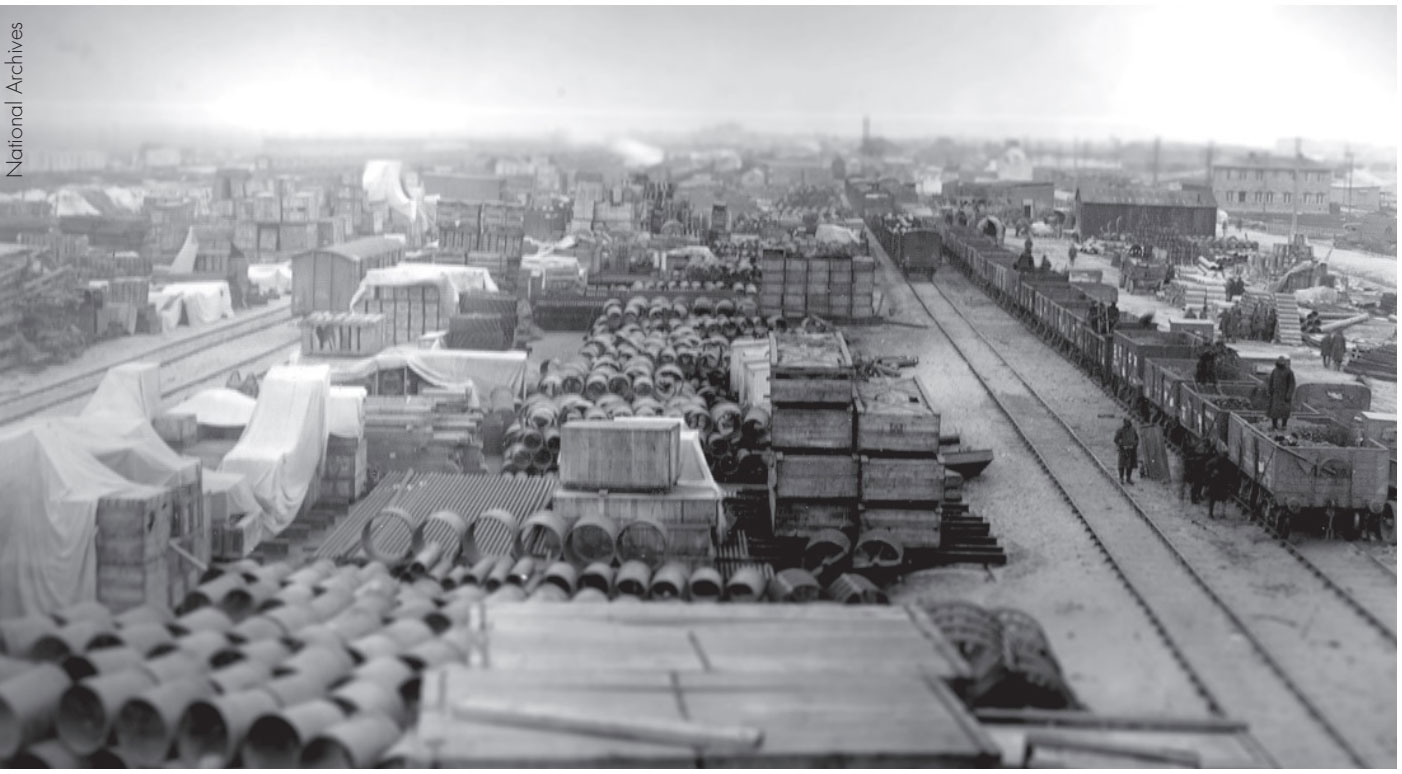
The rail yard and supply storage area at Montoir, France, c. 1918
Instead, seen off by the railway detachment in Laval, and after receiving a photo from Odette, Lonnie went “home to roost” in Rennes on 24 March.71 On the same day, the War Department issued a bulletin again outlining its demobilization plan and asking for patience from the public as anger over alleged Army incompetence had reached a fever pitch.72 Lonnie quickly settled into his new surroundings in Rennes. “Well since writing last I have a new job, am now working in the Infirmary offices, making out all reports etc. If I was a better typest it would be easy but it takes time for me. It is good work tho’ for I have a chance to use and renew my own dead brains.”73 Rennes was much larger than Laval with many more Americans and had a large Young Men’s Christian Association (YMCA) building.
The AEF had decided at the war’s start it would not try to operate canteens and stores to sell refreshments, sundries, cigarettes, and other items to soldiers. Instead, the Quartermaster Department signed a contract with the YMCA to set up a system of hotels, restaurants, officer and enlisted clubs, and leave centers.74 The YMCA operated facilities in France like a business, charging soldiers a minimal fee for services, but at the same time it solicited donations from the public in the United States on behalf of soldiers. Many soldiers grew to hate the “Damn Y,” accusing it of price gouging, selling donated goods, evangelizing too much, and most gallingly to combat veterans, deceiving the public at home through a publicity campaign—including posed photographs—that claimed YMCA workers risked their lives providing charity at the front when the YMCA’s activities were in fact restricted to rear areas.75
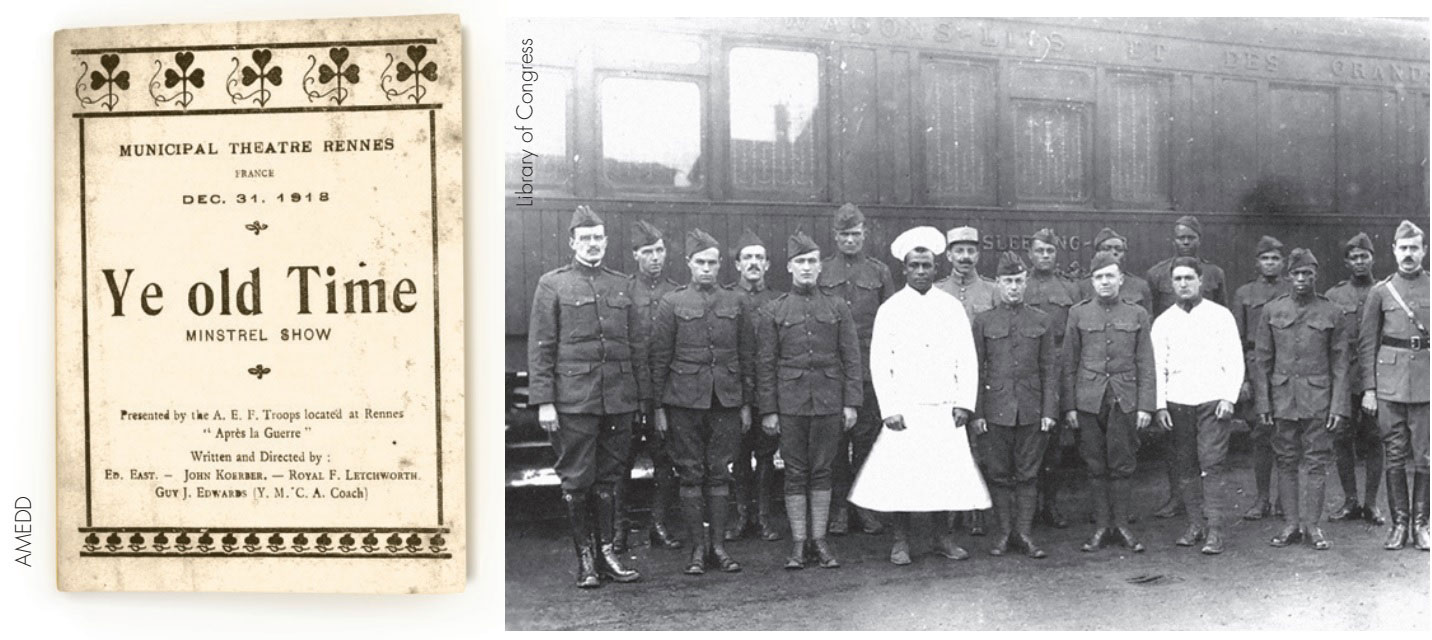
Image left: A program from the minstrel show Lonnie attended in Rennes. Image right: The staff of General Pershing’s special train, 22 August 1918.
Other welfare organizations like the Knights of Columbus, Jewish Welfare Board, and the Salvation Army were much smaller, but passed out their goods for free. In addition, their workers often were close to the front. Combat troops cherished these groups. By the Armistice, the YMCA had 4,444 workers with the AEF compared to Knights of Columbus’ 1,019, Jewish Welfare Board’s 129, and the Salvation Army’s 134; only the American Red Cross exceeded the YMCA with 5,601 personnel, but not all were assigned to the AEF. The YMCA’s mission became even more important after the fighting was over and expanded to 6,430 workers by April 1919.76 In his letters, Lonnie, a soldier with the SOS far to the rear, did not curse the “Damn Y,” like troops with the combat arms, but praised the “Y” for its efforts. Despite all the hustle and bustle of the YMCA in Rennes, Lonnie felt isolated away from his comrades and friends in Laval. “I surely do get lonesome in this town, as I have no place to go and nothing in particular to do when off work,” he wrote on 1 April.77
With the coming of spring, the Army threw demobilization into high gear, requiring long hours from railway crews. As a result, bottlenecks quickly developed. On 10 April, the 42d Division began passing through Rennes, “Everything is delayed and way behind schedule, wait-wait-wait is all they know.” Lonnie reported railway crews worked 13–30 hours without rest and with little food for $33 a month when they could be earning $150–$200 at home. This caused anger and even protests.“On some of the engines, they have written ‘The $1.10-line’ or ‘Mush and Bacon Route.’ Our fellow in Le Mans got a heavy sentence, for writing this on his engine, ‘We’ve paid out debt to old Lafayette, who th’ hell, we working for now?’”78 The Army’s precipitous demobilization still did not seem quick enough for many soldiers.
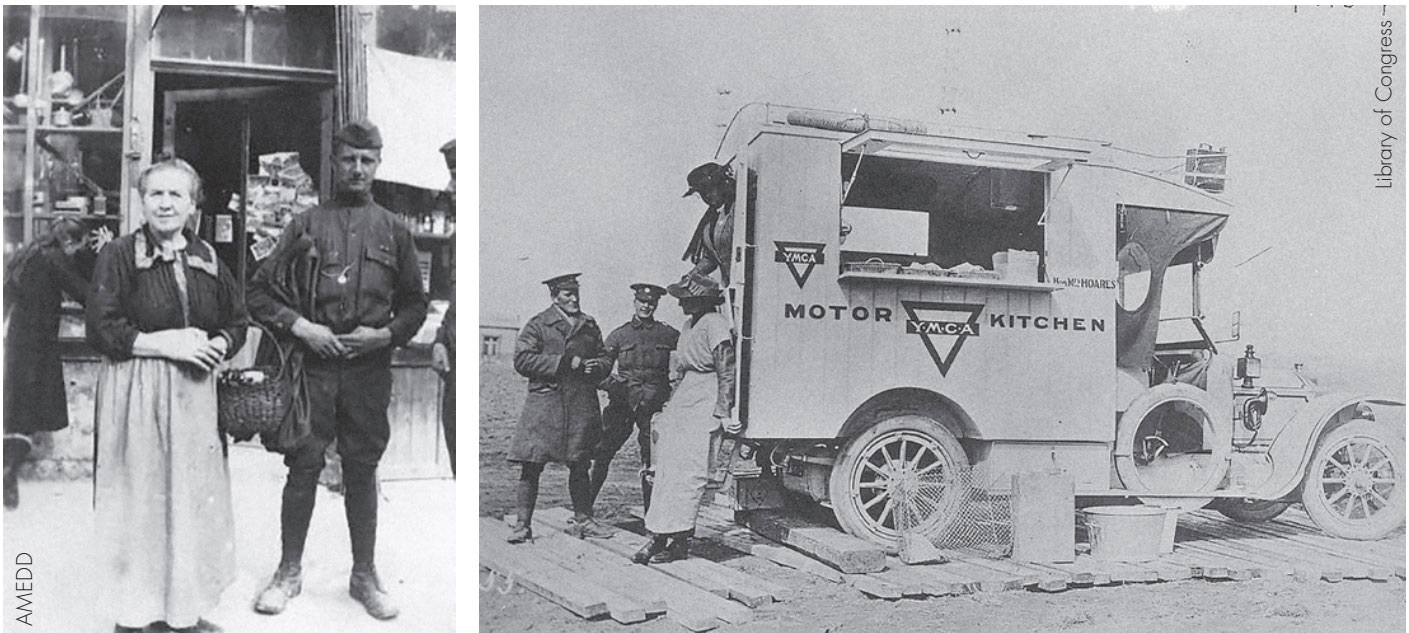
Image left: A photo taken by Lonnie of a French woman and a fellow soldier in Laval, c. 1919 Image right: A YMCA motor kitchen in France, 2 October 1918.
On 19 April, Lonnie finally had some news about the 61st Engineers’ departure. “Word has been received concerning our schedual of work here where we have five more divisions to haul but then we will have to wait our turn on the shipping list.” Periodically, a French airplane doing stunts over his camp would lift his spirits. “I have seen numerous planes since being in France but the novelty hasn’t worn off of watching them.”79 He and a few others began attending a class taught by a medical officer at an AEF school established in Rennes. “Our classes include a little study of medicine and physiology, but then they are an absolute farce as no one takes any interest.” On his own, Lonnie practiced algebra “to remove some of the rust off the wheels of the attic, but the wheels were almost past being moved. It took me a half day to extract the cube root of a little number. A person in the army on most of the work, never uses his mind, if he does + acts on it, it usually brings him to grief.”80 He hoped to arrive home in time to begin at Purdue University in the fall. Others had a similar desire, and 10,000 veterans received permission to attend universities in France and Britain. The AEF University in Beaune had enrolled over 13,000 students by May 1919, but nearly all left before finishing a term.81 Fighting boredom in Rennes, Lonnie jumped at a chance to visit Paris.
Paris drew doughboys like moths to a flame, even though they had to obtain leave and pay their own way. Between January and March 1919, 118,920 soldiers visited the City of Light, and many more followed in subsequent months while awaiting their turn to train to ports for home, including Lonnie.82
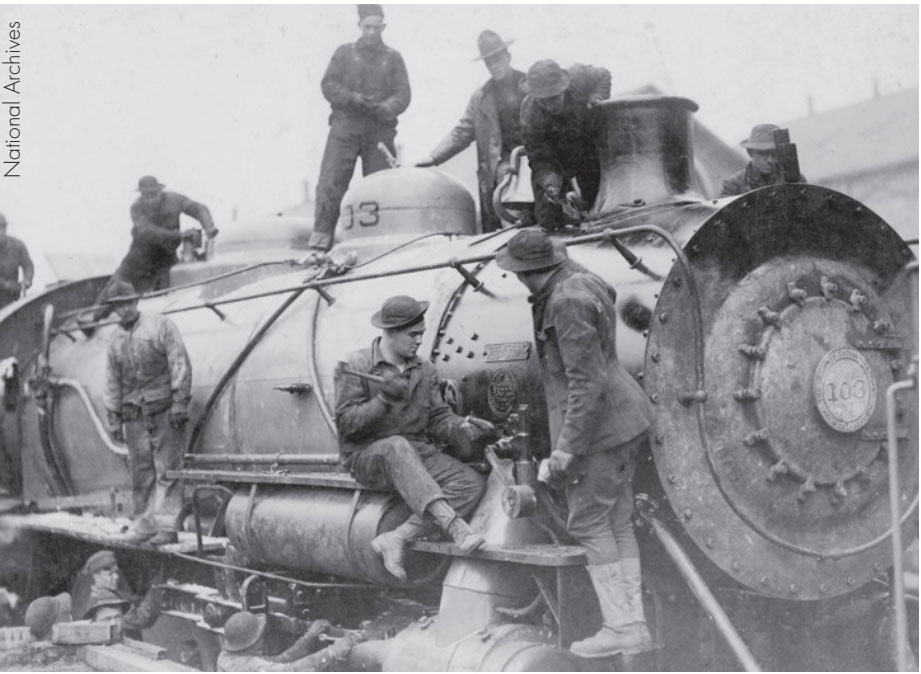
Soldiers working on an American locomotive.
On May 11, he wrote his mother, “It isn’t often I come to Paris, that I can write letters on Mother’s day, but this is one exception.” The YMCA had six different trips designed to cover the greatest number of points of interest over three days. “These trips are by train, truck, subway and a little walking. Unless a person is acquainted with the city he would be foolish to not go under the instructions of the ‘Y’—for they are competent guides and explain it all.” Although impressed by the beauty of Paris, Lonnie saw it as old and backward compared to the modern cities at home. “When it comes to comparison between Paris + any of our large cities, it is out of the question, American cities are devoted to commerce + Paris to art, each has the other only as a side issue. All ready I have seen and heard more than I can possibly remember. Every foot of ground has a book full of history. One fully modern piece of improvement is the subway here, it is wonderful, fare 3¢ + a cavalry minute.” He visited the Latin Quarter, Versailles, the Louvre, and the Paris Opera House. He took two YMCA tours by truck or boat before hiring a taxi to drive him around the city, including a stop to see Odette’s family home. “Believe me a person don’t get any rest, when he undertakes to see this place in three days.”83
Like all soldiers who visited, Lonnie received a flyer with guidelines about proper dress and behavior plus a card with instructions on where to find a prophylactic station on one side and a map to the central one across from the Opera House on the reverse side.84 Venereal disease (VD) was common but kept under control in the AEF. Beginning in July 1917, the AEF’s anti-VD campaign focused on education and punishment. Soldiers were lectured on sexually transmitted disease and instructed that it was their patriotic duty to avoid getting VD. Additionally, instead of adopting officially sanctioned brothels like the French, the AEF erected fences around camps and put “houses of tolerance” out of bounds. The YMCA established leave centers in isolated resort towns in the countryside, and Paris was even off limits for soldiers on leave during the war. Soldiers were subjected to semimonthly inspections and if found with VD had to forfeit pay.85 The Army relied heavily on prophylaxis during the war, but following the Armistice, the fear of being interned in a venereal segregation camp instead of going home discouraged many men from sowing their wild oats.86 Lonnie held other soldiers who contracted VD in contempt.
He found Rennes a hive of activity upon his return on 15 May. “Word has been received here that this organization will stay here to help transport the army of occupation to Brest. That means 600 trains of troops alone besides the equiptment if we get home by Christmas we will be lucky; altho’ preparation are being made to handle ten troop trains per day or a total of about eighteen, war times never were like this, and we can handle the troops over this road alone, faster than all their Transports put to gether can haul away.”87 Embarkation camps outside ports were soon overcrowded with soldiers waiting for ships. To make up for lost British troopships, the Navy added more berths, galleys, and washrooms to its vessels, converted cargo ships into troopships, used surrendered German ocean liners, and even pressed warships into service as troopships.88
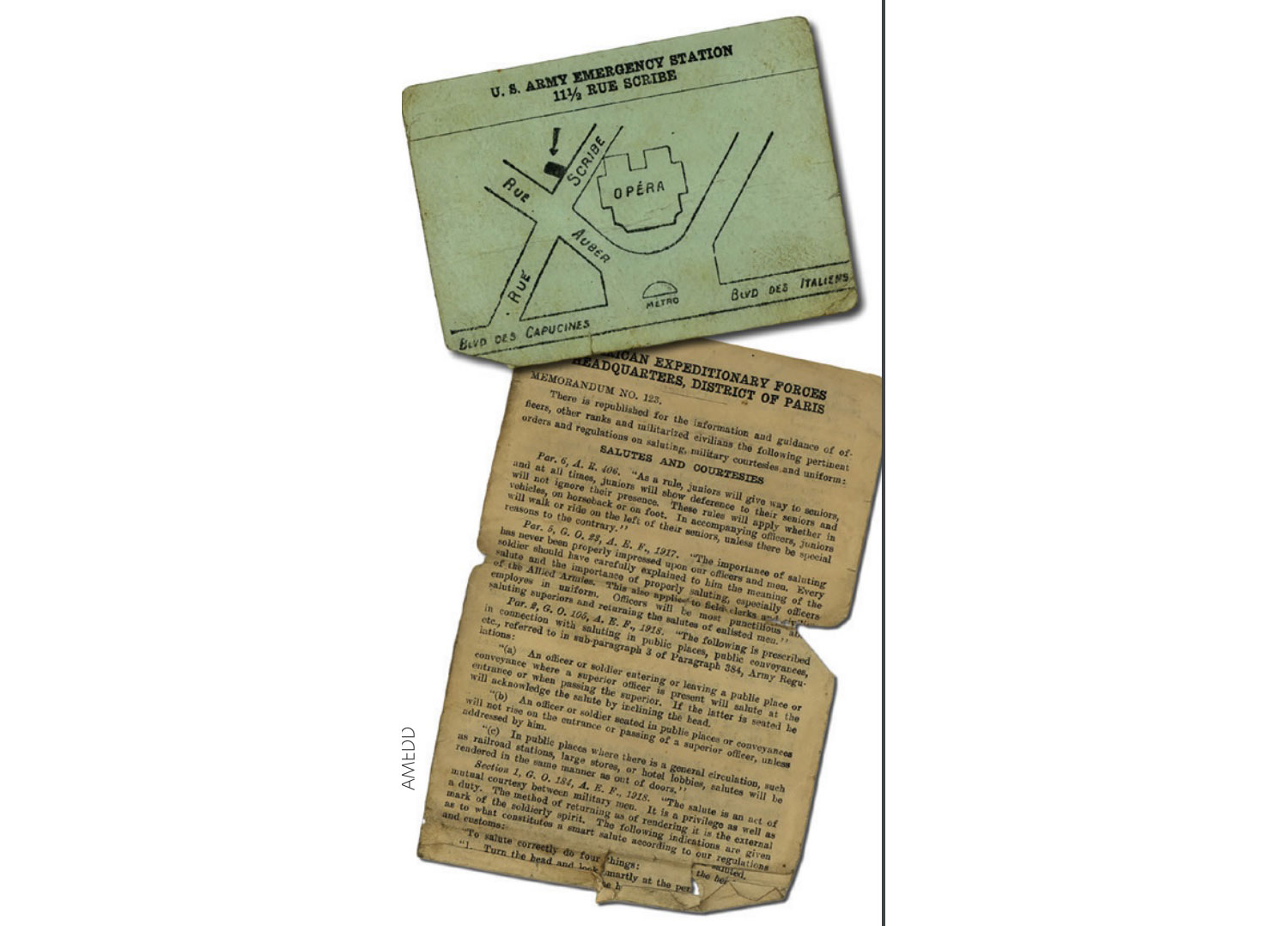
A flyer with instructions for AEF troops when on leave to Paris along with a map showing the location of the main “emergency (prophylactic) station.”
After finishing paperwork for the day, Lonnie went on walks in the countryside, purloined an ambulance for joyrides once in a while, and boxed. Boxing was the most popular sport in the AEF. A mania for boxing had developed among soldiers because officers believed it encouraged aggressiveness and enlisted men saw it as epitomizing masculinity.89 Lonnie begged his family to send him proper boxing gloves after he accidently broke a comrade’s nose during practice, stating: “I hated the accident very much.”90 Lonnie’s sense of isolation in Rennes had dissipated as he made new friends with whom he went on long walks, eventually visiting at least eleven towns in the surrounding countryside. On 21 May he wrote, “As far as hardships and the horrors of war—I don’t know anymore about that then I ever did my life during this ten months so far has been a big vacation. No work much practically my own boss when compared to fellows in other organizations. I have certainly have had + am having some mighty good times over here.”91 He spent a week working in the dispensary for a sergeant who was on leave. Lonnie seemed reconciled to the fact he was not leaving France soon. “The only thing that remains to do is wait and occupy the time best as possible.”92 Nevertheless, the declining quality of the 61st Engineers bothered him. “There has been so many changes transfers etc in the personal of this organization that only about half the original men remain. Other men who have been Court Martialed and sentenced to labor battalions are assigned to this outfit.”93 Lonnie began feeling that remaining in France was a form of punishment.
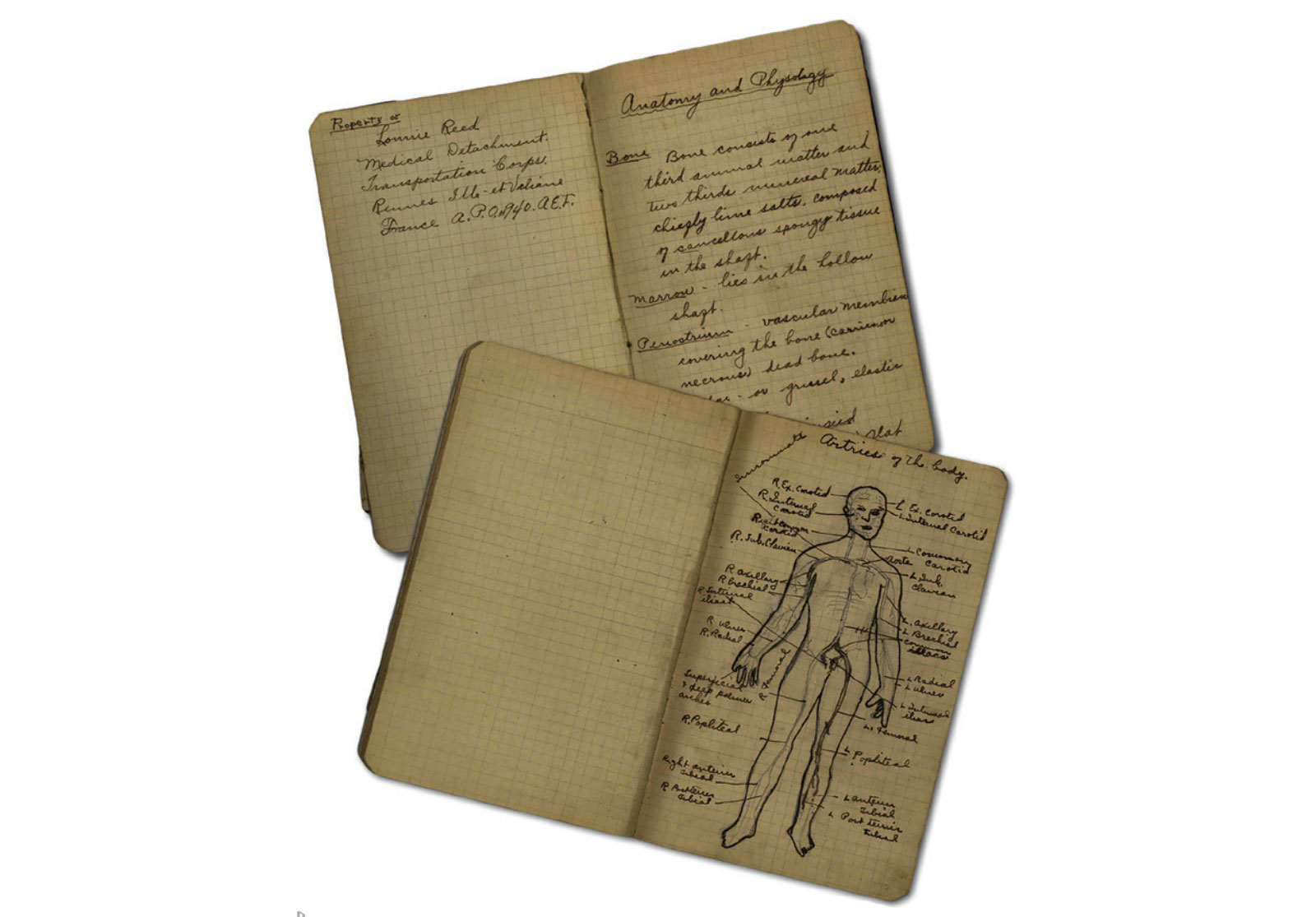
Notes and sketches by Lonnie taken during one of his medical classes at the AEF School in Rennes.”
Lonnie’s angst grew as the Army continually delayed the 61st Engineers’ departure. He was not alone. Most enlisted men directed their anger about being stuck in France not at the officers, who were in the same boat, but at Frenchmen, whom they believed were cheats out to rob the Americans after having saved France. Many doughboys believed rumors that France had charged the United States rent for American soldiers to use French trenches during the fighting.94 The French had their own negative opinions of the Americans and sometimes tensions exploded. On 4 June, after American soldiers accused by French police of shooting a civilian were not punished, a “big free for all fight” broke out in Rennes.
“I don’t know how many ‘frogs’ were injured but we have five men in quarters to-day as a result, one man has a bad cut with a knife another has his chin bones all beaten up where they had kicked him. The french don’t fight with their hands but use their feet like savages, the other fellows are just ‘banged up’ in general. Every american can lick five of them so I figures there must be over a couple dozen of natives layed up with various injuries.”95
Concurrently, a strike in Paris was slowing the 7th Division’s arrival in Rennes on its way to Brest. France’s 1914 Union sacrée, or “Sacred Union,” declaring solidarity regardless of class, religion, politics, or gender, had started fracturing under wartime pressures. French solidarity dissipated after the Armistice, and strikes became increasingly common in 1919, further hampering American demobilization.
On 13 June, the AEF’s spirits lowered once again when Stars and Stripes, a popular newspaper for soldiers, printed its final issue. “[T]he fellows feel like they were being deserted by their best friends, am sending a copy under second cover. It states that only one fourth of the A.E.F. is left at June 10th but it forgot to state anything definite concerning, about a dozen homesick lads here which form the enlisted personnel of the Med. Detch. Rennes.” Insult was added to injury as it had been announced some engineers were leaving, reducing the 61st Engineers’ companies to skeletons, but the medical detachment would remain. Lonnie claimed, “Rennes will be nothing less then a venereal segregation camp as soon as our fellows leave. Since Jan. 1st this city has held the highest venereal rate of the AEF . . . From what I have seen here I think the fellow who came over here and goes back as good as he comes, is more entitled to a D.S.C. [Distinguished Service Cross] then some of those at the front.”96 Perhaps his bad mood explains why he got in a fight. “The truble[sic] by a lad saying that a frog’s a frog, their all alike. This led on and on to a couple of raps on the chin. My fist is a little sore but I won the argument anyway. I sure was mad. I would have stepped in his face if he said another word,” he smugly wrote his sister.97 Less happily, he calculated the 61st Engineers had at least sixty more days of work. On 20 June, he reported finally putting his driving skills to good use transporting ambulances from Rennes to Camp de Coëtquidan to be shipped back to the United States, but otherwise, “The general attitude of the personnel of the camp [in Rennes] is, ‘I don’t give a dam’ and many of them are sure living up to it. This sure is some Army.”98 A week later there was a riot in camp. “This certainly is a sick bunch around here to-day and last night they nearly tore the barracks down. Shoes, mess kits, scoop shovels, cases of Jam + corned willie [beef], ball bats and stove pips filled the air for over a half hour. One fellow got knocked over by stopping a can of corned ‘willie’ on his head. The Guard house is so full that the men sleep in shifts of eight hours and work sixteen.”99
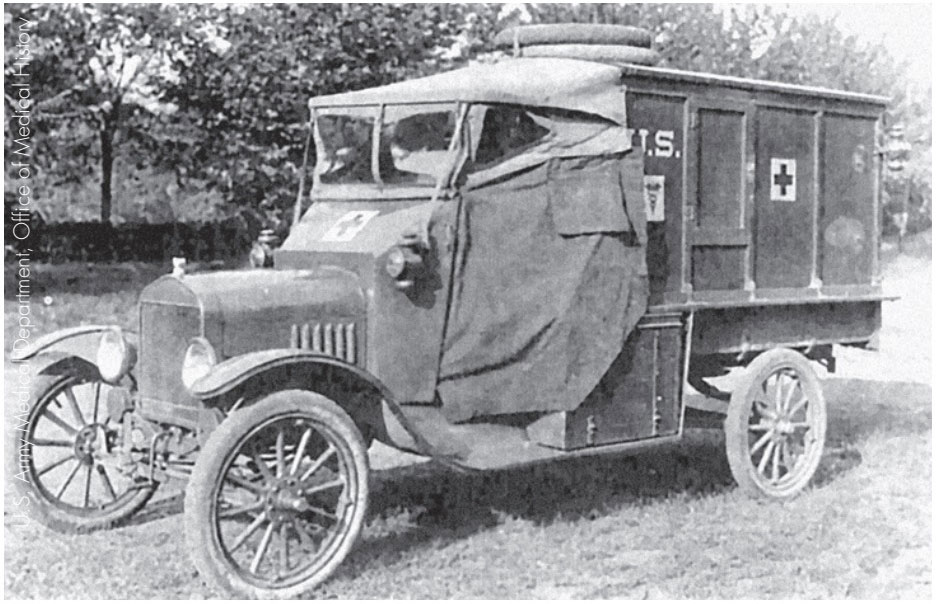
A typical U.S. Army ambulance.”
Lonnie was more accepting of his lot as he had occasion to drive the roads, ride the trains, and visit Odette and “Mamma” (as he now fondly called her mother) in Laval, but he too ached to go home to his real sister and mother. The French tried to force the Americans to divert troop trains from the main railway line to Brest to make room for passenger trains, but, as Lonnie testily wrote on 30 June, “The Americans won’t listen to them because of the loss of time + extra work it will mean. The French never said haul the troops that way a year ago, they certainly seem to have short memories.”100 The same day, the AEF school in Rennes, composed of 130 students and faculty, packed up and left. A peak of 314,167 men landed in the United States in June, and a total of 2.7 million soldiers had already been discharged.101 After combatants signed the Treaty of Versailles on 28 June, the AEF started sending home the Army of Occupation. Over 250,000 soldiers had stayed with the Third Army occupying the Coblenz bridgehead on the Rhine River in Germany ready to attack with other Allied armies if the peace negotiations collapsed. After celebrating 4 July with ice cream, lemonade, and waffles with “Y girls” visiting from St. Malo, Lonnie wrote, “Well you are all mistaken about me getting home this summer—It is true most all will be home by July 30 and for a while we had some hopes, but the 1st train of the Army of Occupation went thru’ this morning. Seven divisions of them to haul. The best we can expect now is during the first half of September.”102 The Army of Occupation quickly shrunk to 16,000 soldiers. Meanwhile, Lonnie worked during the day doing paperwork or driving ambulances, went on walks each evening, and often saw shows or films at the YMCA at night. On average, the 61st Engineers moved three troop trains a day through Rennes, and because he knew 105 troop trains were scheduled, he finally had an end in sight. A complication was the unknown number of freight trains that also had to be transported, Lonnie reported, “There is train after train load of salvage equiptment being hauled over the road. What even can be sold here is disposed of in that way, but there is a great amount to be carried back to the States.”103 On 11 July, Lonnie wrote that the New York Herald reported in a recent issue that all troops should return from France by November, but he still hoped to get home sooner.104
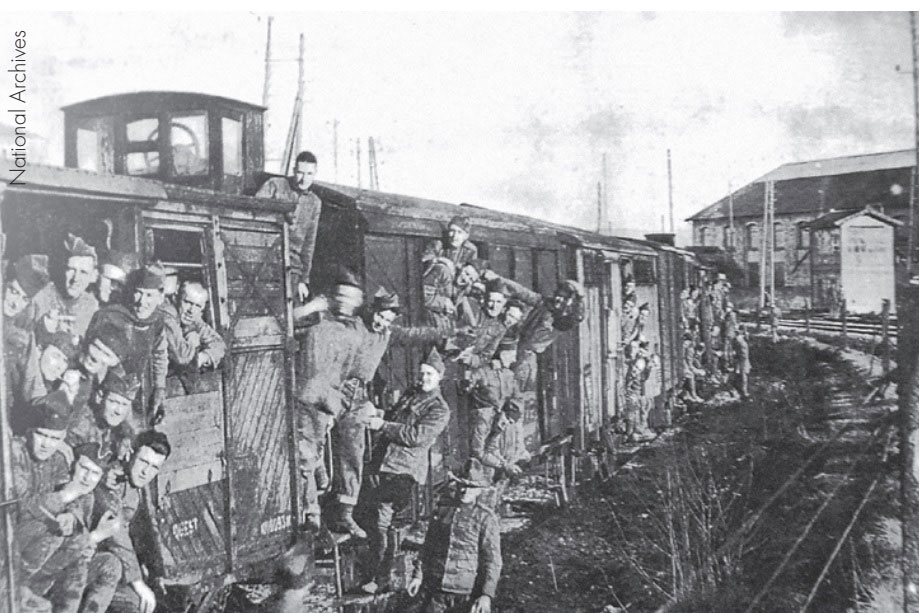
A troop train with U.S. troops loaded into boxcars.
In the meantime, Rennes suddenly had more than enough to do because “the entertainment side of Army life is now coming to the front as all the troops are nearly gone.”105 A dance was held weekly with YMCA girls from St. Malo, with a new group each week to ensure no inappropriate relationships blossomed. Lonnie noticed, “Since we started hauling the A of O [Army of Occupation] I notice a great change in our meals, at least for the present we are being fed much better than at any time I been at Rennes.”106 He also received another six-month service stripe for overseas duty, one of few doughboys who did. Life was good. On 28 July, Lonnie reported he had “a glorious week.” It began with “a big fete” between American and French athletes centering on a boxing match. “I drove the Ambulance up + had bandages, litters etc but didn’t have to use anything + sat best seat in the house.” He followed this with the usual YMCA dance. Finally, Lonnie won a coin toss for a spot with a group of soldiers going to tour battlefields across France. “Only two of us medics were allowed to go as the train could not accommodate all who wanted to go.”107 The nine-day excursion was a welcome adventure. Lonnie finally saw something of the front.
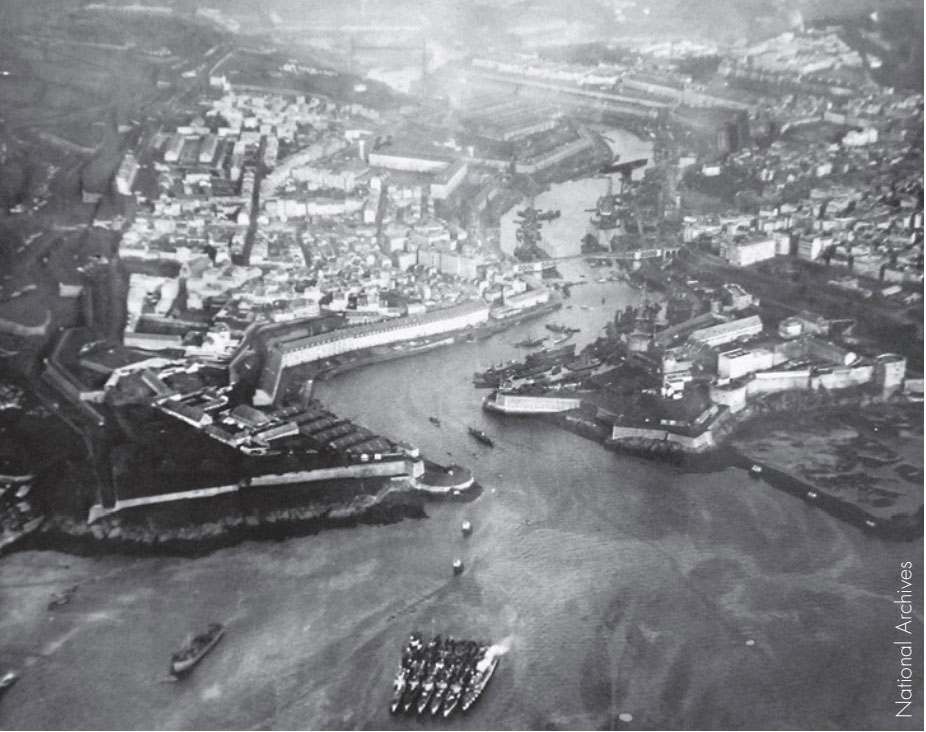
An aerial view of the Brest docks, c. 1918.
Lonnie finally saw something of the front. The soldiers took a train stopping in Le Mans for a day before continuing to Paris. After pausing in Paris they went on to spend a whole day at Belleau Wood where the AEF had halted a German attack in June 1918. Then the group headed to Reims. “[T]he city is one mass of ruins. The cathedreal is not beyond repairs if there is any archetects in the world who are willing to spend the time in doing the work. It may take a hundred yrs and will cost between 20 + 30 million dollars.” They also visited a French fort that had been captured by the Germans and toured the German lines, guided by a German prisoner of war, marveling at the underground shelters. The next stop was Verdun. There the French and German armies had slaughtered each other between February and December 1916. They toured the French forts and trenches. Then the group traveled to “the great American battlefront” of St. Mihiel, walking the ground where the AEF won its first independent victory in September 1918. A tour of a German fort followed. News that the 3d and 5th Divisions were departing reached the tour group causing it to turn back instead of continuing into Germany. Finally, on the way back, “We visited the great store houses + Gievers which also has the largest R[ailwa]y yards in the world + other points of interest of S.O.S.”108 When they arrived in Rennes, they discovered the major Lonnie worked with had been ordered home, so they quickly wrapped up accounts and transferred military property before parting ways. Once so proud of wearing a uniform, Lonnie now looked forward to shedding it for good. On 12 August, he claimed, “I have realized ever since I joined the Army, that by nature I was never intended for a soldier anyway.”109 Soon after, it was his turn to join the troops traveling westward to Brest.
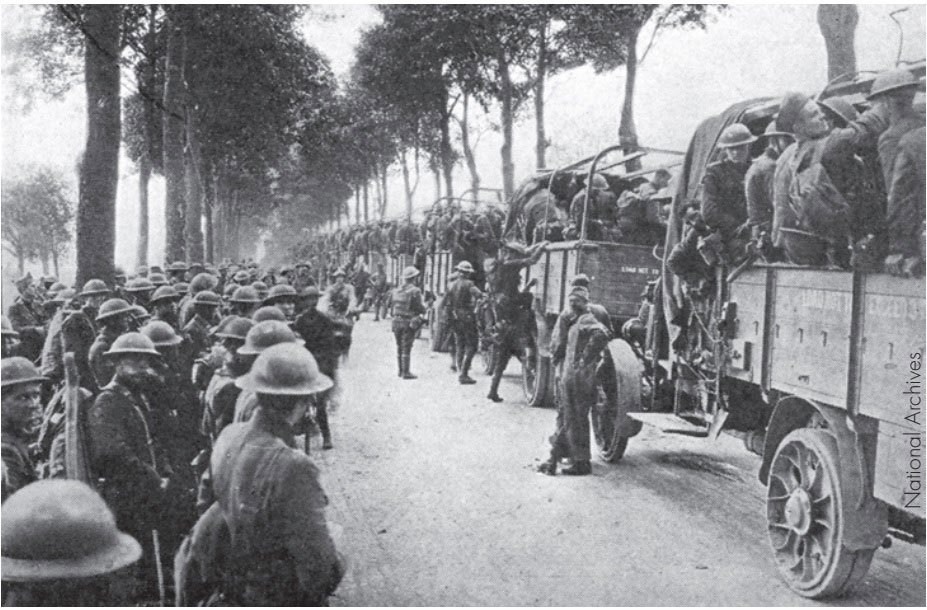
Troops load onto trucks as they prepare to head westward to the embarkation area.
The 61st Engineers decamped from Rennes on 24 August, but although the need for railway crews had lessened, the demand for medical personnel at embarkation ports had grown. Most of Lonnie’s medical detachment was sent to Camp Pontanézen, the main embarkation camp, but he and three others were sent to Camp de la Rampe in Brest itself. “The camp overlooks the docks + we see all the ships leave, it sure is tough. The worst of it is there is no telling when we’ll get out now perhaps not for some time.”110 On 1 September, General Pershing and his staff, along with their wives, boarded the USS Leviathan bound for the United States, and the AEF was disbanded.111 Lonnie saved a copy of the ship’s manifest with Pershing’s name as a souvenir.
The remaining Army forces were organized into American Forces in France (AFF) and American Forces in Germany (AFG). The embarkation camps in France were depressing places notorious for being muddy and filthy. Additionally, strict discipline and repeated equipment and medical inspections frustrated soldiers. If one soldier had lice, the whole unit would be held back for delousing. Anyone caught with VD was transferred to a venereal segregation camp.112
Troops returning home complained of being treated like cattle in disease-ridden camps, prompting a visit by the secretary of war to head off a congressional investigation.113 Seemingly arbitrary decisions of who stayed or left did not help morale as troops bounced between camps.
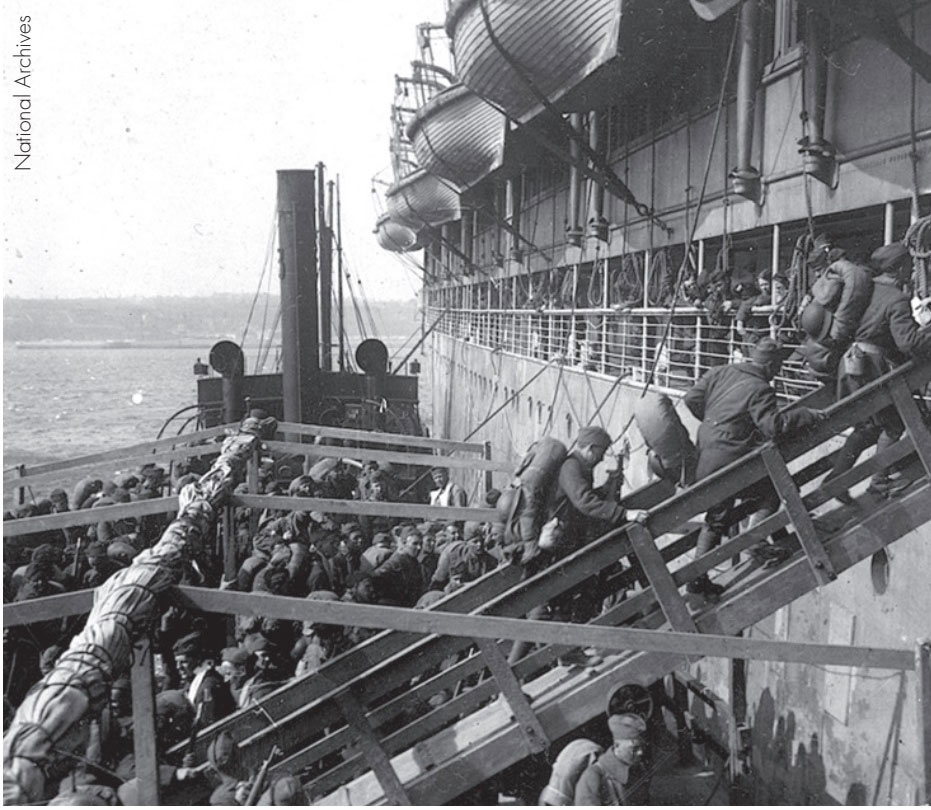
Soldiers board a troop transport at Brest for the voyage home, c. 1919.
On 9 September, Lonnie recorded that he had been transferred to Camp Gambette because the French were reclaiming control of Camp de la Rampe. “I have been talking my head off trying to get sent home, on account of school, and can convince everyone except those who can send me . . . If we have to say in Brest ‘til the last it will be in Feb. Don’t that sound cheerful.”114 Over the next few weeks, his group of medics was transferred to four different camps, “nothing but casuals just getting kicked from piller to post,” until he and another man were assigned to the dock dispensary verifying officers’ medical records before embarkation. The rest were sent to Camp Pontanézen, or a nearby venereal segregation camp. “I am always more fortunate then some anyway. I can at least be thankful Im not out at that camp . . . Now that I have been held so long + have cooled down a little I can almost be happy in my present surrounding. Congenial work, + practically no restrictions when off duty.”115 On 27 September, he estimated 20,000 to 30,000 men still awaited transport, 5,000 more under guard for being absent without leave, and 3,500 “Venereals.” Troopships left weekly, steadily reducing the U.S. population in Brest. “As fast as soldiers are relieved here, then places are being filled with french civilians, girls + women mostly because they are the best workers,” Lonnie reported.116 He had given up hope in arriving back in the United States in time for school, but still hoped to be home for the holidays.
Lonnie could not wait to leave France, but he also was concerned about conditions in the United States that he read about in papers and heard about from re-enlisted Americans arriving in Brest. After the Armistice, Congress had required the Army to discharge all soldiers enlisted after the United States went to war, regardless of any desire to remain, but on 28 February 1919, Congress altered this policy and allowed troops to volunteer to stay with the AFF or AFG and men discharged in the United States to re-enlist.117 On 7 October, Lonnie informed his sister that all the medics would finally be returning that month and soldiers interned in the venereal segregation camp were being sent home as quickly as possible, “[A]fter they are gone it will not be a disgrace to be held over here, as it is now.” He was shocked by the high prices of goods in the United States. “There are many American Civilians here who returned because of no work in the States, the stories they tell of our land of liberty are not very complementary. The after effects of this war will be worse than the war itself on a great many people, no doubt the country will be flooded with idle people for some time.”118 The situation in France was not good either, and fights between workers and marine guards in Brest broke out at night, often resulting in dead and wounded.119 French workers went on strike the next week resulting in a curfew and other restrictions as workers and police battled in the streets. On 16 October, Lonnie wrote, “The restrictions were raised here to-day since the strikers have gone back to work. The strikes have been causing riots, breaking windows looting etc. One soldier + two officers were killed during the past week and I don’t know how many frogs. No one has been allowed out of Quarters after 630 PM. Even the MPs were called in. We carried rifles when we went to the ‘Y’ for our meals. It was necessary to keep two men on nights in order to seal up + bandage the victims.”120 This would be Lonnie’s last letter from France.
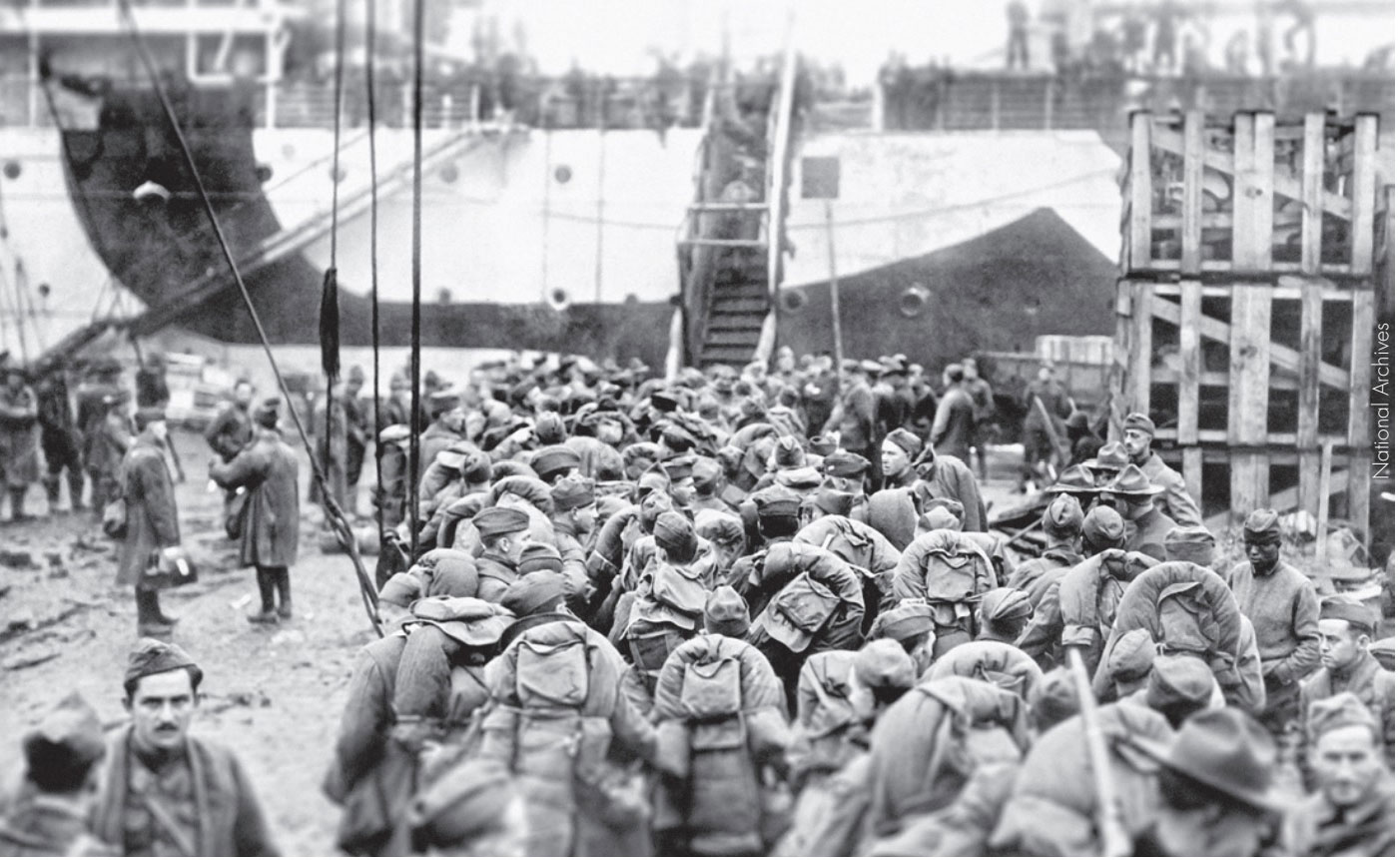
Troops waiting for their turn to board the ship home, c. 1919.
He was transferred to Camp Pontanézen on October 22 and soon boarded a ship for America. Only 8,000 soldiers remained with the AFF to finish transferring records and shipping materiel to the United States and turn over depots to the French. Most of these troops would board ships by December. Finally, on 8 January 1920, the last soldiers left, and the AFF was disbanded.121 Approximately 1,000,000 soldiers, or about half the AEF, had embarked at Brest before Base Section No. 5 closed.122 The Army’s demobilization was finished, although a token occupation force of 6,000 men remained with the AFG until 27 January 1923
Lonnie’s wartime experience encapsulates that of many men, whether service or combat troops, who were rushed through training, hurried to France, and then were just as quickly sent back to the United States. Many Americans expected a return to “normalcy” after the interruption of World War I.
Lonnie arrived home in Indiana in time for Christmas 1919. He found a job as an assistant cashier at Farmers & Traders State Bank. Later, after attending a special course in agriculture at Purdue University, he became an employee of the Chicago Produce Commission Association. He soon married Maude Evelyn Minch, born 28 October 1896, and together they had a daughter who was their only child. Lonnie later moved his family to Mission, Texas, to cultivate grapefruit. After this enterprise failed, he became a bookkeeper. Lonnie was a captain in the Texas State Guard in 1943 during World War II. Later, he and his wife moved to Albuquerque, New Mexico, where Lonnie continued a career as a bookkeeper. He remained an avid outdoorsman throughout his life. Maude died on 9 November 1984. Lonnie passed away on 6 November 1992 in Lubbock, Texas.
The Army successfully balanced the need for combat-ready forces in Europe in case the Armistice broke down and the demand of families and congress to send soldiers home “toot sweet.” Although many soldiers and thus, their families and congressmen, complained about the supposedly indifferent, inefficient, and slow process of demobilization, the Army’s decision to demobilize by units was remarkably fair, efficient, and fast. In fact, demobilization was too fast and too complete in the Army’s opinion, especially as Germany still needed to be occupied and Russia remained in chaos. The Army wanted a much larger peacetime force of 500,000 soldiers. Congress traditionally disliked the idea of a large standing army and did not want to bear the costs of supporting one. It also doubted enough volunteers could be recruited to maintain one, so it favored only a slightly enlarged force of 225,000 soldiers.123 The American public concurred.
The Army’s recruiting campaign beginning in March 1920 failed, fulfilling less than a third of its goal, and by June it only had 177,974 men.124 The National Defense Act of 1920, passed on 4 June, rejected the idea of universal military training, enhanced the National Guard and Reserve, and set a goal for an all volunteer force of 280,000 soldiers. The Army never came close to recruiting that many men during the interwar years. The United States had already withdrawn all its soldiers from Russia by this point and within a few years brought home troops from Germany, further lessening the need for men to fulfill America’s commitments abroad. The Army’s demobilization after World War I continued America’s venerable tradition of reverting to a small frontier constabulary after having mobilized a large army for a major war.
Editor’s Note The quotes from Private Reed’s letters are reproduced as they were written, with original spelling, punctuation, and capitalization.
Footnotes
1 Ltr, Pvt Alonzo E. Reed Jr. (Lonnie) to Mary E. Reed (Mother), 2 Feb 1919, Box 1, Folder 2, Pvt Alonzo E. Reed Jr Collection, AMEDD Center of History and Heritage, Archival Repository, Joint Base San Antonio–Fort–Sam Houston, Texas. (Hereinafter, AMEDD CHH Archives).
2 Richard S. Faulkner, Pershing’s Crusaders: The American Soldier in World War I (Lawrence: University Press of Kansas, 2017), pp. 20–22.
3 Edward M. Coffman, The War to End All Wars: The American Military Experience in World War I (Lexington: University Press of Kentucky, 1998), pp. 24–29.
4 Faulkner, Pershing’s Crusaders, p. 14.
5 Ltr, Lonnie to Alonzo E. Reed (Father), 4 May 1918, Box 1, Folder 5, AMEDD CHH Archives.
6 Ltr, Lonnie to Lucy Reed (Sister), 16 May 1918, Box 1, Folder 6, AMEDD CHH Archives.
7 Ltr, Lonnie to Mother, 15 May 1918, Box 1, Folder 2, AMEDD CHH Archives.
8 Ltr, Lonnie to Father, 8 May 1918, Box 1, Folder 5, AMEDD CHH Archives.
9 Mary C. Gillet, The Army Medical Department, 1917–1941, Army Historical Series (Washington, D.C.: U.S. Army Center of Military History, 2009), p. 50.
10 Ibid., p. 25.
11 Col. William N. Bispham, M.C., The Medical Department of the United States Army in the World War, Vol. VII, Training (Washington, D.C.: U.S. Government Printing Office, 1927), p. 247.
12 Ltr, Lonnie to Charles F. Reed (Brother), 17 May 1918, Box 2, Folder 1, AMEDD CHH Archives.
13 Ltr, Lonnie to Mother, 18 May 1918, Box 1, Folder 2, AMEDD CHH Archives
14 Ltr, Lonnie to Sister, 24 May 1918, Box 1, Folder 6, AMEDD CHH Archives.
15 Ltr, Lonnie to Mother, 8 Jun 1918, Box 1, Folder 2, AMEDD CHH Archives.
16 Ltr, Lonnie to Mother, 30 Jun 1918, Box 1, Folder 2, AMEDD CHH Archives.
17 Faulkner, Pershing’s Crusaders, p. 162.
18 Ltr, Lonnie to Mother, 2 Jul 1918, Box 1, Folder 2, AMEDD CHH Archives.
19 Ltr, Lonnie to Mother, 8 Jul 1918, Box 1, Folder 2, AMEDD CHH Archives.
20 Faulkner, Pershing’s Crusaders, p. 166.
21 For peak, see Ibid., p. 167; for total, see Coffman, The War to End All Wars, p. 227.
22 Quoted in Coffman, The War to End All Wars, p. 129.
23 Johnson Hagood, The Services of Supply: A Memoir of the Great War (Boston: Houghton Mifflin Company, 1927), pp. 155–57.
24 Faulkner, Pershing’s Crusaders, p. 351.
25 Ibid., p. 44.
26 Order of Battle of the United States Land Forces in the World War, American Expeditionary Forces, Vol. 1: General Headquarters, Armies, Army Corps, Services of Supply, Separate Forces (Washington D.C.: U.S. Army Center of Military History, 1988), pp. 67–68
27 Ltr, Lonnie to Mother, 3 Oct 1918, Box 1, Folder 2, AMEDD CHH Archives.
28 John C. Sparrow, History of Personnel Demobilization in the United States Army, Facsimile Edition (Washington, D.C.: U.S. Army Center of Military History, 1994), p. 11.
29 Ltr, Lonnie to E. L. Smith (Uncle), 9 Oct 1918, Box 2, Folder 3, AMEDD CHH Archives.
30 Jamie H. Cockfield, With Snow on Their Boots: The Tragic Odyssey of the Russian Expeditionary Force in France during World War I (New York: St. Martin’s Press, 1998), pp. 19–28, 59.
31 Ibid., pp. 68, 84, 88, 193–200.
32 Ibid., pp. 258–59.
33 Faulkner, Pershing’s Crusaders, p. 354.
34 Hagood, The Services of Supply, pp. 316–17.
35 Benjamin King, Richard C. Biggs, and Eric R. Criner, Spearhead of Logistics: A History of the U.S. Army Transportation Corps (Fort Eustis, Va: U.S. Army Transportation Center and Washington, D.C.: U.S. Army Center of Military History, 2001), p. 107.
36 Faulkner, Pershing’s Crusaders, p. 353.
37 Ltr, Lonnie to Mother, 18 Oct 1918, Box 1, Folder 2, AMEDD CHH Archives.
38 Ltr, Lonnie to Sister, 19 Nov 1918, Box 1, Folder 6, AMEDD CHH Archives.
39 Ltr, Lonnie to Mother, 14 Nov 1918, Box 1, Folder 2, AMEDD CHH Archives.
40 Carol R. Byerly, Fever of War: The Influenza Epidemic in the U.S. Army during World War I (New York: New York University Press, 2005), p. 87.
41 Ibid., pp. 71–80.
42 Faulkner, Pershing’s Crusaders, p. 178.
43 Byerly, Fever of War, p. 81.
44 Coffman, The War to End All Wars, p. 84.
45 Faulkner, Pershing’s Crusaders, p. 31.
46 Sparrow, History of Personnel Demobilization, pp. 12–15.
47 Jennifer D. Keene, Doughboys, the Great War, and the Remaking of America (Baltimore: Johns Hopkins University Press, 2001), p. 132.
48 Ltr, Lonnie to Mother, 24 Nov 1918, Box 1, Folder 2, AMEDD CHH Archives.
49 Ltr, Lonnie to Mother, 11 Dec 1918, Box 1, Folder 2, AMEDD CHH Archives.
50 Ltr, Lonnie to Mother, 15 Dec 1918, Box 1, Folder 5, AMEDD CHH Archives.
51 Faulkner, Pershing’s Crusaders, p. 186.
52 Ltr, Lonnie to Mother, 27 Dec 1918, Box 1, Folder 2, AMEDD CHH Archives.
53 Ltr, Lonnie to Mother, 7 Jan 1919, Box 1, Folder 3, AMEDD CHH Archives.
54 Ltr, Lonnie to Mother, 16 Jan 1919, Box 1, Folder 3, AMEDD CHH Archives.
55 Ltr, Lonnie to Sister, 27 Jan 1919, Box 1, Folder 7, AMEDD CHH Archives.
56 United States Army in the World War, 1917– 1919: Vol 10, Pt 1: The Armistice Agreement and Related Documents (Washington, D.C.: U.S. Army Center of Military History, 1991), pp. 173–74.
57 Ltr, Lonnie to Mother, 2 Feb 1919, Box 1, Folder 3, AMEDD CHH Archives.
58 Keene, Doughboys, p. 134.
59 Faulkner, Pershing’s Crusaders, p. 620.
60 Byerly, Fever of War, p. 146.
61 Ltr, Lonnie to Mother, 7 Feb 1919, Box 1, Folder 3, AMEDD CHH Archives; Ltr, Lonnie to Sister, 7 Feb 1919, Box 1, Folder 7, AMEDD CHH Archives.
62 Ltr, Lonnie to Mother, 25 Feb 1919, Box 1, Folder 3, AMEDD CHH Archives.
63 Coffman, The War to End All Wars, pp. 360–61; Keene, Doughboys, pp. 144–49.
64 Ltr, Lonnie to Mother, 25 Feb 1919, Box 1, Folder 3, AMEDD CHH Archives.
65 Ltr, Lonnie to Sister, 25 Feb 1919, Box 1, Folder 7, AMEDD CHH Archives.
66 Ltr, Lonnie to Mother, 1 Mar 1919, Box 1, Folder 3, AMEDD CHH Archives.
67 Ltr, Lonnie to Mother, 2 Mar 1919, Box 1, Folder 3, AMEDD CHH Archives.
68 Ltr, Lonnie to Sister, 2 Mar 1919, Box 1, Folder 7, AMEDD CHH Archives.
69 Margaret MacMillan, Paris 1919: Six Months that Changed the World (New York: Random House, 2002), pp. 98–104.
70 James G. Harbord, The American Army in France, 1917–1919 (Boston: Little, Brown, and Company, 1936), pp. 571–72.
71 Ltr, Lonnie to Mother, 24 Mar 1919, Box 1, Folder 3, AMEDD CHH Archives.
72 Sparrow, History of Personnel Demobilization, p. 18.
73 Ltr, Lonnie to Mother, 30 Mar 1919, Box 1, Folder 3, AMEDD CHH Archives.
74 Faulkner, Pershing’s Crusaders, p. 520.
75 Ibid., p. 521.
76 Ibid., p. 522.
77 Ltr, Lonnie to Mother, 1 Apr 1919, Box 1, Folder 3, AMEDD CHH Archives.
78 Ltr, Lonnie to Father, 10 Apr 1919, Box 1, Folder 5, AMEDD CHH Archives. 7
79 Ltr, Lonnie to Mother, 19 Apr 1919, Box 1, Folder 3, AMEDD CHH Archives.
80 Ltr, Lonnie to Sister, 4 May 1919, Box 1, Folder 7, AMEDD CHH Archives.
81 Faulkner, Pershing’s Crusaders, p. 621.
82 Ibid., p. 527.
83 Ltr, Lonnie to Mother, 11 May 1919, Box 1, Folder 4, AMEDD CHH Archives.
84 Faulkner, Pershing’s Crusaders, p. 390.
85 Gillet, The Army Medical Department, pp. 254–55, 374.
86 Ibid., pp. 149–51; Faulkner, Pershing’s Crusaders, p. 391.
87 Ltr, Lonnie to Mother, 15 May 1919, Box 1, Folder 4, AMEDD CHH Archives.
88 Faulkner, Pershing’s Crusaders, p. 625.
89 Keene, Doughboys, p. 40.
90 Ltr, Lonnie to Mother, 15 May 1919, Box 1, Folder 4, AMEDD CHH Archives.
91 Ltr, Lonnie to Mother, 21 May 1919, Box 1, Folder 4, AMEDD CHH Archives.
92 Ltr, Lonnie to Father, 26 May 1919, Box 1, Folder 5, AMEDD CHH Archives.
93 Ltr, Lonnie to Sister, 1 Jun 1919, Box 1, Folder 7, AMEDD CHH Archives.
94 Keene, Doughboys, pp. 136–37; Faulkner, Pershing’s Crusaders, p. 194.
95 Ltr, Lonnie to Alta Smith (Aunt), 5 Jun 1919, Box 2, Folder 2, AMEDD CHH Archives.
96 Ltr, Lonnie to Father, 13 Jun 1919, Box 1, Folder 5, AMEDD CHH Archives.
97 Ltr, Lonnie to Sister, 17 Jun 1919, Box 1, Folder 7, AMEDD CHH Archives.
98 Ltr, Lonnie to Sister, 20 Jun 1919, Box 1, Folder 7, AMEDD CHH Archives.
99 Ltr, Lonnie to Mother, 28 Jun 1919, Box 1, Folder 4, AMEDD CHH Archives.
100 Ltr, Lonnie to Aunt, 30 Jun 1919, Box 2, Folder 2, AMEDD CHH Archives.
101 Faulkner, Pershing’s Crusaders, p. 625; Coffman, The War to End All Wars, p. 357.
102 Ltr, Lonnie to Mother, 7 Jul 1919, Box 1, Folder 4, AMEDD CHH Archives.
103 Ltr, Lonnie to C. M. Horner (Grandfather), 10 Jul 1919, Box 2, Folder 4, AMEDD CHH Archives.
104 Ltr, Lonnie to Mother, 11 Jul 1919, Box 1, Folder 4, AMEDD CHH Archives.
105 Ibid.
106 Ltr, Lonnie to Mother, 12 Jul 1919, Box 1, Folder 4, AMEDD CHH Archives.
107 Ltr, Lonnie to Mother, 28 Jul 1919, Box 1, Folder 4, AMEDD CHH Archives.
108 Ltr, Lonnie to Mother, 7 Aug 1919, Box 1, Folder 4, AMEDD CHH Archives.
109 Ltr, Lonnie to Grandfather, 12 Aug 1919, Box 2, Folder 4, AMEDD CHH Archives.
110 Ltr, Lonnie to Mother, 2 Sep 1919, Box 1, Folder 4, AMEDD CHH Archives.
111 Coffman, The War to End All Wars, p. 359.
112 Faulkner, Pershing’s Crusaders, pp. 624– 25.
113 Keene, Doughboys, p. 141.
114 Ltr, Lonnie to Mother, 9 Sep 1919, Box 1, Folder 4, AMEDD CHH Archives.
115 Ltr, Lonnie to Mother, 27 Sep 1919, Box 1, Folder 4, AMEDD CHH Archives.
116 Ltr, Lonnie to Father, 30 Sep 1919, Box 1, Folder 5, AMEDD CHH Archives.
117 Sparrow, History of Personnel Demobilization, p. 18.
118 Ltr, Lonnie to Sister, 7 Oct 1919, Box 1, Folder 7, AMEDD CHH Archives.
119 Ibid.
120 Ltr, Lonnie to Mother, 16 Oct 1919, Box 1, Folder 4, AMEDD CHH Archives.
121 Order of Battle of the United States Land Forces in the World War, Vol. 1, pp. 392–94.
122 Ibid., p. 69.
123 Robert K. Griffith Jr., Men Wanted for the U.S. Army: America’s Experience With An All-Volunteer Army Between The World Wars (Westport, Conn.: Greenwood Press, 1982), pp. 9–14.
124 Ibid., pp. 37–40.
The U.S. Army and Amphibious Warfare During World
By John T. Greenwood
Army History The professional Bulletin of Army History PB-20-93-4 (No. 27) Washington, D.C. Summer 1993
This article is derived from a paper Doctor Greenwood originally prepared for the XVIII International Congress of Military History, Turin, Italy, September 1992.
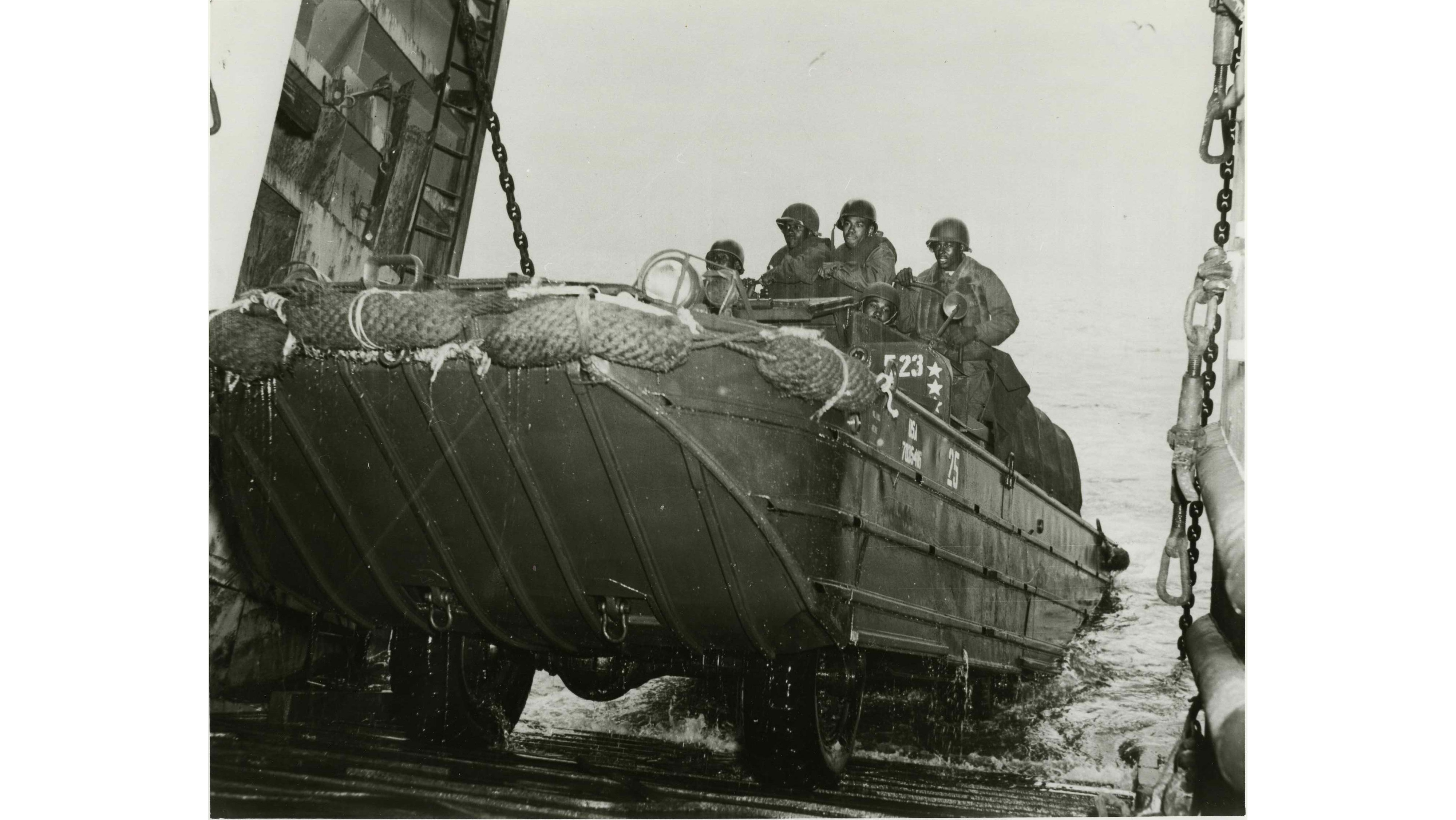
U.S. Army African American troops of the Amphibious Truck Companies supporting the 4th Marine Division at Iwo Jima landings return to the LST. Part of the research collection of the U.S. Army Transportation Museum.
For fifty years historians have written about World War II, but the U.S. Army's role in amphibious warfare remains a much neglected chapter in the history of the war and also of the American approach to joint and combined warfare.
A subject so vast and complex as the U.S. Army's role in amphibious warfare during World War II defies short and simplistic treatment. Thus, this article focuses mainly on the years from 1940 to 1943 when the foundations were laid for later success. These were difficult years of preparation, conflict, trial, and experimentation for the American armed forces. In the midst of a total global war, they struggled to mobilize the nation's human and industrial resources, make critical strategic decisions, hammer out policy and organizational compromises, and develop and integrate new weaponry and doctrines. In addition, they had to learn to work with each other and their allies to build a viable command structure for the planning and conduct of sophisticated joint and combined land, sea, and air operations.
In the. months following the American entry into the war in December 1941 the Allied political and military leaders confronted an abysmal worldwide strategic situation. Only a beleaguered Great Britain and a battered Soviet Union held out against Nazi Germany in Europe. In North Africa, British and Commonwealth forces were hard pressed. The Japanese had swiftly flooded across the Far East and western Pacific, seizing Malaya, Burma, the Netherlands East Indies, and the Philippines, while threatening India and Australia. The Anglo-American strategy was to contain and then defeat the Axis Powers by weakening their ability to wage war through strategic air attack and naval blockade, defeating their armed forces in field, liberating the occupied territories, and finally occupying Germany, Italy, and Japan. To do this, the Allied leaders adopted a global strategy of coordinated and complementary land, sea, and air campaigns in geographic theaters. Although at the outset the Allies lacked the means for serious amphibious operations anywhere, out of necessity such operations soon occupied a preeminent place in all of their strategic offensive planning.1
In staff talks during 1940-41, British and American planners decided that Germany, the primary and most dangerous Axis power, had to be defeated first. With no continental ally to provide access and ports as France had in the First World War, the U.S. and British Armies would have to fight their way back onto the Continent before they could bring the German Army to decisive battle. Remembering their horrible losses in World War I, British planners favored nibbling operations on the periphery while blockade and air attack weakened the Germans. American planners, however, emphasized that the Germans had to be confronted directly to be beaten. The most direct route to Germany was through France, which meant a cross-Channel amphibious invasion on an unprecedented scale against a heavily defended shore.2
Against Japan, amphibious warfare was me only approach that could penetrate the far-flung defensive barrier that Japanese victories had built by early 1942 to protect the home islands. Whether in the Pacific or Europe, the U.S. Army would have to play a leading role in such joint and combined operations because the nation's principal, trained, peacetime amphibious force, the Marine Corps, was simply too small and could not be quickly expanded to undertake such huge responsibilities.3
Although the Army had a long history of joint amphibious operations with the Navy, its focus on land operations left it little time for studying landing operations during the interwar years.4 However, the Army had distinct responsibilities for landing operations, "joint overseas expeditions," and joint war plans with the Navy under the Joint Army and Navy Board (Joint Board) that was established in 1903 to coordinate War and Navy Department planning and operations.5
With the publication of its Joint Overseas Expeditions in 1933 and then Joint Action of the Army and the Navy in 1935, the Joint Board laid out a coordinated approach to "joint overseas expeditions" and specific missions for the Army, Navy, and Marine Corps. For the Army these included "joint overseas movements" and "landing attacks against shore objectives."6
Joint Action was intended to secure "effective coordination" between the services, but it was beset with often vague and overlapping responsibilities between the sea and land forces. Nonetheless, it and the interservice workings of the Joint Board established sound foundations for the future development of joint war planning, command structures, and wartime operations, as well as for the establishment of the Joint Chiefs of Staff (JCS) after American entry into the war.7 The provisions of Joint Action's Chapter VI on joint overseas expeditions delineated many of the operational and tactical missions of the Army, Navy, and Marine Corps as well as of military and naval aviation.8 The basic doctrine for joint amphibious operations was thus largely set before the war, but the details of unified command would be resolved only during the war.9
The Joint Board's various interwar "color" joint basic war plans included potentially significant amphibious missions for the Army. This was especially so for Joint Army and Navy Basic War Plan ORANGE for a war against Japan in the Pacific and Far East and the various RAINBOW plans that emerged beginning in 1939.10
During the 1930s, Army and Navy joint training problems had included coastal defense and amphibious landings, especially in Hawaii, and small Army units had participated in three fleet landing exercises with the Navy and Marine Corps.11 The scale of the Army's involvement in amphibious planning and training barely reflected its potential responsibilities for such operations under existing war plans and doctrine as outlined in Joint Action.
By late 1939 the outbreak of the war in Europe reawakened the Army's interest in landing operations. The 3d Infantry Division at Fort Lewis, Washington, planned and conducted an amphibious training exercise of sorts with the Navy in January 1940 that culminated in a landing at Monterey, California. Both services performed poorly in the exercise and were highly critical of each other's efforts.12 The training exercise caused the War Department openly to question the Navy's capacity and willingness "to prepare or train on an adequate scale for amphibious operations."13 Together with a growing realization of the possible dimensions of its own future role in amphibious warfare, this experience sparked the Army's growing dissatisfaction with what it perceived to be the Navy's lack of commitment to amphibious training and operations that would have serious consequences for interservice cooperation during the next few years.14
The sudden collapse of France and expulsion of British forces from the Continent in May-June 1940 shocked American political, military, and naval leaders and compelled a full revision of the Joint Board's RAINBOW war plans. In reevaluating its plans for a European conflict, the Army realized that it had to use large-scale amphibious operations to fight its way onto the Continent before it could decisively come to grips with the German Army. In late June 1940 the War Department mandated amphibious training for the 1st Infantry Division on the east coast and the 3d Infantry Division on the west coast.15 To counter Axis threats to the Western Hemisphere, the following October the War Department ordered the formation of three "emergency expeditionary forces." Task Force 1, with the 1st Infantry Division, began training for an assault landing mission in early 1941.16 With little relevant recent experience in opposed landing operations, the Army turned to the Navy and Marine Corps for usable tactical doctrine.
Between the world wars, the Marine Corps and Navy developed a concept of amphibious warfare centered on an island-hopping naval war against Japan in the Pacific as laid out in various iterations of War Plan ORANGE.17 The Marine Corps' ideas were contained in its Tentative Manual for Landing Operations (1934), which the Navy adopted for its current landing operations manual, Fleet Training Publication 167 (FTP 167), Landing Operations Doctrine, United States Navy, 1938.18 The Army largely borrowed the Navy's FTP 167 as its initial doctrinal publication on amphibious operations, Field Manual (FM) 31-5, Landing Operations on Hostile Shores (June 1941).19
The Army made scant progress in joint amphibious training in 1940-41, except to identify how very much remained to be done. In June and September 1941 two joint training forces, each composed of an Army and Marine division with a partly integrated joint staff under a Marine general officer, were established under Navy command in the Atlantic and Pacific Fleets. Joint Army Navy training exercises in August 1941 and January 1942 only confirmed the joint amphibious force's lack of readiness for combat.20 In February 1942 Admiral Ernest J. King, Commander in Chief, U.S. Fleet (COMINCH), tried to remedy these problems by converting the two training forces into amphibious forces and restructuring them to include covering forces, transports, and an Army-Marine amphibious corps.21 By this time the Army's General Headquarters (GHQ) had grown so dissatisfied with the progress of joint amphibious training that it asked the War Department for approval to establish Army amphibious training centers.22
Although the prewar Joint Action gave the lead in amphibious operations to the Navy, the devastating losses suffered at Pearl Harbor and in the early Pacific campaigns and enormous global commitments forced it to focus mainly on rebuilding and expanding its major fleet combat elements—carriers, cruisers, battleships, and antisubmarine warfare vessels. Offensive joint amphibious operations received so little attention during the early months of 1942 that few cargo and troop transports or landing craft and boat crews were available for the training or operations of either the Army or Marine Corps. The Navy Department also restricted the growth of the fleet ' s amphibious elements by limiting the flow of personnel and the priorities assigned to landing craft production.23
In his Crusade in Europe, Dwight D. Eisenhower, then chief of the War Department's Operations Division (OPD), summed up the Army's deepening frustration over this lack of preparation:
As early as February 1942 we were worrying about the production of landing craft. Landing craft are primarily designed for offensive operations; it was difficult to develop a widespread interest in them when everyone was desperately concerned with defense At the time, however, the Navy was thinking only in terms of restoring the fleet. They were not particularly interested in landing craft for future offensives. But if we didn't start building we would never attack.24
This situation was critical to the Army because in both the U.S. Joint Chiefs of Staff and the Allied Combined Chiefs of Staff (CCS), General George C. Marshall, the Army Chief of Staff, and the War Department argued for an early invasion of Europe as part of the "Germany first" strategy. As finally approved in April 1942, this meant a quick buildup of American air and ground forces in the United Kingdom (BOLERO) with an emergency shore-to-shore cross-Channel invasion during 1942 (Sledgehammer) if a Soviet collapse appeared imminent and more developed variant for 1943 (ROUNDUP).25 Marshall and his key planners were greatly concerned about the deficiencies in landing craft, boat crews, and training and the lingering British reluctance to embrace these operations, both of which threatened the Army's basic strategic concept for the war in Europe.26
When in March 1942 King, now Chief of Naval Operations (CNO) and COM1NCH, could not commit the Navy to supporting such across-Channel undertaking with crews and boats, the Army offered to provide and train the required boat crews for the landing craft to carry the invasion force if the Navy would provide the boats. The Navy agreed to this informally, but never in a formal JCS paper.27 However, this decision soon initiated a major and continuing dialogue between the Army and Navy on the overall mission, organization, composition, and command of the amphibious corps assigned to the Amphibious Forces of the Atlantic and Pacific Fleets and on the prospective roles of amphibious forces in U.S. and Allied strategy.28 By early June Army planners thought they had a tentative agreement that put shore-to-shore cross-Channel operations under Army control with the Navy furnishing landing craft and instructors. Ship-to-shore training and operations remained a Navy responsibility. New amphibious corps would be formed for the Central and South Pacific and Southwest Pacific Area (SWPA) in 1942 as the offensive forces for those theaters.29
By late June, however, the Navy decided that the lack of landing craft, shipping, and Army combat divisions precluded any cross-Channel attack until at least 1943. That would give the Navy sufficient time to build landing craft and train boat crews, so the Navy ordered Rear Adm. H. Kent Hewitt, then commanding the Amphibious Force, Atlantic Fleet, to assume this training mission immediately. As a result, over the summer the Navy repeatedly postponed signing the tentative agreement with the Army until the decision for Torch rendered the shore-to-shore provisions moot.30 When the final JCS paper (JCS 81/1) was signed early in September 1942, it made no mention of the Army's shore-to-shore operations and concluded:
Amphibious operations are essentially the responsibility of the Navy. Until such time as the Marine Corps can be expanded to fulfill necessary requirements for present and projected strategy, it is recognized that selected Army units must be made available for training and participation in amphibious operations.31
Even the exact meaning and consequences of this paper were open to question, and further discussions dragged on into early 1943 before any final compromise agreement could be reached. As the Navy maneuvered itself back into full control of its role in amphibious warfare, this festering impasse adversely affected the Army's planning and preparation for amphibious operations. Out of a sense of frustration and urgency, throughout 1942 and into 1943 the Army pursued two separate amphibious training programs—one for ship-to-shore operations with the Navy and the other for shore-to-shore operations on its own.32
For ship-to-shore operations, the amphibious corps were the principal battleground. Here the initial discussions foundered on fundamental differences between the Army and the Navy and Marine Corps over the organization and role of the Army divisions in assault landings.33 The Navy and Marine Corps wanted specialized Army light divisions that would be tailored for and used only in amphibious operations. The Army Ground Forces (AGF), which replaced GHQ with the March 1942 War Department reorganization, were adamant that all Army divisions be standardized for large-scale land operations and not specialized for limited missions.34 This disagreement further hardened the Army's view on the Navy's disinterest in amphibious operations as well as its own fundamental differences with the Marine Corps on amphibious organization and doctrine.35
In this area, as in many others, an underlying cause for Army-Navy friction was the absence of a unified national defense strategy and command structure, something the Joint Board could not provide in the prewar years and which was only then being worked out following the establishment of the Joint Chiefs of Staff and an integrated joint staff. The Army and the Navy/Marine Corps concepts of amphibious operations differed substantially because of the services' fundamentally different missions and organization. To the Army amphibious operations were invasions, attacks with unlimited objectives, and the necessary first step in a long and arduous land campaign with huge logistical requirements. To the Navy and Marine Corps they were seizures of specific, limited objectives, usually islands or island groups, that could become advance bases for a continuing naval campaign.36 Hence, in amphibious operations Army planners always had operational and logistical considerations that were far beyond the concerns of the Navy or the capabilities of the marines.
In a 9 April 1942 memorandum that he drafted for Marshall to send to King, Eisenhower clearly delineated the differences between the services on amphibious forces and the differing operational requirements in the Atlantic and Pacific:
In the Atlantic we may become involved in a cross-channel effort, with the consequent need for landing equipment designed especially for that purpose. Moreover any amphibious operations will probably be merely the spearhead of a prolonged, heavy, land operation. This is the type of task for which Army divisional and higher organization is definitely pointed. ... In the Pacific, offensive operations for the next year or more promise to comprise a series of landing operations from shipboard to small islands with relatively minor forces. This is the type of amphibious warfare for which the Marines have apparently been specially organized.37
On 20 March 1942, shortly after the Navy first agreed to the Army's new amphibious role, the War Department directed the Army Ground Forces to train twelve divisions for shore-to-shore amphibious operations. The AGF was to develop doctrine, train tactical units, and handle "all phases of the operations of Aimy units involved in embarking troops and equipment in small boats on land, the approach to and landing on a hostile beach, the establishment of a beachhead, and the preparation and initiation of an attack inland."38
At the same time, the War Department charged the Services of Supply (SOS) with "the organization, training, supply and equipment of boat operating and maintenance units, the operation of transportation facilities for landing operations, and for the equipment and training of shore parties." SOS directed the Corps of Engineers to establish an amphibious command to organize and train engineer units that would in turn train with the tactical units, operate landing craft in shore-to-shore combat operations, and direct the shore parties to handle the logistical lifelines over the beaches.39 This was a natural choice because the engineers handled all of the Army's river crossing operations and also had extensive experience with small boats in its peacetime civil works functions on the nation's harbors and inland waterways.
In June 1942 the chief of engineers established the Engineer Amphibian Command (EAQ) at Camp Edwards, Massachusetts, alongside the AGF's newly established Amphibious Training Command (ATC). The EAC was to organize and train the eighteen engineer boat operating regiments, seven engineer boat maintenance battalions, and all supporting units.40 The engineers were limited to only 36-foot LCVs (Landing Craft, Vehicle) and 50-foot LCMs (Landing Craft, Mechanized), even though they questioned the use of such small boats in the English Channel. Limited production meant few of these boats were even available during the summer for training the amphibian units which were then to train six of the proposed twelve assault divisions at Camp Edwards before moving to Carrabelle, Florida, where year-round training could be conducted. With insufficient landing craft and crews, any meaningful training was hard to achieve. Frequent changes in force structure and missions, uncertainty about the Army's long-term role in amphibious training, inadequate facilities, lack of landing craft, and the continuing conflict between the Army commands over missions, functions, and resources throughout the summer only exacerbated the already considerable problems confronting this part of the Army's struggling amphibious training program.41
After analyzing their mission, Brig. Gen. Daniel C. Noce, EAC commander, and Col. Arthur G. Trudeau, his chief of staff, realized that they lacked an adequate shore party structure. Shore-to-shore operations required an Army organization that combined the functions of a Navy beach party and a Marine shore party but did not lose unity of command at the waterline. Hence, they created the engineer shore regiment of three battalions to operate on both the near and far shores.42 This regiment was then integrated with the existing boat regiment and service units to create an engineer amphibian brigade (renamed engineer special brigade in 1943) of one boat and one shore regiment, each with three battalions, that could lift and then support one division. A boat and shore battalion together could support a regimental combat team (RCT), with individual boat and shore companies supporting the combat battalions. With its assigned quartermaster, ordnance, medical, and signal units, an EAB numbered 363 officers, 21 warrant officers, 6,898 men, and 180 LCVPs (Landing Craft, Vehicle and Personnel) and LCMs.43
Experience during the summer of 1942 at Cape Cod resulted in significant refinements in doctrine, tactics, and organization as well as numerous improvements in landing craft, navigation and communications equipment, beach clearance and crossing techniques and equipment, and shore operations. Considerable effort was devoted to developing efficient organization and procedures for shore operations, which the EAC knew would be critical to the success of any landing. Although refined through later combat experience, the basic shore operating structure and procedures developed by the Engineer Amphibian Command were subsequently used by the engineer special brigades and the specially trained engineer combat units that supported all of the Army's wartime amphibious operations.44 New techniques and equipment, especially Marine Corps' Landing Vehicle, Tracked (LVT), and the Army's amphibious truck, the DUKW, were tested and adopted for a variety of assault and support operations. Both vehicles saw extensive service in most later amphibious operations and proved extremely valuable to both the Army and Marine Corps.45
The summer's training indicated that separate boat and shore battalions normally supported one RCT. Thus, EAC reorganized the 2d EAB into three amphibian regiments, later renamed engineer boat and shore regiments (EBSRs), each with a boat and shore battalion. This structure was much more flexible, aligned better with the triangular division's three RCTs, and allowed the regiments to operate independently with RCTs or task forces.46 Even as the EAC was struggling through the difficult summer of 1942, decisions were being taken that would radically alter its future.
Neither the U.S. Navy nor the British ever really liked Marshall's concept for the cross-Channel attack for 1942 or 1943. As for the U.S. Navy, King saw its future in the Pacific where it could largely control operations and not in Europe where it couldn't.47 The British Prime Minister, Winston S. Churchill, and his military and naval leaders preferred an easier nut to crack, namely the Mediterranean and Italy, and more and better landing craft before trying a direct attack against the tougher Channel coast and the Germans. Even after they accepted the cross-Channel plan, the British campaigned to replace it with an early invasion of North Africa, Operations GYMNAST or SUPER-GYMNAST.48
The British, moreover, emphasized that the smaller landing craft (LCVs and LCMs) that the Navy had developed for ship-to-shore operations and that the Army intended to use would have great difficulty in the rough waters of the Channel. They wanted larger landing craft that could handle the Channel and could also get to the theater of operations on their own rather than take up valuable shipping space. Hence, new generations of larger shore-to-shore landing craft were designed and built—the Landing Ship, Tank (LST), Landing Craft, Tank (LCT), and Landing Craft, Infantry (Large) [LQ(L)]. These landing craft altered the nature of amphibious operations when they reached the Allied fleets in meaningful numbers from late 1942 on, but their production was not a high priority for the Navy during most of 1942.49
In May-June 1942 the Navy changed course from refusing to accept responsibility for amphibious training and operations for the cross-Channel attack to demanding its rightful place in charge of them in accordance with Joint Action. Ongoing changes in Allied strategic planning and continuing Army-Navy discussions of amphibious operations certainly helped shape this reversal, as did the Navy's aforementioned doubts about the likelihood of any cross-Channel attack. However, this change was also heavily influenced by conversations between Lord Louis Mountbatten, commander of the British Combined Operations Headquarters (COHQ) who was sent to talk the U.S. leaders into the North African venture, and King during the Anglo-American meetings in Washington and Hyde Park, New York, in June 1942.50
After discussions with Marshall and King on SLEDGEHAMMER-ROUNDUP, Mountbatten met separately with King and personally warned him not to allow the U.S. Army to operate the landing craft in any cross-Channel attack. "You are selling the birthright of the Navy. We can't stop the invasion of Europe," Mountbatten told King. If the Navy allowed the Army to carry out these operations, Mountbatten continued, and "the Army puts itself ashore,... in the long run you don't need a Navy."51 The very next day King ordered Hewitt to London for orientation on amphibious operations with Mountbatten's Combined Operations Headquarters. Upon his return, Hewitt took over training the amphibious corps and planning the Navy ' s part in SLEDGEHAMMER-ROUNDUΡ amphibious operations.52
The Navy's change was also reflected in its position on the command structure for SLEDGEHAMMER ROUNDUP. King and Marshall agreed in May 1942 that U.S. land and sea forces would come under the Army in accordance with unity of command provisions of Joint Action when the Army ' s European Theater of Operations (ETOUSA or ETO) was established.53 Lt. Gen. Dwight D. Eisenhower, the newly designated U.S. theater and Army commander, upon his arrival in London in late June affirmed a unified command for amphibious training and operations against the Continent based on the King Marshall agreement.54 First established as the Advanced Group of Hewitt's Amphibious Force, Atlantic Fleet, this command soon became the ETO's Maritime Command and in October the Amphibious Force, Europe, which remained in charge of U.S. naval planning for the cross Channel attack even as Allied naval forces prepared for TORCH.55
When the cross-Channel invasion (SLEDGEHAMMER-Roundup) gave way to Operation TORCH against French North Africa in July, the Army's entire amphibious program was thrown into question. From a shore-to-shore operation in Army-manned boats under Army command, the amphibious emphasis in Europe shifted to ship-to-shore operations, which were the Navy's realm. Combined with Eisenhower's theater policy based on the King-Marshall agreement and Joint Action, this meant that the U.S. Navy in Europe now controlled all ship-to shore and shore-to-shore operations and the Army all shore operations. When the 1st Engineer Amphibian Brigade arrived in the United Kingdom in August, it was assigned to the Navy's Maritime Command. With the postponement on the cross-Channel operation, the brigade was soon assigned to TORCH, stripped of its boat regiment, and limited to shore operations.56
The Army's focus now shifted abruptly to the Amphibious Corps of the Atlantic Fleet's Amphibious Force, its principal training force in the United States for ship-to-shore amphibious operations. With the 1st Marine Division's move to the Pacific, this corps was all Army—the 3d and 9th Infantry and 2d Armored Divisions. The corps was soon designated the Western Task Force, the Army component of a United States joint expeditionary force for TORCH, under command of Maj. Gen. George S. Patton, Jr.57 In the United Kingdom, the 1st and 34th Infantry and 1st Armored Divisions, the only Army divisions with amphibious training then outside the United States, prepared for their landing operations with the 1st Engineer Amphibian Brigade and the Royal Navy.58
Operating under guidance from the JCS, the War Department, and Eisenhower's newly established Allied Forces Headquarters (AFHQ), Patton would plan and comm and the landings and operations of American ground forces in French Morocco while Hewitt, commanding the Western Naval Task Force, headed naval planning and operations. Although the planning was done separately, Patton and the War Department tacitly accepted unity of command under Hewitt from after the convoy sailed until the ground forces had established themselves ashore.59 Eisenhower's policy on unity of command and its partial extension to the Western Task Force were major steps toward resolving the troubling question of command of joint amphibious operations and the transition from naval to land commander.60
In Europe and the Mediterranean from Torch on, joint amphibious assault forces came under naval command until lodgments were successful, at which time command transferred to the ground commanders.61 With some theater variations, Eisenhower's approach became standard for most of the Army's wartime joint amphibious operations and was also similar to the unified command arrangements for U. S. joint operations approved by the JCS in Amil 1943.62
By September 1942, the EAC's once bright future had quickly faded. Decisions at the joint and combined levels on TORCH resulted in cutting the planned eighteen engineer regiments to eight engineer amphibian brigades and then to three operational and two reserve brigades.63 When the 1st Brigade went to England, the 2d Brigade then became the training brigade with the AGF's Amphibious Training Command. But its future and that of the 3d Brigade, whose full activation was placed on hold, were now bleak indeed as many of their trained amphibian personnel were siphoned off as cadres for the shore engineer units (36th and 540th Engineer Regiments) that would support Patton's TORCH landings.64
Just as the situation appeared lost altogether, Col. Arthur G. Trudeau, the EAC's chief of staff, learned that General Douglas MacArthur's Southwest Pacific Area (SWPA) lacked the landing craft and amphibious forces to sustain any offensive operations. He quickly saw a future for the amphibian brigades and approached the Services of Supply and the War Department ' s Operations Division with a plan to send the brigades to MacArthur. Within weeks the Army and Joint Chiefs agreed to deploy the 2d, 3d, and 4th EABs to SWPA along with a complete landing craft assembly unit and plant.65 In November 1942, the 2d Engineer Amphibian Brigade was ordered to Australia where it arrived early in 1943. MacArthur enthusiastically welcomed these units because their small craft were ideally suited for moving men, equipment, and supplies in the shallow coastal and island-studded waters in his theater.66 This was especially true along the north coast of Papua-New Guinea where the Navy had feared to go because of Japanese land-based aviation at Rabaul on New Britain.67 These actions so significantly increased the Navy's interest in providing amphibious support to MacArthur that in December 1942, after several months of delay, it hastily created the 7th Amphibious Force under Admiral Dan Barbey.68
The year-long tug-of-war between the Army and Navy and within the Army itself over organization, planning, and training for amphibious operations finally ended in February and March 1943. Although many wrinkles remained to be ironed out, the TORCH landings in November 1942 had clearly demonstrated that the Army and Navy could successfully plan and conduct a large joint and combined amphibious operation under unified command.69 Moreover, the long and often acrimonious discussions on amphibious training and operations between the Army and the Navy and Marine Cots had eventually produced a basic understanding on respective roles and missions, organization, doctrine, and command that generally worked well during the rest of the war.70 Marshall agreed that the Navy would take over all amphibious training in return for its support for the Army's future operations.71 However, implementation of this agreement was subject to the decision of the U.S. overseas theater commanders, who controlled the organization and training of the joint forces assigned to them.
Now convinced of the importance of the Army's amphibian brigades, MacArthur objected to altering the plans for training and deploying the 3d and 4th EABs that were scheduled to join the 2d EAB.72 While accepting MacArthur's demand, the framers of March 1943 Army Navy agreement on amphibious training agreed to close the Army's Amphibious Training Command soon. The Engineer Amphibian Command would disband in early 1944 after the 4th Special Brigade shipped out and elements of the 5th and 6th Special Brigades were trained for the invasion of France and sent to England.73
From June 1943 on, the three engineer special brigades and 7th Amphibious Force underpinned MacArthur's strategy in the Southwest Pacific using the 800LCVPs and 2,000LCMs churned out by the engineer boat assembly plants in Australia and New Guinea. The brigades conducted 36 major and 344 secondary shore-to-shore and ship-to-shore operations and made 148 combat landings in carrying Army, Marine Corps, and Australian Army assault forces from Nassau Bay, New Guinea, to Lingayen Gulf, Luzon, in the Philippines and on to the East Indies. Retaining their original boat and shore organization, these brigades employed Army amphibious doctrine and operated both under Army command and with the Navy's 7th Amphibious Force. Their operations were an exacting and successful test of the Army's original 1942 concept of amphibious warfare based on integrated boat and shore operations under Army command.74
In addition to their combat operations, these units also handled many of the theater's logistical lifelines, carrying 4.5 million passengers and 3 million tons of supplies while covering over 7.75 million miles.75 The shore battalions also did much of the construction that sustained the air and ground combat forces and provided the logistical infrastructure for their operations.
Mac Arthur wrote to General Marshall on 19 March 1945:
In the succession of amphibious operations up the coast of New Guinea to Morotai, thence to the Philippines, the performance of the 2d, 3d and 4th Engineer Special Brigades has been outstanding. The soundness of the decision in 1942 to form organizations of this type has been borne out in all action in which they have participated. These units have contributed much to the rapid and successful prosecution of the war in the Southwest Pacific Area.76
The Army's role in amphibious operations during World War II was large and critical, but it remains little known and studied today. U.S. Army forces participated either in the assault or support phases in 5 8 of 61 wartime U.S. amphibious operations. In the Pacific theaters, the Army and Navy conducted 39 major amphibious operations involving a regimental combat team (RCT) or larger unit. The Army also took part with the Navy and Marine Corps in six major assault operations and supported seven others.77
In Europe and the Mediterranean, together with Allied forces the U.S. Army and Navy were responsible for all six of the largest amphibious operations ever conducted—North Africa, Sicily, Salerno, Anzio, Normandy, and southern France. Among these was the largest and most complex joint and combined amphibious operation ever undertaken, Operation OVERLORD, on 6 June 1944. Gearing the way across the beaches for the U.S. assault forces and then supplying them once the beachhead was established were the 1st, 5th, and 6th Engineer Special Brigades. Once it was finished in Europe, the 1st ESB was shipped to the Pacific where it handled the shore operations during the Okinawa campaign and was readying for the invasion of Japan with the three other special brigades when the war ended.78 The EAC had indeed accomplished its original mission, and much more.
The early years of American involvement in World War II were difficult years of preparation, adjustment, conflict, and compromise for the U.S. armed forces. In the midst of a total global war, they had to learn to work with each other and their allies to plan and conduct sophisticated joint and combined land, sea, and air operations on an unprecedented scale. Although a trying experience, the Army's compromise with the Navy on policy, doctrine, and organization for amphibious war fare contributed importantly to the shaping of its wartime relationship with the U.S. Navy, the development of overall Allied strategy, and the conduct of the war against the Axis. These wartime experiences also significantly influenced the development of postwar U.S. joint and combined warfare doctrine and organization as well as the Army's role therein.
In his Third Official Report of December 1945 to the Secretary of the Navy Fleet Admiral King clearly out lined the importance of this joint wartime experience:
The outstanding development of this war, in the field of joint undertakings, was the perfection of amphibious operations, the most difficult of all operations in modem warfare. Our success in all such operations, from Normandy to Okinawa, involved huge quantities of specialized equipment, exhaustive study and planning, and thorough training as well as complete integration of all forces, under unified command.... Integration and unification characterized every amphibious operation of the war and all were successful.79
The author hopes that this present study will spur a renewed study of the U.S. Army's critical and complex role at the policy and operational levels in these joint and combined amphibious operations, for there is much yet to be learned that would benefit today's military leaders and historians.
Footnotes
1 Maurice Matloff and Edwin M. Snell, Strategic Planning for Coalition Warfare: 1941-1942 (Washington, D.C.: U.S. Army Center of Military History [Here after CMH], 1953), passim; Col. A. T. Mason, USMC, JCS Special Monograph on Amphibious Warfare (unpublished draft), ch. 2, "Domestic Affairs—1942: Arcadia, Organization and Training, Ships and Craft," pp. 11, 29ff, File HRC 451.94 "Amphibious Warfare Before WW II," in Historical Resources Branch, CMH, Washington, D.C.; ABC-4/CS-1, Memorandum by the U.S. and British Chiefs of Staff, "American-British Strategy,"31 Dec41,in J.R.M. Butler, Grand Strategy, vol. 2, pt. 2: June 1941-August 1942 (London: HMSO, 1964), pp. 669-72.
2 Samuel Eliot Morison, History of U.S. Naval Operations in World War II, vol. 1: The Battle of the Atlantic, September 1939-May 1943 (Boston: Little, Brown and Company, 1964), pp. 4-14; Mason, ch. 4, "Amphibious Planning—1942:1, Abortive Attempts: GYMNAST, Dakar, Cross-ChannelInvasion,"pp.24-48; Memorandum,G.C. Marshall, "Operations in Western Europe," in Butler, pp. 675-81; General Albert C. Wedemeyer, Wedemeyer Reports! (New York: Henry Holt & Company, 1958), pp. 129-46. An Army planner, Wedemeyer accompanied General Marshall to London in April 1942 and then participated in many of the key meetings on the cross-Channel invasion throughout the summer of 1942.
3 Jeter A. Isely and Philip A. Crowl, The United States Marines and Amphibious War: Its Theory, and Its Practice in the Pacific (Princeton, N.J.: Princeton University Press, 1951), pp. 14-71, passim; Lt. Col. Kenneth J. Clifford, USMCR, Progress and Purpose: A Develop mental History of the United States Marine Corps 1900-1970 (Washington, D.C.: History and Museums Division, Headquarters, U.S. Marine Corps, 1973), pp. 25-60, passim.
4 Contrary to the contentions of many authorities, especially Isely and Crowl, the U.S. Army did not entirely neglect the study of amphibious operations during the interwar years. At both the Army War College and Command and General Staff School, landing operations were studied, but the course time devoted was relatively small. Col. Henry G. Gole, U.S. Army, Retired, has done extensive research in Army War College records which reveals that the students and faculty at the Army War College during the 1930s did extensive work on planning for Allied coalition warfare. Their work eventually shaped much of the American thinking that went into the prewar Rainbow war plans as well as Allied wartime strategy. See Henry G. Gole, "War Planning at the U.S. Army War College, 1934-40, The Road to RAINBOW," Army History 25 (Winter 1993): 13-28. The War Plans Division of the War Department General Staff was also deeply involved in planning landing operations as part of its ongoing duties. Individual Army officers also at tended the Naval War College, where the study of landing operations was much more intense. Moreover, officers devoted much of their own time to professional development, which often included the study of military history. While assigned to the Hawaiian Department in the mid-1930s, Col. George S. Patton, Jr., reviewed the defense of the islands and their vulnerability to Japanese seaborne attack. This led him to research the Gallipoli campaign of 1915 and amphibious operations in general, from which he drew numerous lessons on the planning and conduct of such operations that can be found in his 128-page study of the Gallipoli operation, completed in August 1936. From this work Patton gained the reputation as one of the Army's experts on amphibious operations, which later helped land him the job as commander of the Western Task Force in Operation Torch. This knowledge was subsequently put to good use in Torch and then in the invasion of Sicily, Operation HUSKY. See G.S. Patton, Jr., "The Defense of Gallipoli: A General Staff Study," 1936, in the Patton Papers, Library of Congress, copy in the Patton Collection, Special Collections, U.S. Military Academy Library, West Point, N.Y.; see also Martin Blumenson, The Patton Papers, 1885 1940, vol. 2 (Boston: Houghton Mifflin, 1972), pp. 997-1001.
5 Vemon E. Davis, The History of the Joint Chiefs of Staff in World War II: Organizational Development, vol. 1: Origin of the Joint and Combined Chiefs of Staff (Washington, D.C.: Historical Division, JCS, 1972), pp. 5-6,22-26.
6 The Joint Board, Joint Action of the Army and the Navy, JB no. 350 (Washington, D.C.: Government Printing Office, 1935). See especially ch. 6, "Joint Overseas Expeditions," pp. 69-112, which largely reprinted the previously published Joint Overseas Expeditions. Copy in the CMH Library, Washington, D.C. Vice Adm. George C. Dyer, USN (Ret.), The Amphibians Came to Conquer: The Story of Admiral Richmond Kelly Turner (Washington, D.C.: Department of the Navy, 1971), pp. 213-14; Mason, ch. 1, "Amphibious Warfare before World War II," pp. 16-23, File HRC 451.94 "Amphibious Warfare Before WW II," in Historical Records Branch, CMH.
7 Davis, vol. 1, pp. 25-26.
8 Mason, ch. 1, pp. 16-25.
9 Davis, vol. 1, passim; Mason, ch. 3, "More Domestic Affairs—Command," pp. 1-15; Mason, ch. 1, pp. 44-53, 70-72. The provisions of Joint Action concerning command of joint Army-Navy operations specified either coordination through "unity of command" or "limited unity of command," with command vested in the service with "paramount interest." The president could also direct "unity of command" in the operation. Moreover, numerous caveats, especially in chapter 1, para 4c, prevented one service from infringing on the basic interests, functions, and operations of the other. In Change 2 of 1938, coordination was altered to place preference on coordination through "mutual cooperation," with "unity of command" as the alternate method. In fact, mutual cooperation resulted in little coordination or cooperation. It was judged to be responsible for much of the lack of Army-Navy coordination in Hawaii that played such a prominent role in the success of the Japanese attack on Pearl Harbor. Mutual cooperation was quickly scrapped thereafter and replaced with unity of command in major continental defense and oversea commands. See Joint Action (1935), ch. 2,"The Principles Governing Coordination of Operations of the Army and of the Navy," pp. 5-10; Change 2 to JCA, ch. 2,30 Nov 38; Stetson Conn, Rose Engelman, and Bryon Fairchild, Guarding the United States and lts Outposts (Washington, D.C.: CMH, 1964), pp. 21-22,161-73,203-06.
10 Mark S. Skinner, Chief of Staff: Prewar Plans and Preparations (Washington, D.C.: CMH, 1950), pp. 92 94,103-04; Louis Morton, "War Plan ORANGE: Evolution of a Strategy," World Politics 11, no. 2 (January 1959): 221-50; Edward S. Miller, War Plan ORANGE: The U.S. Strategy to Defeat Japan, 1897-1945 (Annapolis, Md. : Naval Institute Press, 1991), passim; Mason, ch. 1, pp. 26-43, 64-74. Miller's book appeared without benefit of Henry Gole ' s recent work on the important war planning during the prewar years in the Army War College that is noted in footnote 4 above.
11 Iscly and Crawl, pp. 14-71, passim; Mason, ch. Ι, ρρ. 54-63.
12 Kent Roberts Greenfield, Robert R. Palmer, and Bell I. Wiley, The Organization of Ground Combat Troops (Washington, D.C.: Historical Division, U.S. Army, 1947), pp. 87-91; Mason, ch. 1, pp. 70-72.
13 Mason, ch. l, p. 72.
14 Ibid.
15 Richard M. Leighton and Robert W. Coakley, Global Logistics and Strategy, 1940-1943 (Washington, D.C.: CMH, 1955), pp 60-65; Mason, ch. 1, pp. 26-43, 64-74,76.
16 Greenfield, pp. 85-86.
17 Kenneth J. Clifford, Amphibious Warfare Development in Britain and America from 1920-1950 (Laurens, N.Y.: Edgewood, Inc.); Clifford, Progress and Purpose, pp. 25-60, passim [All other references hereafter to Clifford are to Progress and Purpose]·, Isley and Crowl, pp. 14-71; Miller, passim.
18 Office of Naval Operations, Division of Fleet Training, FTP 167, Landing Operations Doctrine, United States Navy, 1938 (Washington, D.C.: Government Printing Office, 1938); Isely and Crowl, pp. 36-44; ason, ch. Ι, ρρ. 9-16.
19 U.S. Army, FM 31-5, Landing Operations on Hostile Shores (2 June 1941), Washington, D.C.: 1942; Mason, ch. Ι,ρρ. 13-16; Isely and Crowl, p. 63; FTP167, Landing Operations Doctrine, United States Navy, 1938. The Navy's FTP 167 was developed by the Marine Corps schools with Navy participation based on their common experience and landing exercises during the 1920s and early 1930s and the Marine Corps' extensive work on amphibious doctrine. When the Army issued a completely revised FM 31 -5 in November 1944, it was based primarily on the Army's experience in planning and conducting numerous large amphibious operations during the war.
20 Mason, ch. 1, pp. 81-91; Greenfield, pp. 87-91.
21 Dyer, vol. l, p. 215.
22 Greenfield, pp. 87-92; Blanche D. Coll, Jean E. Keith, and Herbert H. Rosenthal, The Corps of Engineers: Troops and Equipment (Washington, D.C.: CMH, 1958), p. 358; Capt Albert C. Garland, USA, "Amphibious Doctrine and Training," Army Ground Forces Demobilization Study no. 6, pp. 8-13, in CMH Library; Leighton and Coakley, pp. 64-68; Mason, ch. 1, pp. 64 91.
23 Mason, ch. 2, "Domestic Affairs—1942: Arcadia, Organization and Training, Ships and Craft,"pp. 11, 29ff; Mason, ch. 3, p. 7; Dyer, vol. 1, p. 215.
24 Dwight D. Eisenhower, Crusade in Europe (Garden City, New York: Doubleday & Company, Inc., 1948), p. 51.
25 Forrest C. Pogue, George C. Marshall: Ordeal and Hope, 1939-1942 (New York: The Viking Press, 1966), pp. 302-20; Gordon A. Harrison, Cross-Channel Attack (Washington, D.C.: CMH, 1951), passim; Maurice Matloff and Edwin M. Snell, Strategic Planning for CoalitionWatfare:1941-1942 (Washington, D.C.: CMH, 1953), passim; Mason, ch. 4, "Amphibious Planning—1942:1, Abortive Attempts: GYMNAST, Dakar, Cross Channel Invasion," pp. 24-48; Memorandum, G. C. Marshall, "Operations in Western Europe," in J.R.M. Butler, Grand Strategy, vol. 3, pt. 2: June 1941-August 1942 (London: HMSO, 1964), pp. 675-81; Eisenhower, pp. 38-39,42-52,68-73; Wedemeyer, pp. 129-46.
26 Samuel Eliot Morison, History of U.S. Naval Operations in World War ll, vol. 2, Operations in North African Waters, October 1942-June 1943 (Boston: Little, Brown and Company, 1947), passim; Coll, p. 360; Eisenhower, pp. 38-39,45-48,66-73; Wedemeyer, pp. 129-46
27 Capt Marshall 0. Becker, The Amphibious Training Center, Army Ground Forces Historical Study no. 22, Washington, D.C.: Historical Section, AGF, 1946, pp. 3, 5-7, in CMH Library; Coll, pp. 358-61 ; Memo, Brig Gen H. R. Bull, AC of S, G-3, War Department, to CGs, AGF, SOS, and AAF, sub: Organization and Training of Amphibious Forces, 9 May 42, and Ltr, TAG to CGs, AGF and SOS, sub: Responsibility for Amphibious Training, 22 May 42, in EAC Research Notes, Research Collections, Office of History, U.S. Army Corps of Engineers, Fort Belvoir, Virginia (hereafter CEHO).
28 Mason, ch. 2, pp. 11-46.
29 Coll, p. 361; Mason, ch. 2, pp. 11-46.
30 Coll, pp. 378-79; Mason, ch. 2, pp. 30-44.
31 JCS 81/1, Distribution and Composition of U.S. Amphibious Forces, 5 Sep 42, as quoted in Coll, p. 378; Coll, p. 376; Mason, ch. 2, pp. 37-44.
32 Coll, pp. 376-79, 386; Mason, ch. 2, passim.
33 Mason, ch. 2, pp. 13-15.
34 Mason, ch. 1, pp. 81-91; Mason, ch. 2, passim; Greenfield, pp. 87-91.
35 Harrison, pp. 6-32; Matloff and Snell, pp. 146-306, passim; Pogue, pp. 330-31; Mason, ch. 1, pp. 81-91; Mason, ch. 2, passim; Greenfield, pp. 87-91; Eisenhower, pp. 38-39; Dyer, p. 215; Isely and Crowl, p. 71.
36 Lecture, Brig. Gen. D.A.D. Ogden, USA, "Amphibious Operations, "The Engineer School, Fort Belvoir, Va., 15 Mar 49, in Historical Research Collection, CMH; Coll, passim; Mason, ch. 2, pp. 11-14,21-24.
37 Memo, Lt. Gen. Joseph McNarney, Dep CoS, for King, sub: Amphibious Training, 9 Apr 42, in Alfred D. Chandler, Jr. (éd.), The Papers of Dwight David Eisenhower. The War Years: I (Baltimore, Maryland: The Johns Hopkins Press, 1970), pp. 236-37.
38 Memo, Brig Gen Bull for CGs, 9 May 42, and Ltr, TAG to CGs, 22 May 42; Coll, pp. 361-65.
39 Ibid.
40 Lt. Gen. Arthur G. Trudeau, USA (Ret.), Engineer Memoirs (EP 870-1-26)(Washington, D.C.: Historical Division, U.S. Army Corps of Engineers, 1986), pp. 78-93; Brig. Gen. William F. Heavey, Down Ramp! The Story of the Army Amphibian Engineers (Washington, D.C.: Infantry Journal Press, 1947), pp. 2-3,11-15, 22-26; Mason, ch. 2, pp. 27-28; For a complete account of the EAC's training, see Military Training in the Engineer Amphibian Command of the Corps of Engineers, May 1942-April 1943, in CMH file no. 4-9.4A, CB.
41 Trudeau, pp. 78-93; Coll, p. 362-63; Becker, passim; Heavey, pp. 22-23.
42 Office of the Chief Engineer, General Headquarters, Army Forces, Pacific, Engineers of the Southwest Pacific 1941-1945, vol. 4, Amphibian Engineer Operations (Washington, D.C.: 1959), pp. 21-25 (Hereafter Engineers of SWPA); Coll, pp. 362-63,365; Heavey, passim.
43 Coll, pp. 361-65; Engineers of SWPA, pp. 26-30.
44 Coll, pp. 373-76; Heavey, pp. 10-15,22-26.
45 Coll, pp. 361-63; Engineers of SWPA, pp. 26-30.
46 Coll, pp. 376. Only the 1st EAB was organized with one boat and one shore regiment The 2d, 3d, and 4th ESBs had three engineer boat and shore regiments, each of one boat and one shore battalion and supporting units. The 5th and 6th ESBs were specially organized for the D-day landings in France and were built around engineer combat battalions and logistical units rather than around boat or shore battalions.
47 Fleet Adm. Emest J. King, USN, and Walter M. Whitehill, Fleet Admiral King: A Naval Record (New York: W.W. Norton & Company, Inc., 1952), pp. 360 413; Thomas B. Buell, Master of Sea Power: A Biography of Fleet Admiral Ernest J. King (Boston: Little, Brown and Company, 1980), pp. 205-13; Lt. Gen. Lucian K. Truscott, Jr., Command Missions: A Personal Story (New York: E. P. Dutton & Company, 1954), p. 20; Matloff and Snell, pp. 187-94; Leighton and Coakley, pp. 360-87; Eisenhower, p. 39; Pogue, pp. 310-49, 372-97; Harrison, pp. 23-27; Wedemeyer, pp. 129-46.
48 Winston S. Churchill, The Second World War: The Hinge of Fate (Boston: Houghton Mifflin Company, 1950), pp. 313-25,345-56,374-90,432-51; Martin Gilbert, Winston S. Churchill: Road to Victory, 1941-1945 (Boston: Houghton Mifflin Company, 1986), pp. 84-89, 99, 126-34; George E. Mowry, Landing Craft and the War Production Board, April 1942 to May 1944 (Washington, D.C.: Historical Reports on War Administration, War Production Board, 1944), passim; Lt. Col. Gordon M. Rudd, "Coalition Amphibious Doctrine in Operation HUSKY 1943," Society of Military History Annual Meeting, Kingston, Ontario, Canada, 22 May 93; J.R.M. Butler, Grand Strategy, vol. 3, pt. 2: June 1941-August 1942 (London: HMSO, 1964),pp.563-82, 617-46; Matloff and Snell, pp. 192-94; Harrison, pp. 27-29, 59-63; Wedemeyer, pp. 129-46.
49 Ibid.; Rear Adm. L.E.H. Maund, Assault from the Sea (London: Methuen & Co. Ltd., 1949), pp. 77-95; Bernard Ferguson, The Watery Maze (New York: Hold, Rinehart and Winston, 1961), pp. 109-5; Morison, vol.2, pp. 267-71.
50 See note 34 above; Samuel Eliot Morison, History of U.S. Naval Operations in World War ll, vol. 1 : The Battle of the Atlantic, September 1939-May 1943 (Boston: Little, Brown and Company, 1964), p. 11; Ferguson, p. 153; Butler, pp. 618-23; Pogue, pp. 330-31; Wedemeyer, pp. 138-46, 155-58; Philip Ziegler, Mountbatten (New York: Harper & Row, 1985), pp. 182-84.
51 Pogue, p. 331; Ferguson, p. 153.
52 Pogue, p. 331; Morison, vol. 2, pp. 21 -23; Ferguson, pp. 153-54.
53 Administrative History of the U.S. Naval Forces in Europe, 1940-1946 (London: U.S. Naval Forces in Europe, June 1946), pt. 3, pp. 170-73, in CMH files (Here after USNF in Europe); King, pp. 393-94.
54 Eisenhower, pp. 50-51; Matloff and Snell, pp. 196-97; USNF in Europe, pp. 175-78; Mason, ch. 3, pp. 8-10, 11.
55 USNF in Europe, pp. 175-78,181-88,198-201.
56 A. M. Beck, et al., The Corps of Engineers: The War Against Germany (Washington, D.C.: CMH, 1985), pp. 64-69; Heavey, p. 18; Coll, pp. 371 -72; USNF in Europe, pp. 177-78.
57 George M. Howe, Northwest Africa: Seizing the Initiative in the West (Washington, D.C.: CMH, 1957),pp. 25-46; Mason, ch. 2, pp. 15-21,24-25,35-41; Mason, ch. 3, pp. 7-11; Coll, p. 378.
58 Mason, ch. 5, "Amphibious Planning—1942: II, TORCH, "passim; Howe, pp. 35-36,46-54,60-67; Heavey, pp. 18-26,30-34.
59 Howe, pp. 37-39; Mason, ch. 3, pp. 7-11.
60 Eisenhower, pp. 50-51; Mason, ch. 2, p. 12; Mason, ch. 3, p. 7.
61 Matloff and Snell, pp. 313-14; Morison, vol. 1, passim; Mason, ch. 3, pp. 11-12.
62 Mason, ch. 3, pp. 13-14; see also JCS 263/2/D, Unified Command for U.S. Joint Operations, 20 Apr 43, Appendix Β to ch. 2. Paragraph 1 of JCS 263/2/D reads: "Unified command as employed for U.S. Joint Operations is that command organization in which a force composed of units of the Army and of the Navy operates as a single command unit under an officer specifically assigned by higher authority to command thereof." Additional information on the evolution of this important decision is in the Fahey Papers, HRC 381 "Joint Unified Command," in Historical Records Branch, CMH. JCS 263/2/D began life as Memorandum, Brig. Gen. A.C. Wedemeyer, OPD, for Secretaries, Joint Staff Planners, sub: Unified Command for U.S. Joint Operations, 2 Sep 42, with enclosure, Staff Study, "Unified Command for US Joint Operations." This then became JPS 54, 3 Sep 42, which was under consideration in the JCS and its committees until JCS 263/2/D was signed on 20 April 1943. In his personal notes on JPS meetings on this issue, Lt. Col. D.C. Fahey, Jr., one of the Army planners, indicates that the Navy unsuccessfully tried to modify the CCS 75/3, "System of Command for Combined U.S. British Operations," upon which JPS 54 was based and, failing that, then tried to pocket veto it.
63 Becker, passim; Coll, pp. 361-64; Trudeau, pp. 79 80,90-93; Matloff and Snell, p. 314; Heavey, passim.
64 Coll, pp. 372-73; Heavey, p. 14.
65 A full account of then Colonel Trudeau's actions are in Coll, pp. 380-85; Trudeau, pp. 93-95,96-105; see also Engineers of SWPA, pp. 30-34; Heavey, pp. 27-29, 48-59; Leighton and Coakley, pp. 407-09.
66 Leighton and Coakley, pp. 407-09.
67 Coll, p. 384.
68 Engineers of SWPA, passim; Heavey, passim; Trudeau, p. 102; Vice Adm. Daniel E. Barbey, MacArthur's Amphibious Navy: Seventh Amphibious Force Operations, 1943-1945 (Annapolis, Md.: U.S. Naval Institute, 1969), pp. 3-10.
69 Ray S. Cline, Washington Command Post: The Operations Division (Washington D.C.: CMH, 1951), pp. 180-83; Howe, pp. 15-54,60-72; Mason, ch. 5, pp. 49-58.
70 Mason, ch. 2, pp. 44-46.
71 Dyer, p. 216; Coll, p. 386.
72 Coll, pp. 384-86; Leighton and Coakley, pp. 407-09.
73 Coll, pp. 385-90; Heavey, pp. 52-59; Beck, pp. 308-10; Becker, pp. 15-17.
74 Put Em Across: A History of the 2d Engineer Special Brigade, 1942-1945 (Harrisburg, Pa.: The Telegraph Press, 1946; reprinted, Washington, D.C.: Office of History, U.S. Army Corps of Engineers, 1988), pp. 23-27; Karl Dod, The Corps of Engineers: The War against Japan (Washington, D.C.: CMH, 1966), pp. 226-29; Coll, p. 386; Leighton and Coakley, pp. 407-09; Engineers of SWPA, pp. 35-39.
75 Engineers of SWPA, p. 698, passim; Put 'Em Across, passim; Dod, passim; Coll, p. 390.
76 Put 'Em Across, p. 5.
77 Ogden, "Amphibious Operations," pp. 3-9; Memo, CMH for G-3, sub: JLPB Project No. 13-52, 7 Jul 54, revised 20 Dec 60, File 370.03 "Amphibious Operations WW II," in Historical Records Branch, CMH; Heavey, passim.
78 Engineers of SWPA, pp. 682-95; Heavey, pp, 176-84.
79 The War Reports of General Marshall, General Arnold, and Admiral King (Philadelphia: J. B. Lippincott Company, 1947), p. 658.
The Race for Kuwait: Operation Vigilant Warrior
By J. Travis Moger
Army History, No. 115 (Spring 2020)
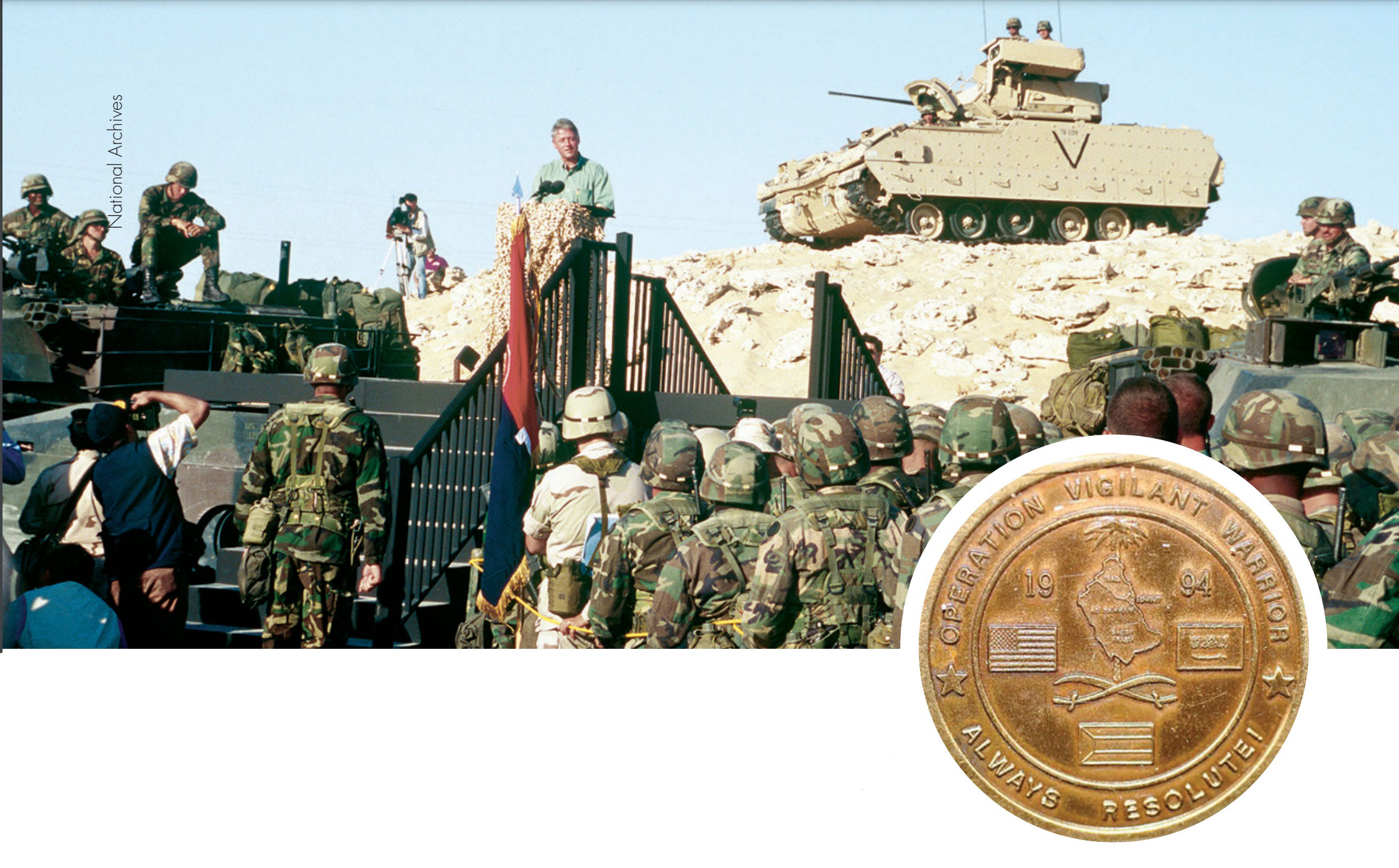
President William Jefferson “Bill” Clinton speaks to American and Kuwaiti troops deployed at the Tactical Assembly Area Liberty.
On 6 October 1994, U.S. intelligence analysts discovered clear evidence that Iraq was deploying two elite Republican Guard armored divisions to the Kuwaiti border. The presence of ground combat troops so close to Kuwait set off a panic in Kuwait City where memories of the Iraqi invasion and subsequent six-month occupation in 1990–1991 were still fresh and terrifying. General J. H. Binford Peay III, Commander in Chief, U.S. Central Command (CINCCENT), headquartered in Tampa, Florida, also saw the buildup of forces as a serious threat. Even as he rapidly mobilized U.S. forces to meet the Iraqi threat, Peay discussed with his deputy, Marine Corps Lt. Gen. Richard I. Neal, the possibility of evacuating the small, lightly defended U.S. base, Camp Doha, located approximately twenty-four kilometers west of Kuwait City.
The problem was time. Was there time to evacuate the approximately 500 Army personnel and 1,200 civilians on the post when the Iraqi army was only a few hours away? What about all the Abrams tanks, Bradley fighting vehicles, and howitzers stored at Camp Doha? If the Iraqis crossed the border, should the equipment be abandoned, moved, or destroyed? How long could the Kuwaiti military with its four brigades hold off Iraq’s two armored divisions? And perhaps the most important question on General Peay’s mind: Was there time to rush enough forces into theater to stop the Iraqi Republican Guard from overrunning Kuwait as they had in August 1990?
The Gulf War
The exciting events during the first two weeks of October 1994 were indicative of the recurring challenges of containing Iraq in the years after the Persian Gulf War (1990–1991). On 2 August 1990, three armored divisions of the Iraqi Army’s Republican Guard rumbled across the Kuwaiti border and quickly overran the emirate’s small, unsuspecting military. By seizing Kuwait, Iraq controlled a fifth of the world’s oil reserves and punished Kuwait for refusing to cancel debts Iraq incurred during the Iran—Iraq War (1980–1988).
The response from the rest of the world was swift. Four days after Iraq swallowed its neighbor whole, the United Nations (UN) Security Council imposed a comprehensive trade embargo on Iraq, including weapons and other military equipment but excluding medical supplies and food.1 The United States and a multinational coalition deployed military forces, under UN mandate, to defend Saudi Arabia, a critical ally and major oil producer in the region.They fought a lightning war to expel Iraq from Kuwait after a brutal six-month occupation. It took just six weeks of air war and a hundred hours of ground combat to push the Iraqi Army—the fourth-largest army in the world—out of Kuwait. Defeated and badly mauled but not destroyed, the Iraqi Army withdrew.
The outcomes of the Gulf War were mixed. At the end of the conflict, the UN-brokered cease-fire agreement required, among other things, that Iraq give up its chemical, biological, and nuclear weapons programs and stockpiles.2 To enforce this requirement, the UN left the economic sanctions in place, including an arms embargo, and set up an inspections regimen to monitor and verify compliance. The UN Special Commission (UNSCOM) was responsible for overseeing the identification and destruction of Iraq’s biological and chemical weapons, as well as its long-range missiles. The UN assigned Iraq’s suspected nuclear weapons program to the International Atomic Energy Agency.3 Despite these conditions, the Gulf War neither removed Iraqi president Saddam Hussein from power nor eliminated his ability to threaten neighboring countries and vital U.S. interests in the region, especially the free flow of oil.4
After the Conflict
Regime survival by whatever means necessary remained the top priority of Saddam’s Ba'athist government in Baghdad. In the immediate aftermath of the Gulf War, this goal required a ruthless repression of uprisings by Iraq’s Kurdish minority in the north and by the Shi'ites in the south. Although the international community initially turned its back on the Shi'ites, who had ties to Iran, it mobilized to help the Kurds. To prevent Iraqi aircraft from continuing these attacks, the United States created a no-fly zone above the 36th parallel and, as part of a larger humanitarian mission, inserted ground troops to push the Iraqi army below a defensible line. The following year, President George H. W. Bush announced Operation Southern Watch to enforce a new southern no-fly zone below the 32nd parallel (Map 1). U.S. Central Command (CENTCOM) created Joint Task Force Southwest Asia (JTF–SWA) in Riyadh, Saudi Arabia, to run the operation, and Headquarters, Ninth U.S. Air Force executed its mission through the 4404th Composite Wing. France and the United Kingdom joined the United States in patrolling duties. These exclusion zones provided a literal form of top cover to Saddam’s domestic adversaries. Iraq practiced partial and measured compliance with weapons inspections punctuated by demands and refusals. Saddam’s desire to maintain the capacity and expertise to restart his weapons of mass destruction (WMD) programs kept him from fully complying with the UN inspections.

Map 1, Iraqi Air Restrictions 1991-2003. For larger image.
After four years of hardship in Iraq, Saddam Hussein was determined to end sanctions. The Iraqi president never acknowledged the legality of the sanctions, and even initially rejected a UN “oil for food” arrangement, which would have allowed Iraq to use some oil revenue to import food, medicine, and other essentials.5 By 1994, Iraq’s economy was in shambles. Prices for consumer goods had skyrocketed and per capita income had fallen drastically, making it difficult for most Iraqis to purchase anything but the bare essentials.6 On 23 September, citing shortages caused by sanctions, the Iraqi government halved daily food rations for the nation’s 18 million people. In just one day, food prices doubled.7 Medical equipment and drugs were also scarce, causing a crisis in the nation’s health-care system.
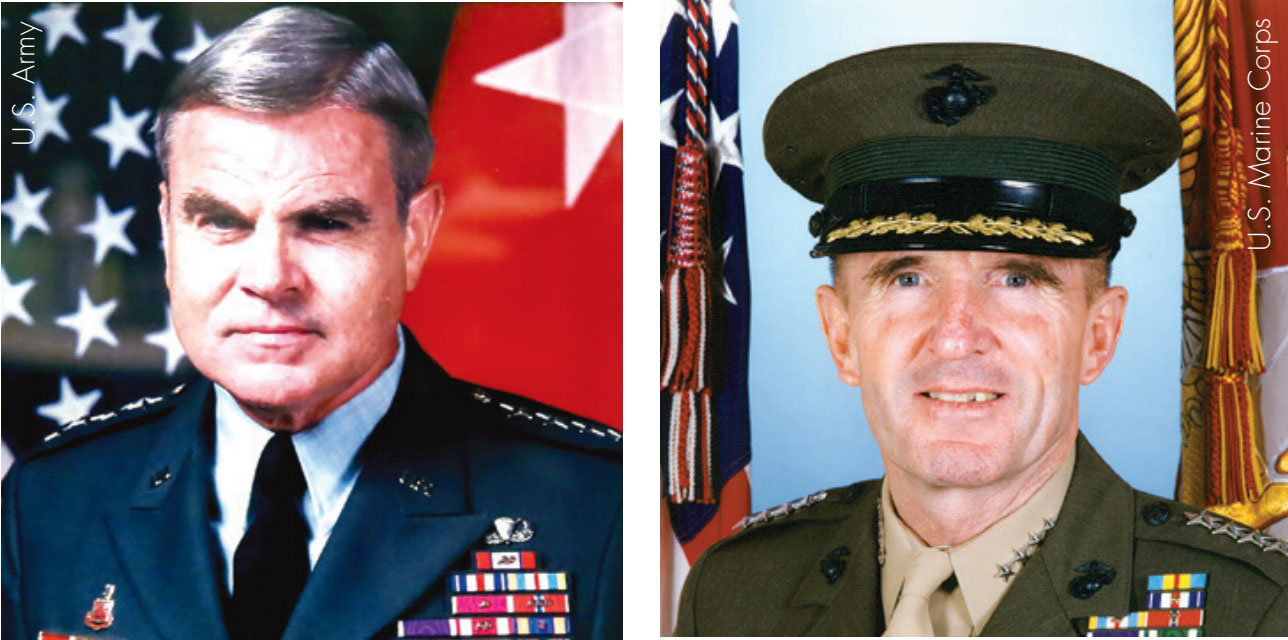
Rightside photo General Peay, Leftside photo General Neal.
In seeking the termination of sanctions, Saddam’s main concern was not the survival of his people but the survival of his regime. If the domestic conditions deteriorated further, Saddam feared that it would cause more political unrest. An unsuccessful coup in July 1993 and repeated assassination attempts against Saddam underscored the precariousness of his position.8 Lifting the arms embargo would allow Saddam to equip, arm, and modernize Iraq's military—a critical tool for maintaining internal order and repressing potential dissent. Saddam spent much of 1994 embarked on a so-called “charm offensive” to undermine UN sanctions, using measured cooperation with weapons inspectors and appeals to the international community on behalf of the innocent victims of the sanctions. Taking advantage of a loophole in the UN resolutions, Iraq also negotiated contracts for arms deals and infrastructure projects in anticipation of the lifting of sanctions. Saddam’s public relations efforts seemed to be paying off.
Iraq and the UN
The Iraqi leader had reason to be optimistic about the possible lifting of sanctions. Three permanent members of the UN Security Council—France, Russia, and China—all wanted to end the sanctions. All three countries had a history of selling arms to Iraq and stood to gain lucrative contracts for rebuilding the country. Iraq had accumulated large debts to both France ($6 billion) and Russia ($5 billion) during the Iran–Iraq War.9 An end to the oil embargo would give Baghdad the funds to buy arms and pay its debts. The United States and the United Kingdom, however, adamantly opposed the lifting of sanctions until Iraq complied with all UN resolutions, including the complete dismantling of its WMD program.
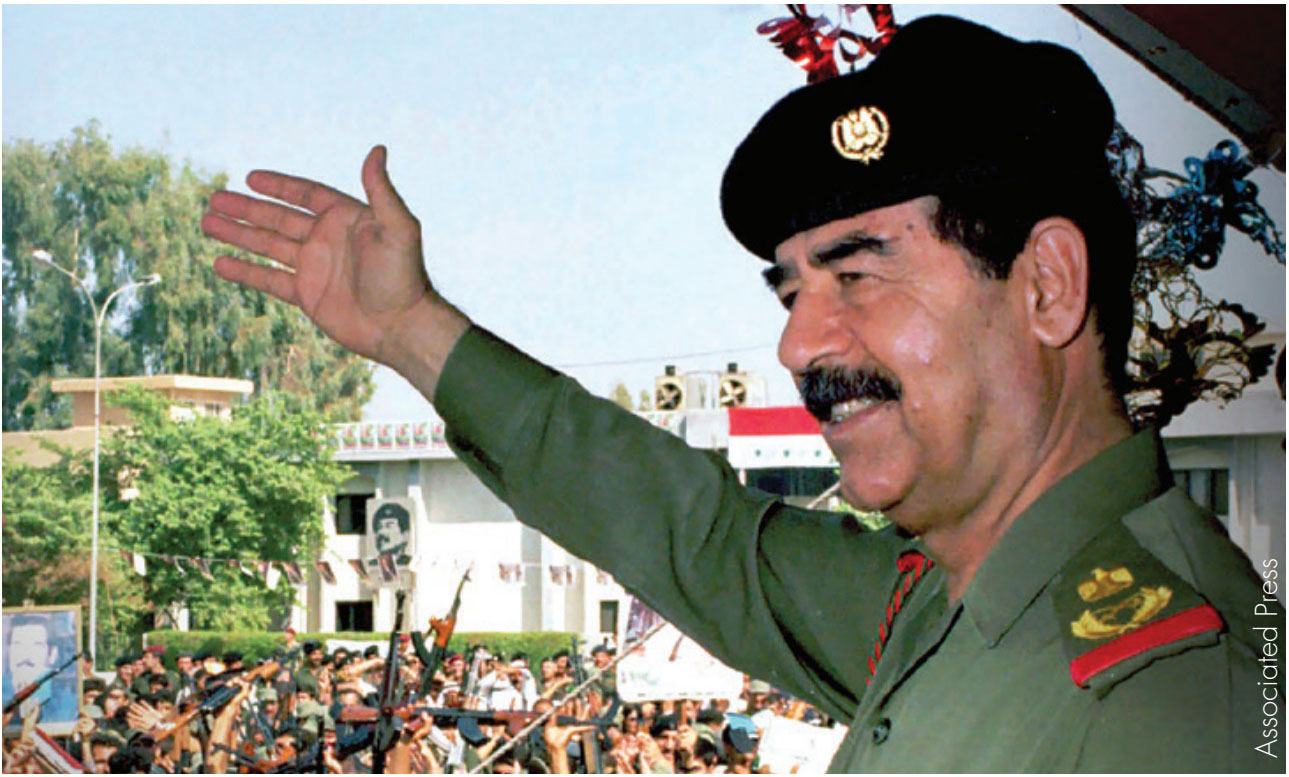
Saddam Hussein
In September 1994, as the United States was deploying 20,000 troops to restore Haiti’s democratically elected government and remove the military junta that had governed the country since 1991, Saddam increased his antisanctions rhetoric ahead of the next UNSCOM report to the UN Security Council, due on 10 October. Although UNSCOM Chairman C. Rolf Ekéus doubted Iraq had come clean about its biological weapons program, he was satisfied that UNSCOM had largely achieved its goals in identifying and dismantling Iraq’s chemical weapons and missile programs.10
In light of this progress, the commission shifted its focus to ongoing monitoring. U.S. intelligence officials, however, had even greater concerns about Iraq’s WMD capabilities and intentions. Central Intelligence Agency (CIA) Director R. James Woolsey Jr. announced that Iraq had hidden some weapons programs, was building underground facilities to resume these programs, and harbored ambitions of seizing Kuwait again. On 25 September, an Iraqi government official stated that Baghdad would reconsider its cooperation with weapons inspectors if the UN did not ease or lift sanctions. In this tense environment, Ekéus visited Iraq during the first week of October to discuss ongoing monitoring of suspected WMD sites.

Map 2, Iraqi Troop Movement Operation vigilant Warrior, October 1994. For larger image.
Suspicions
On 4 October, while Ekéus was in Baghdad, a British GR–1 Tornado, flying a Southern Watch reconnaissance mission, photographed an Iraqi transport on the highway between Qalat Salih and Al Basrah. An initial photographic analysis in Dhahran, Saudi Arabia, concluded that it was heading north and carrying an older T55 tank. When intelligence analysts in Riyadh took another look, they determined that the vehicle was actually carrying a modern T72 tank and heading south. This was the first solid indication of Iraqi troop movement. Over the next two days, U.S. intelligence analysts scoured the available imagery to determine which Iraqi units were moving and to where. They determined that two Republican Guard divisions—the Hammurabi and Al-Nida—were moving south to the Iraqi III Corps area near Al Basrah. On 6 October, CENTCOM received a “national warning message” about the Iraqi deployments (Map 2).11 Alongside the three regular army divisions permanently stationed in the south, the arrival of two Republican Guard formations would give Saddam five heavy divisions within striking distance of Kuwait.12 The Iraqi positions, including a forward command post at Az Zubayr, resembled those established just before the 1990 invasion of Kuwait.13
The same day CENTCOM learned of the Iraqi Republican Guard deployments, Iraqi Deputy Prime Minister Tariq Aziz demanded that UNSCOM set a date for lifting sanctions and made a veiled threat about Iraq looking for other means to defend itself. This kind of saber-rattling was nothing new.14 Saddam had made similar threats in March 1994. However, the combination of threats and troop movements set off alarms in Washington that would soon reverberate at CENTCOM headquarters in Tampa. On the same day Aziz issued his warning, General Peay, who had assumed command in August that year, received a briefing about unusual troop movements in southern Iraq. Lead elements were fifty kilometers from the border, and at the current rate of movement four Republican Guard brigades could be on the Kuwaiti border by 10 October.15 This was the date scheduled for the next sixty-day review of Iraq’s compliance with UN resolutions and Saddam’s deadline for a commitment from the UN Security Council on the lifting of sanctions.16
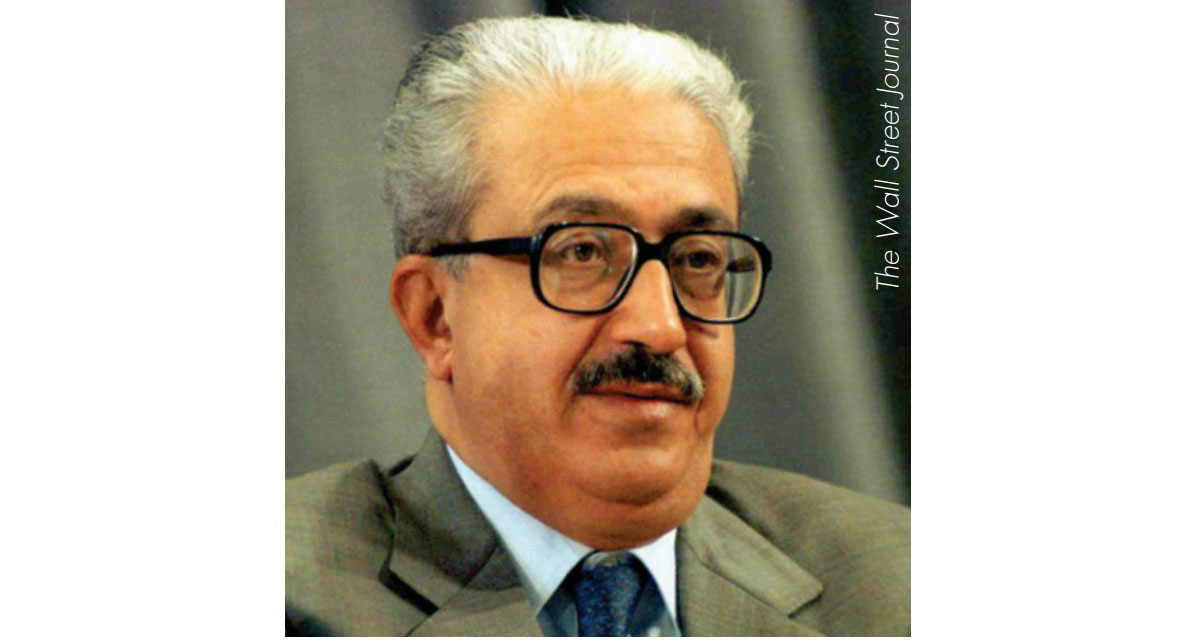
Tariq Aziz
At the time, the U.S.-led coalition had insufficient aircraft to deter an Iraqi ground assault, much less launch a counterattack. A substantial number of U.S. and British Royal Air Force (RAF) assets in the region enforced the no-fly zone below the 32nd parallel, but these aircraft were not equipped to stop advancing armored divisions.17 In the first week of October, JTF–SWA had only eighteen F–16C Falcons and six British GR–1 Tornados to counter the Iraqi divisions moving south.18
Moreover, no forward air controllers, liaison officers, and other personnel were in theater to conduct extensive close air support operations. The Kuwaiti air force had twenty-four new F–18s, but it was unclear how combat ready the fighters and their crews were.
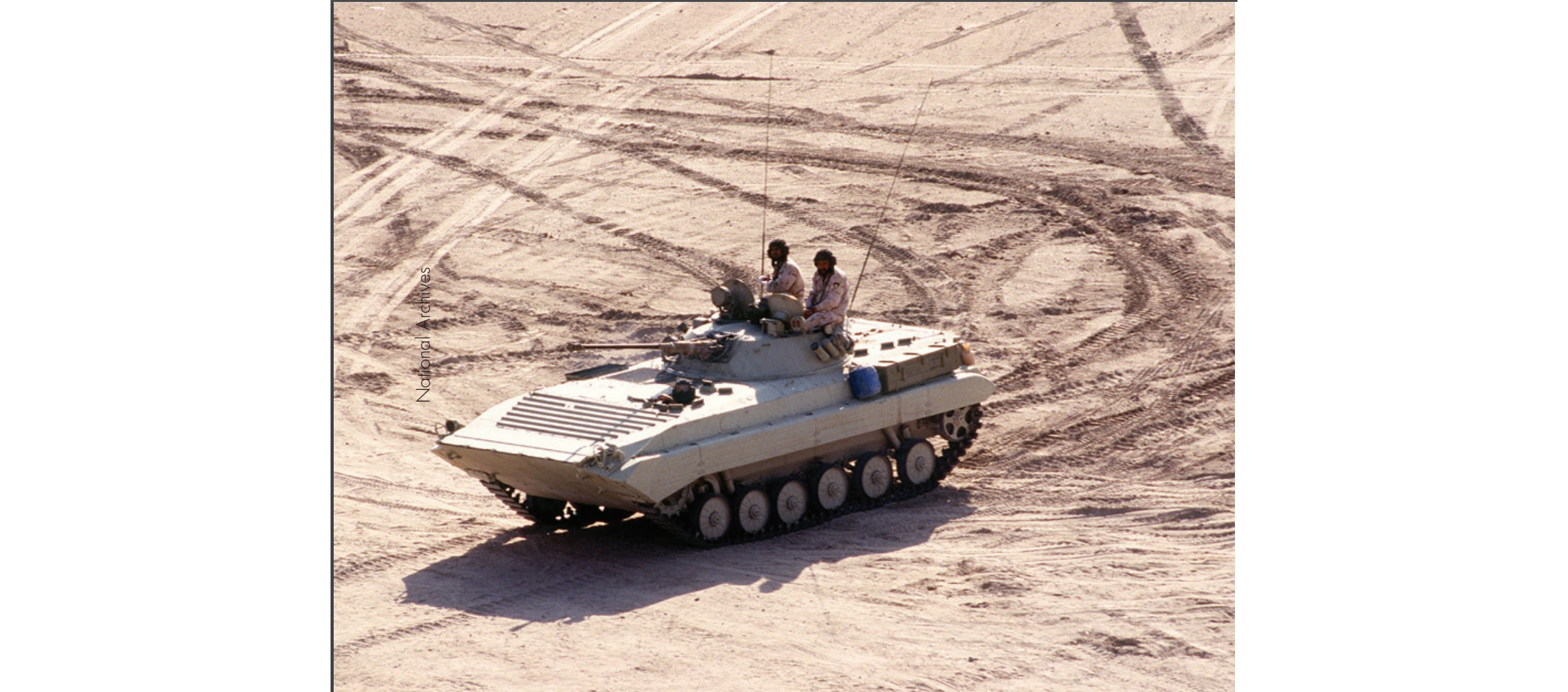
Overhead shot of a Kuwaiti Army BMP–2 infantry fighting vehicle taking part in Operation Vigilant Warrior.
The United States and Kuwait had only minimal ground forces in the region. Kuwait fielded four understrength brigades—two armored, one mechanized infantry, and one motorized cavalry—plus a unit with a single anti-armor helicopter.19 CENTCOM also had limited forces in the country. The Area Support Group–Kuwait (ASG–K), the Army’s only permanent command in the emirate, consisted of about 180 Army personnel, a detachment of approximately 300 soldiers from the 513th Military Intelligence (MI) Brigade, and some 1,200 contract civilians.20 The command’s primary responsibility was to maintain the Army War Reserve–5 (AWR–5) stored at Camp Doha and used by the battalions that deployed for Intrinsic Action, a recurring Kuwaiti American live-fire training exercise. The next Intrinsic Action rotation was scheduled to begin mid-October, so the designated units from the 1st Infantry Division were still at their home station, Fort Riley, Kansas.21 As it happened, the only U.S. combat troops in Kuwait at the time were sixty-five Special Forces soldiers from Company C, 2d Battalion, 5th Special Forces Group, 1st Special Forces, who had arrived on 3 October for an Iris Gold training exercise with the Kuwaiti military. Not only were there too few troops, but pre-positioned stocks were also short. AWR–5 was supposed to outfit a brigade; however, not all of the allocated equipment had arrived from recently inactivated VII Corps units in Europe.22 The limited personnel and materiel meant that coalition ground forces would not have been sufficient to halt the advancing Iraqi Republican Guard divisions without significant reinforcements.23
The maritime assets in theater, however, were more extensive. Although the Navy had no carrier in the Persian Gulf, five major combat ships armed with Tomahawk cruise missiles were present. The USS Tripoli Amphibious Ready Group was also in the Gulf. Its landing force, the 15th Marine Expeditionary Unit, had approximately 2,000 marines ashore in the United Arab Emirates conducting exercises.24 (A Marine expeditionary unit is an air-ground task force built around a Marine Corps infantry battalion.)
On Friday, 7 October, the Hammurabi Division’s 15th Mechanized Brigade and 17th Armored Brigade were at Shaibah Air Base, a former RAF facility approximately twenty-eight kilometers from the border, near the town of Az Zubayr. The Al-Nida Division’s 43d Mechanized Brigade was embarking on rail cars in Mosul. At the current rate of movement, CENTCOM estimated that the Republican Guard would have six brigades—two full divisions—in the south by 13 October.25
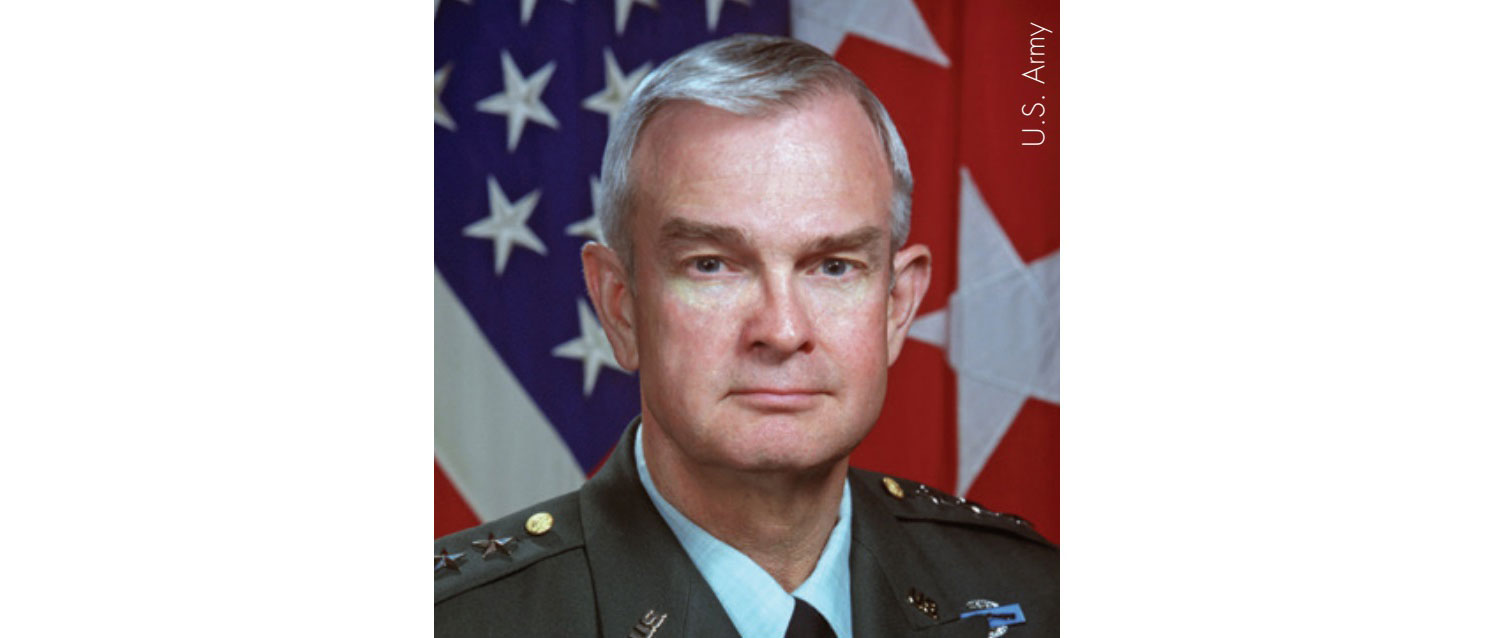
General Arnold
Urgent Situation
Given the limited number of friendly combat-ready forces in theater, the priority for General Peay was to send as many coalition forces to Kuwait as quickly as possible. He telephoned his subordinate commanders to stress the urgency of the situation. “SECDEF [secretary of defense] feels it’s serious,” he told Lt. Gen. Steven L. Arnold, the commander of the Third U.S. Army/U.S. Army Central (ARCENT) at Fort McPherson, Georgia. Peay informed Arnold that Maj. Gen. Everett H. Pratt Jr. (U.S. Air Force), commander of JTF–SWA in Riyadh, would run operations in theater until the arrival of the deputy CINCCENT, General Neal. Peay ordered Arnold to send a senior commander from Third Army to Kuwait. Arnold chose his deputy, Maj. Gen. James B. Taylor. The CENTCOM commander stressed the importance of moving heavy ground forces to the Gulf quickly to “stop this guy.” 26
After speaking with Arnold, Peay wondered aloud to his staff whether General Taylor would be able to defend against a possible Iraqi attack with the limited resources available. “Will General Taylor stand and fight or go south?” he asked.27 Peay’s question was one of tactics, not courage, and it highlighted the precariousness of the situation. The same day, Peay stood up his Crisis Action Team. He also requested the immediate deployment of Air Force and Navy assets to the Gulf: KC–130 tankers, U–2 and RC–135 reconnaissance aircraft, and the USS George Washington aircraft carrier battle group. At the evening update with his staff, Peay again raised the possibility of evacuating Camp Doha: “At some point do we want to retrograde [AWR–5] equipment south? We have a 3–5 day vulnerable window.”28
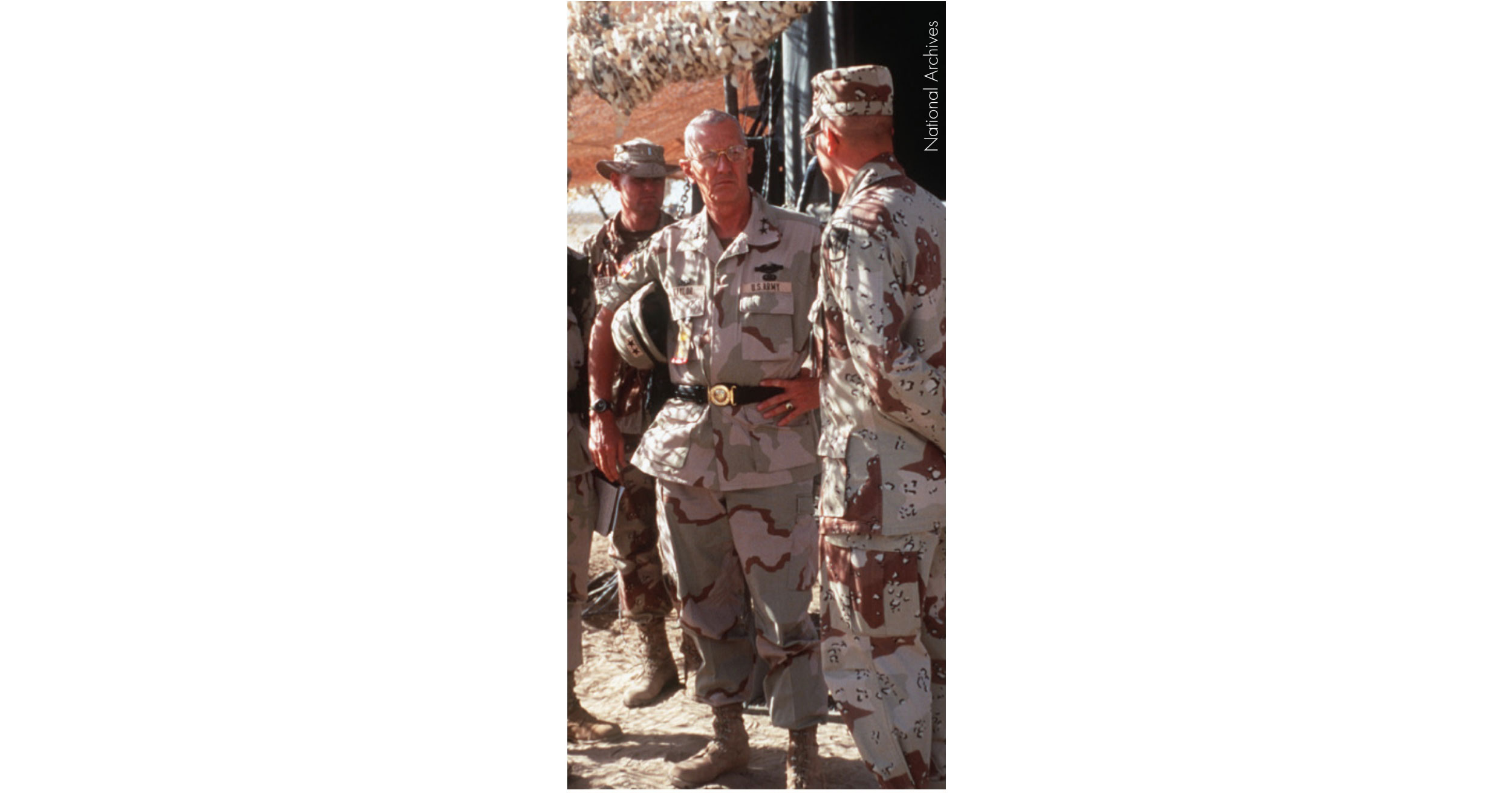
General Taylor (Center) speaks with a soldier at Tactical Assembly Area Liberty outside Kuwait City.
The Kuwaitis also took the threat seriously. On 7 October, Peay learned that Ambassador Ryan C. Crocker had relayed a request from the Government of Kuwait for ground troops, a Patriot missile battery, and a statement of U.S. intentions. To meet the immediate threat, Peay requested from Washington the deployment of three mechanized companies and three armored companies—a “3×3 Battalion Task Force.”29 That evening, the Kuwaiti Land Forces headquarters deployed all four of its brigades into defensive positions in the desert northwest of Kuwait City.
However, leaders at Camp Doha did not sense the same urgency felt in Washington, Tampa, or the rest of Kuwait. Seeing Kuwaitis stocking up on groceries and queuing up at gas stations, the ASG–K commander, Col. Robert L. Smalser, went ahead with a planned 8 October picnic for his troops, which Ambassador Crocker also attended.30 Later, Smalser recalled that he did not believe the Iraqi Army had the ability to attack successfully, because, as he saw it, they had neither the necessary command and control capability nor sufficient support in place.31 This assessment, which contradicted CENTCOM’s, was based on limited intelligence, because the 513th MI detachment did not have access to CENTCOM’s satellite imagery until 1995.32 Nevertheless, on the day of the picnic, U.S. Special Forces soldiers embedded with their coalition partners in the desert north of Kuwait City, preparing for an imminent Iraqi offensive.
Kuwait was not alone in its mobilization of forces. President William
J. “Bill” Clinton ordered “the USS George Washington Carrier Battle
Group, cruise missile ships, a Marine expeditionary brigade, and an
Army mechanized task force” to the Persian Gulf.
Deployment
Once the president issued a deployment order, lead units moved quickly in response to CENTCOM’s request for forces. Two Patriot missile batteries of the 2d Battalion, 43d Air Defense Artillery, arrived in Saudi Arabia on 8 October: one in Riyadh, the other in Dhahran. The plan was for them to drive pre-positioned equipment to Kuwait.35 The same day, the Army ordered elements of the 7th Transportation Group to Kuwait and Saudi Arabia for split operations. The Third Army forward headquarters left Georgia on 8 October. When Taylor flew to Kuwait to establish Joint Task Force–Kuwait (JTF–K), Arnold did not have a written mission to give his deputy, which Third Army planners were still developing. In the interim he issued verbal orders based on discussions with General Peay. In addition to setting up JTF–K, Taylor was to assess the Kuwaiti defenses and take command of U.S. ground forces.36 Upon arrival on Sunday, 9 October, Taylor and his staff converted a warehouse at Camp Doha into a command post, working around the clock for the next forty-eight hours. Lacking time to deploy Third Army’s “Lucky Tac” mobile command post, Taylor improvised.37 While the Army flew its forces to Kuwait and Saudi Arabia, Navy ships sailed toward the Persian Gulf. In addition to the USS George Washington carrier battle group, which was already steaming from the Adriatic toward the Red Sea, the Navy, on 9 October, also deployed five ships carrying AWR–3 from Diego Garcia in the Indian Ocean to the Port of Dammam, Saudi Arabia.
As units headed to the Middle East during the first weekend of the crisis, Arnold’s staff worked in coordination with CENTCOM planners to craft a mission statement, which General Peay approved on Monday, 10 October. “Third Army would deploy forces to theater, deter an Iraqi attack, defend Kuwait if necessary to protect critical coalition assets, and be prepared to counterattack and conduct offensive operations.”38 This statement reflected the ambiguity surrounding Saddam’s intentions. Was the deployment of Republican Guard troops to the Kuwaiti border simply a show of force to intimidate his opponents? Was he planning to conduct cross-border operations? Or would he order his troops to repeat their August 1990 invasion of Kuwait? The absence of human intelligence from inside Iraq forced the intelligence community to rely on Saddam’s past behavior. On that basis, analysts generally assumed hostile intent.39 U.S. military planners had the same mindset as they began developing a contingency plan and Time Phased Force Deployment Data (TPFDD), which controlled the deployment of units.
As the planners refined the TPFDD, Iraq’s forces continued to move
south. By 9 October all three brigades of the Hammurabi Division were
already in southern Iraq. Two brigades—the 15th Mechanized and
17th Armored—were at Shaibah and the
8th Armored Brigade was a little further south, just fifteen
kilometers from the Kuwait border. All three brigades of the
Al-Nida Division were heading south by rail from their bases in
northern Iraq and lead elements were already in Shaibah. An armored
battalion from a third Republican Guard division was moving
from Qalat Salih north of Al Basrah to near Shaibah. CENTCOM analysts
determined that both the Hammurabi Division and the
Al-Nida Division would be amassed near the border by 13
October, enabling Iraq to launch a five-division attack with
Republican Guard and regular army divisions already in the
area.
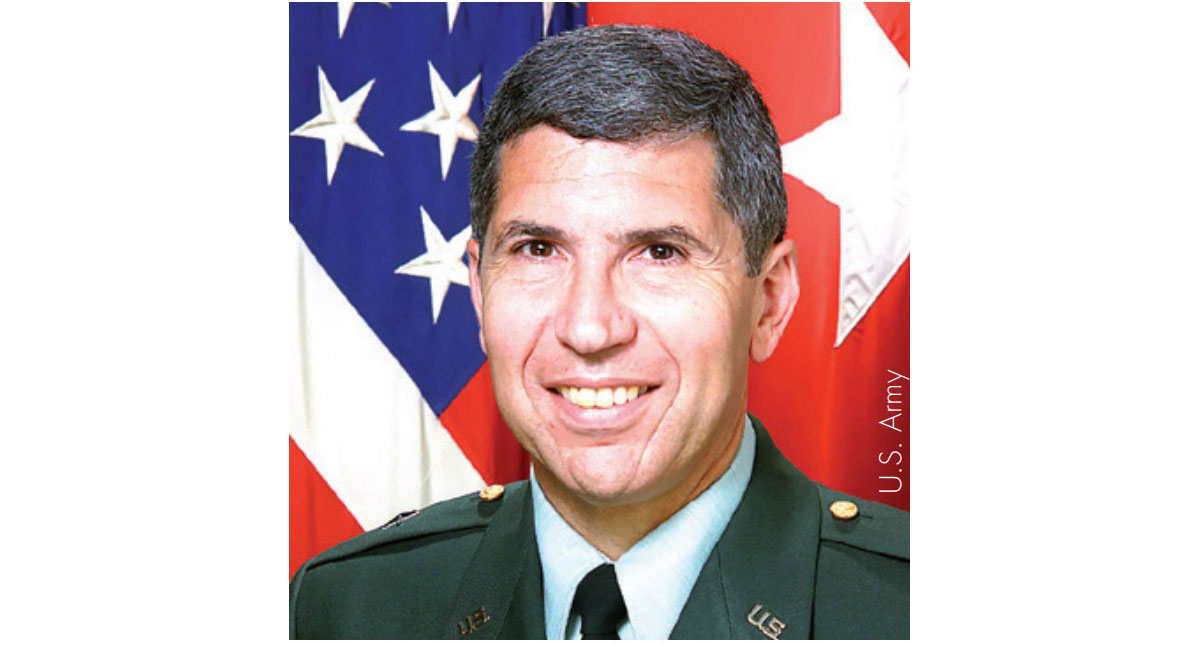
Joseph E. DeFrancisco, shown here as a brigadier general.
Maj. Gen. Joseph E. DeFrancisco’s 24th Infantry Division (Mechanized) worked around the clock to deploy its units to meet the threat. DeFrancisco ordered 2d Battalion, 7th Infantry (Mechanized), 1st Brigade, the primary component of Task Force (TF) 2–7 Infantry, to deploy first. This was a logical choice because the battalion had just completed an Intrinsic Action exercise. Therefore, they had recent experience with AWR‒5, the terrain, and working with the Kuwaiti military. After receiving an unofficial warning order on 7 October and official notification at 1900 the following day, two TF 2–7 companies—one armor and one mechanized—plus a battalion headquarters element were ready to fly out by noon on 9 October. They landed in Kuwait on the evening of 10 October (Table 1). After drawing their equipment and ammunition at Camp Doha, the two companies were in their tactical assembly area within forty-eight hours. Lead elements of their sister battalion—3d Battalion, 69th Armor, 1st Brigade, the center of TF 3–69 Armor—were in Kuwait on 11 October. The rest of the two battalions continued to arrive over the next few days. The deployment of troops did not always go as planned. S. Sgt. Andrew Conrad, who was on the TF 2–7 advance party, flew out of Savannah, Georgia, on 10 October but did not arrive in Kuwait until 14 October because his C‒5 aircraft “kept breaking down.”41 Many such hiccups occurred during the rapid deployment phase.
Table 1 — U.S. Army Battalion Deployments
| Division and Brigade | Unit | Arrived in Theater |
|---|---|---|
| 24th Infantry Division 1st Brigade | 2-7 Infantry | 10-11 October 1994 |
| 24th Infantry Division 1st Brigade | 3-69 Armor | 11-15 October 1994 |
| 24th Infantry Division 3rd Brigade | 2-69 Armor | 15-17 October 1994 |
| 24th Infantry Division 3rd Brigade | 1-18 Infantry | 22 October - 5 November 1994 |
As the first American war fighting units were in the air on their way to Kuwait, the United States and its allies approved more deployments. On 10 October, Chairman of the Joint Chiefs of Staff (CJCS) General John M. D. Shalikashvili issued an execution order for Operation Vigilant Warrior.
General Peay subsequently requested 374 more fixed-wing aircraft. To prepare for a possible full-scale Iraqi invasion of Kuwait, Peay also requested three full Army divisions—the 1st Infantry Division, the 24th Infantry Division (Mechanized), and the 101st Airborne Division (Air Assault)—and the III Corps headquarters to provide command and control. CJCS alerted these units, which began making preparations to deploy.42 The United Kingdom also announced it was sending 4,000 Royal Marines and an additional six Tornados.43 The British also promised two ships: the frigate HMS Cornwall and the destroyer HMS Cardiff. France committed the frigate Georges Leygues.44
Just as the coalition began taking shape, the Iraqis changed course. After the first 300 soldiers from TF 2–7 arrived in Kuwait, Iraqi Ambassador to the United Nations, Nizar Hamdoon, announced that Iraqi troops were “already on the move” to a site north of Al Basrah.45 Iraqi Foreign Minister Mohammed Saeed al-Sahhaf added that the troops would redeploy to “other locations in the rear” to complete military exercises.46 President Clinton addressed the nation from the White House Oval Office at 2000. After outlining the progress in ongoing operations in Haiti, the president discussed military deployments to the Persian Gulf: “Today I have ordered the additional deployment of 350 Air Force aircraft to the region.” He added, “Iraq announced today that it will pull back its troops from the Kuwait border. But we’re interested in facts, not promises, in deeds, not words. And we have not yet seen evidence that Iraq’s troops are in fact pulling back. We’ll be watching very closely to see if they do so.”47
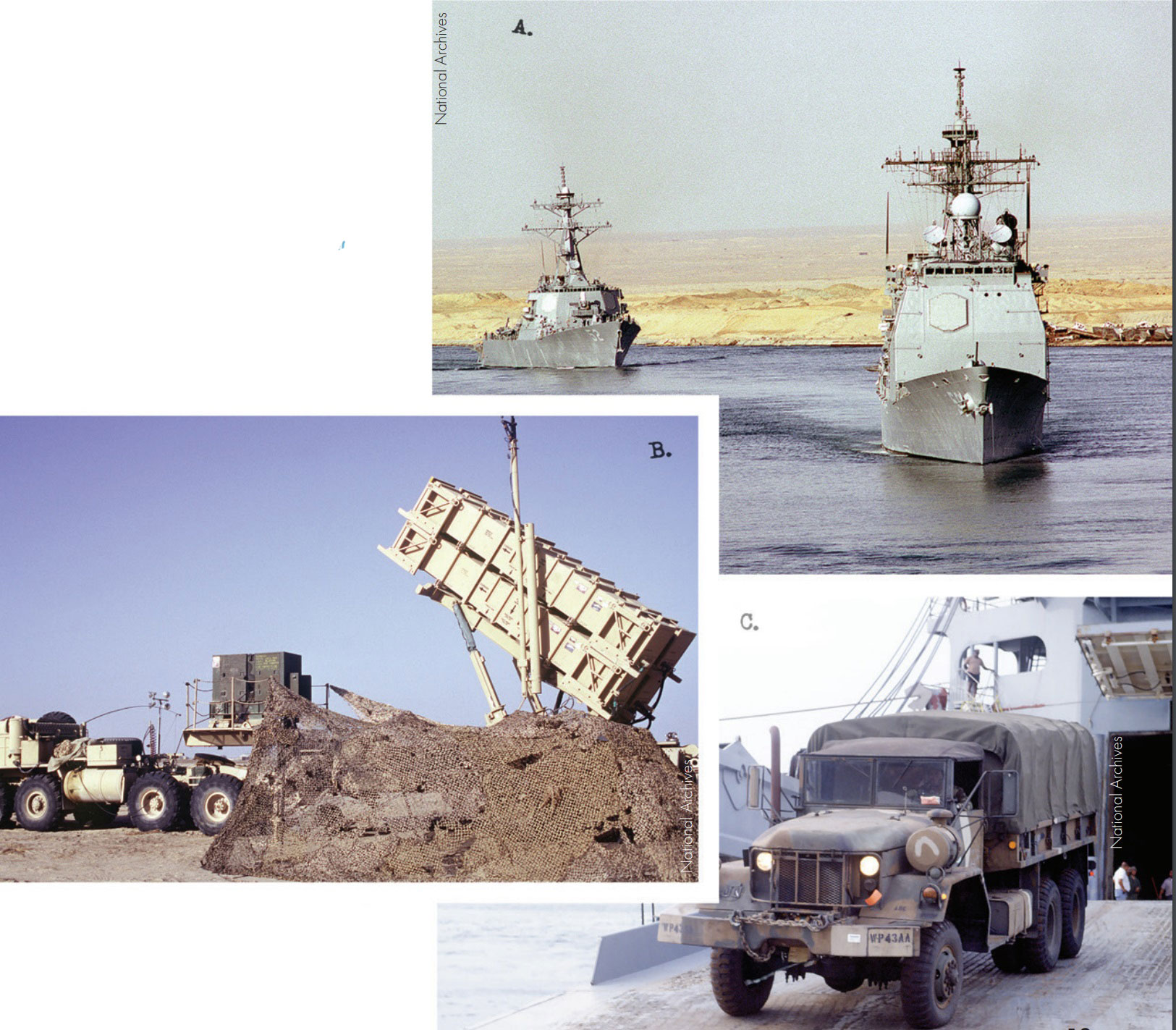
A.) A view from the fantail of the aircraft carrier USS George Washington shows the guided missile cruiser USS Thomas S. Gates and the guided missile destroyer USS Barry as the vessels transit south through the Suez Canal into the Red Sea in response to Iraqi troop movements toward the Kuwait border. B.) A U.S. Army Patriot surface-to-air M901 missile launcher deployed near Camp Doha in the desert of Kuwait. C.) A U.S. Army M939A2 five-ton truck rolls down the ramp of the USS Cape Decision, 19 October 1994.
Reconnaissance imagery of 10 October showed no signs that the Iraqi Republican Guard divisions were moving north. In fact, a British Tornado photographed more than 100 Iraqi T72 tanks near the demilitarized zone.48 Peay told his subordinate commanders to disregard news reports Iraq pulling back. Arnold said that he was not going to take the bait and told his staff to ignore what they heard in American news reports.49 The generals had good reason to be skeptical, based not only on intelligence reports but also on historical precedents. Iraq had perfected the art of deception during the Iran–Iraq War. After the Iraqis invaded Kuwait in 1990, they made false withdrawal announcements, which they used to buy time to reposition their forces. When the ground war began in February 1991, the Iraqis had announced their plans to remove their forces from Kuwait; however, the coalition forces saw no signs of withdrawal.
Consequently, the United States and the United Kingdom continued to send forces to the Gulf. Even when western intelligence agencies observed Iraqi Republican Guard units moving north again, senior American military officers suspected it might be a feint. On 13 October, General Peay went on the Today Show and stated: “The crisis is not past. . . . We have diffused the crisis but we will have to watch the situation closely.”50 Peay’s suspicions seemed warranted when the Al-Nida Division halted its northward movement at An Nasiriya on the Euphrates River about 200 kilometers northwest of Al Basrah. This raised the possibility that the withdrawal was a deception intended to stop the movement of coalition forces to the region. However, the Defense Intelligence Agency concluded that the Al-Nida Division’s halt at An Nasiriyah was likely due to transportation problems.51 Both Peay and Shalikashvili still thought it prudent to send a second brigade.
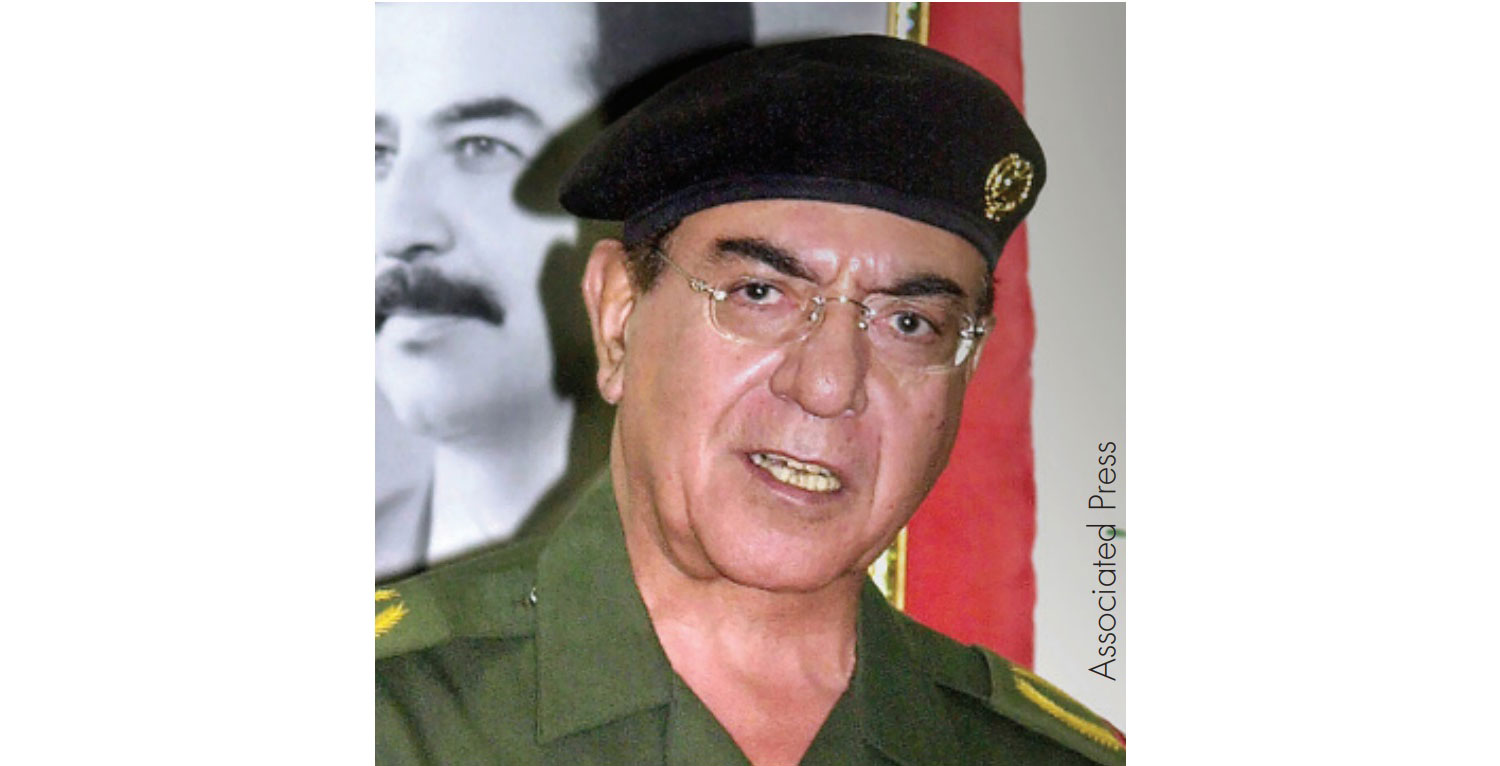
Mohammad Saeed al-Sahha
A debate ensued over whether to deploy 3d Brigade, 24th Infantry Division, to Saudi Arabia as planned. Peay wanted these forces in theater to reinforce the ones already there. But Army leaders were concerned that with the Iraqi threat appearing to diminish, deploying another brigade would be too expensive. Consequently, eight planeloads of 7th Transportation personnel bound for Dhahran turned around midflight over the Atlantic Ocean. However, General Shalikashvili was concerned about sending a premature message that the crisis was over. In order to underscore the American commitment to regional security and reduce the likelihood that Saddam would reverse his withdrawal decision, the chairman told Peay to deploy a second heavy brigade.52 This order required the eight rerouted aircraft to turn around again in order to proceed to their original destination and prepare for the arrival of 3d Brigade. The continuous shifts in deployments attested to the general uncertainty about Saddam’s intentions and objectives.
While CENTCOM continued to send military forces into theater, diplomats worked to prevent a repeat of Saddam’s “October Surprise.” Technically, Iraq had not violated existing UN resolutions by moving divisions to the Kuwait border. In light of this, U.S. diplomats sought a new restriction on such troop movements. As U.S. Ambassador to the United Nations, Madeleine K. Albright, explained, “What we’re looking at are ways to try to make sure that they stay well, well behind their borders.”53 As a result of these efforts, the UN Security Council unanimously passed Resolution 949 on 15 October, demanding that “Iraq immediately complete the withdrawal of all military units recently deployed to southern Iraq to their original positions.”54 Iraq quickly acceded to the Security Council’s demand. The UN also ordered Iraq not to “take any other action to enhance its military capacity in southern Iraq.”55 To enforce this order, the United States and its allies created a ground exclusion zone south of the 32nd parallel—a “no-drive zone” as a corollary to the no-fly zone.
A Shift in Focus
In the second week of the crisis, the operational focus shifted as the threat of an Iraqi attack subsided. By 15 October, one week after Clinton gave the deployment order, the first two battalions comprising a 3×3 task force were in Kuwait. By 17 October, they had drawn their equipment and ammunition at Camp Doha and were in the desert northwest of the capital ready to support the Kuwaiti army.56 However, this was still a thin screen against the available Iraqi forces in southern Iraq (approximately 50,000 regular army troops in Al Basrah and the Republican Guard division at An Nasiriyah) should they attack. That possibility seemed remote after the Al-Nida Division started moving north again on 18 October. The president canceled the deployment of 18,000 marines from I Marine Expeditionary Force, plus 156,000 other personnel who had been put on alert. The crisis appeared to be over.
Although still officially a contingency operation, Vigilant Warrior evolved into a training exercise and deployments slowed accordingly. On 17 October, TF 2‒69 Armor—centered on 2d Battalion, 69th Armor, 3d Brigade—assembled in Dammam, Saudi Arabia. The unit billeted for several days in a hangar at Lucky Base, the ARCENT facility about thirty kilometers from the port, waiting to get their equipment from AWR‒3 before moving north to Kuwait. By the time the first two Military Sealift Command (MSC) roll-on/roll-off ships—MV Cape Horn and MV Cape Decision—were ready to offload cargo on 22 October, the crisis with Iraq had passed. Also on this day, elements of 1st Battalion, 18th Infantry, 3d Brigade—the core of TF 1–18—began to trickle into Dammam, in time for its Alpha and Bravo companies to join TF 2–69 on the trip north a few days later. The soldiers found the tanks aboard ship in excellent condition. However, there were problems. None of the batteries worked because they had not been properly maintained and were not checked before offloading.57 Every vehicle had to be jumpstarted in order to move down the ramp and onto the pier, slowing the operation.58 Eventually, the U.S. Army Materiel Command (AMC) cargo specialists, working with 6th Transportation Battalion and 3d Brigade soldiers, finished unloading the tanks, trucks, and other equipment. Soldiers then moved everything to an assembly area to prepare for convoy operations.
The United States encountered myriad difficulties throughout the training exercise, not just at the port. The movement from Dammam, Saudi Arabia, to the tactical assembly area in northern Kuwait took place over three days from 26 to 28 October. Owing to a lack of drivers and equipment, the 6th Transportation Battalion, commanded by Lt. Col. Kathleen M. Gainey, augmented their capacity with Saudi army and contracted drivers and vehicles. Inferior foreign equipment combined with language and culture barriers caused numerous problems. Few Arabic interpreters were available which made it difficult to communicate with Saudi drivers. The Saudi soldiers refused to eat the U.S. military’s ready-to-eat meals and said they would bring and cook their own food. The 6th Transportation Battalion’s after action report (AAR) relates what happened next: “The Saudis did bring food with them but not the kind of food we expected. They traveled with live goats and propane stoves and expected to have time to slaughter and cook their meal when we stopped.”59 Once the convoys got under way, Saudi drivers did not maintain convoy integrity and kept speeding and passing each other. Consequently, more tires blew out and more vehicles broke down than the Americans expected. When the convoy stopped for rest and refueling stops, the Saudis did not get back in their vehicles when it was time for the convoy to proceed. Loud arguments between the drivers and their superiors ensued. “The Saudis were not used to working the length of time we expected them to,” the AAR explained. The situation improved once the convoys crossed the border, where Kuwaiti police escorts slowed the pace and kept Saudi drivers in line with orders barked over their loudspeakers.60 Despite the problems, the coalition partners and their equipment enabled the 7th Transportation Group to move a total of 376 pieces of equipment to Kuwait in three days.
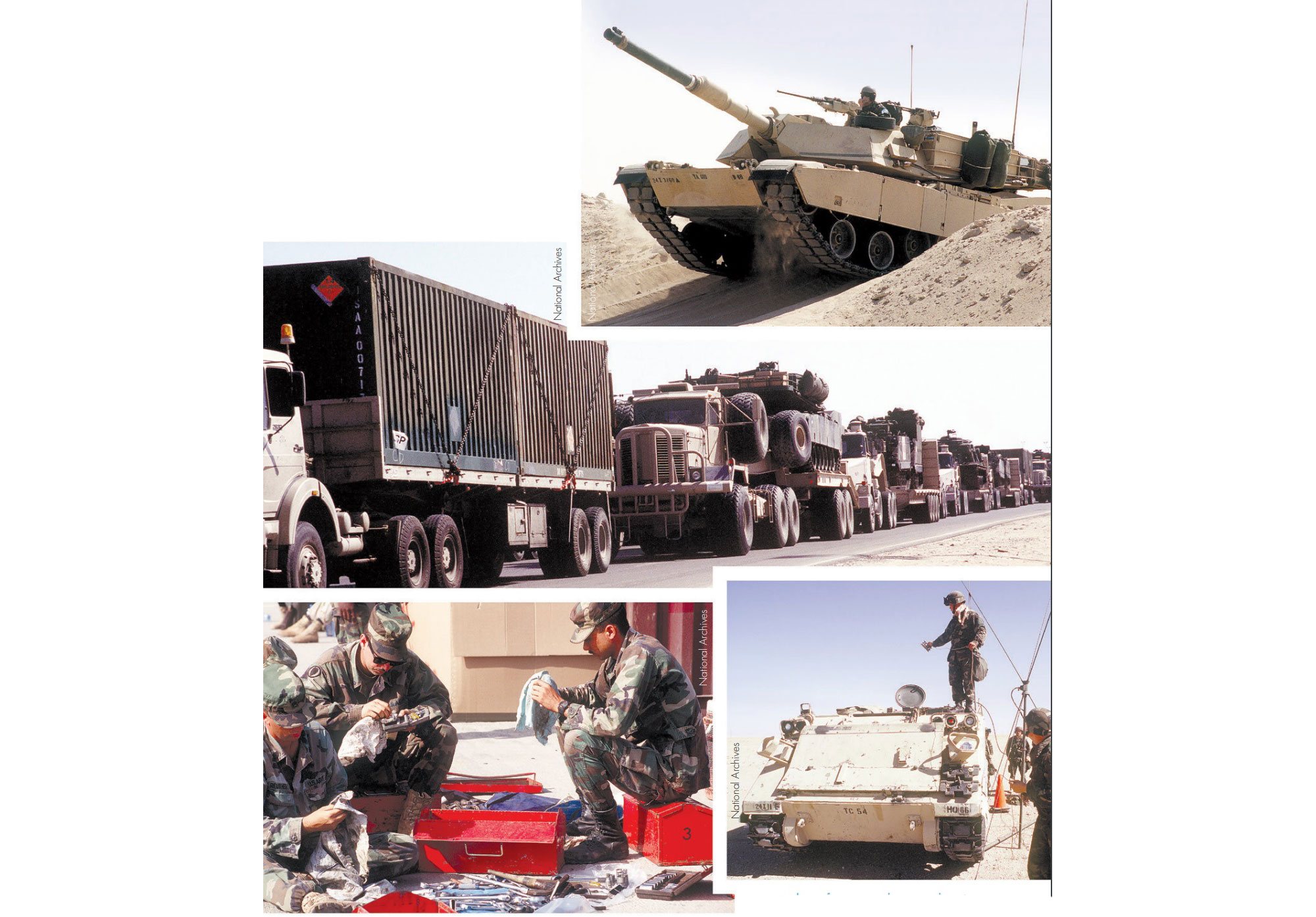
Top right image: An M1A1 Abrams tank crosses a berm in the desert during maneuvers outside the Tactical Assembly Area Liberty. Middle image: A convoy carries materiel needed to support Operation Vigilant Warrior. The convoy is from Company A, 2d Battalion, 69th Armor, 24th Infantry Division, Fort Benning, Georgia. Lower left image: Soldiers from the 24th Infantry Division clean and inventory equipment at the Tactical Assembly Area Liberty during Operation Vigilant Warrior. Lower right image: Crew members of an armored personnel carrier set up a communications antenna outside their vehicle in the desert of Kuwait.
Once 3d Brigade units arrived in their tactical assembly area north of Kuwait City, they joined the 1st Brigade, 24th Infantry Division, for live-fire exercises: practicing counterattacking along an axis to an attackby-fire position. When they had completed their training, the armored task force withdrew to Saudi Arabia to a facility near the Port of Dammam. After cleaning their equipment, 3d Brigade soldiers turned it in. With input from the 24th Infantry Division, AMC personnel created a new load plan for maximum efficiency and put the equipment back on the MSC ships for transport back to Diego Garcia.61
During Vigilant Warrior, the U.S. Navy did more than just provide sealift for Army equipment; it enforced UN sanctions against Iraq by interdicting smugglers. On 22 October, a Navy warship in the Persian Gulf stopped the Honduran-flagged oil tanker Al Mahrousa. After boarding it, Navy and Coast Guard personnel found that the vessel’s paperwork was not in order. The ship’s Egyptian captain admitted to loading 3,162 tons of diesel fuel in Iraq, then sailing into international waters in violation of the four-year-old oil embargo. His contractor told him to sail to Sirri, an Iranian island off the coast of Dubai, to await instructions on where to deliver his contraband cargo. The Navy turned over the Al Mahrousa to the Kuwaitis for further investigation.62 This incident was the first time a tanker was caught in the act of violating UN sanctions against Iraq, showing the difficulty of enforcing the oil embargo. This incident also strengthened the U.S. and British argument against lifting UN sanctions, as Iraq was caught violating those same sanctions.
Significant Outcomes
Operation Vigilant Warrior, which officially ended 22 December 1994, yielded several important outcomes. From a strategic perspective, the United States and its allies deterred Iraqi aggression with an agile and determined U.S.-led military force.63 This was accomplished without firing a shot or sustaining a single casualty due to enemy action. One military analyst called the operation “the first prominent example of effective conventional deterrence by the U.S. in the post‒Cold War era.”64 Of course, this conclusion assumes that Saddam intended to attack Kuwait. U.S. Secretary of Defense William J. Perry believed as much.65 Regardless, diplomatic efforts during the crisis led to a UN-mandated ground exclusion zone, which curtailed the Iraqi military’s freedom of movement and made future deterrence easier.
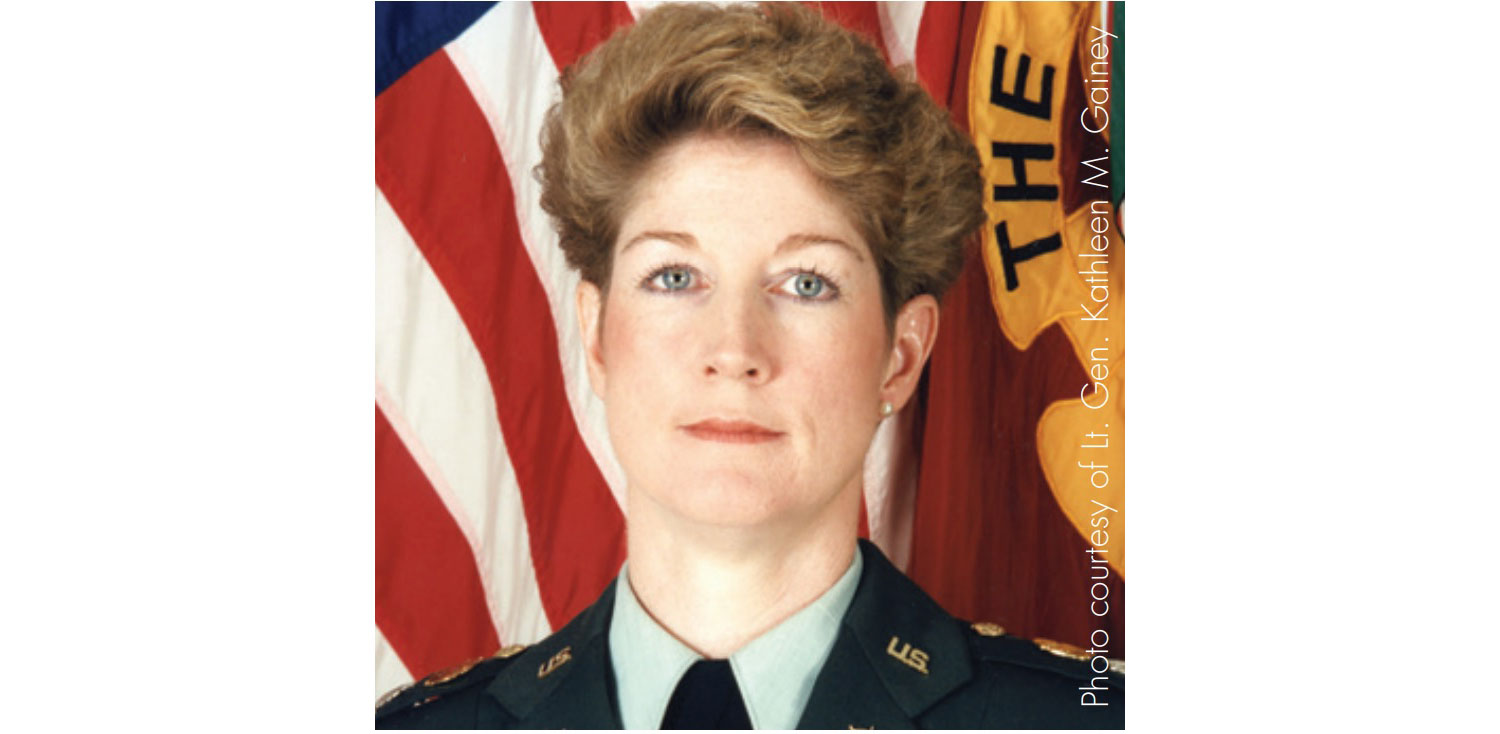
Lieutenant Colonel Gainey
Other strategic victories proved a net gain for Kuwait and its allies against Iraq and its supporters. Saddam withdrew his threat to cease cooperating with UN inspectors and said he would work to comply fully with UN resolutions. Moreover, Iraq recognized the sovereignty of Kuwait, which Saddam formerly claimed as Iraq’s 19th province, and acknowledged the new frontier which ceded a corner of Umm Qasr, Iraq’s only deepwater port, and a disputed portion of the Rumaylah oil field. This gesture on Saddam’s part cleared a major U.S. and British objection to the lifting of sanctions. “By making this offer under duress,” one journal article opined, “Saddam saved face with his people, the majority of whom are prepared to recognize Kuwait but not the new border.”66
This Iraqi concession was the product of intense behind-the-scenes Russian diplomacy. On 13 October, Russian foreign minister Andrei V. Kozyrev made a deal with Baghdad in which Iraq would agree to recognize Kuwait’s sovereignty and the UN-designated border in exchange for renewed Russian efforts to end the sanctions within seven months.67 Privately, Russian analysts believed Saddam had snatched defeat from the jaws of victory, making an “unforgivable” mistake by provoking a confrontation just before the Security Council was to discuss Iraq’s compliance with UNSCOM efforts.68 This provocation assured that sanctions would remain in effect for the foreseeable future.
For the U.S. military, and the Army in particular, the rapid deployment of troops was the great achievement of the operation. General Gordon R. Sullivan, U.S. Army Chief of Staff, explained,
The most recent crisis in Kuwait gave us the opportunity to demonstrate a new standard in rapid deployment. We alerted two Patriot batteries at Fort Polk, Louisiana, and they were in the air the next day. We alerted the 24th Infantry Division on a Friday; on Monday, planes began carrying the main body of the brigade to Kuwait. Within 10 days of the initial notification, the 1st Brigade combat team was in Kuwait and had drawn all of its pre-positioned equipment. Deploying a heavy brigade with this speed is a remarkable feat that we could not have accomplished five years ago—and which no other nation can do today.69
Although the Army put tens of thousands of soldiers on alert to deploy, the total number of Army troops in theater supporting Operation Vigilant Warrior peaked at 6,987 on 27 October 1994.70 This was a sizable force considering it had been transported across seven time zones in just four weeks.
From a joint perspective, the deployment was even more impressive. Once assembled, U.S. forces in the Gulf included the CENTCOM forward headquarters, the ARCENT forward headquarters, two heavy brigade task forces, a Marine expeditionary unit, a carrier battle group, two Air Force squadrons, and significant support forces.71 Total U.S. forces in theater reached their highest number of 28,952 on the last day of October.72 General Peay boasted that “this impressive display of power projection achieved in days what had taken weeks during Desert Shield.”73 However, privately he knew that things could have gone differently. In a meeting with General Shalikashvili on 16 October, Peay admitted that there was a vulnerable window from 7–10 October.74 Had Saddam attacked during that period, there would have been little the United States could have done to stop him.
A lack of proper planning and a shortage of equipment and supplies exacerbated the time and distance problem Peay alluded to. The 24th Infantry Division’s AAR observed, “There was no ground tactical plan for contingency operations in Kuwait.” It elaborated that, “The U.S. Army has been conducting training in Kuwait for almost four years. Yet, when 24ID [24th Infantry Division] arrived in theater there was no tactical plan for the units to fall in on.”75 The report further noted the absence or deficiency of critical materiel in the war reserves—everything from multiple-launch rocket systems to engineering equipment to counterbattery radars to tactical maps to field sanitation kits. In an interview, General DeFrancisco also complained about “an almost tragic shortage of trucks.”76 The lack of equipment and supplies indicated that CENTCOM had not adequately prepared for a potential war in Kuwait, a problem that predated Peay’s tenure. In fact, before advanced parties arrived to inspect the stockpiles, no one tasked with drawing the equipment knew what was in them as no up-to-date inventories existed.77 General Peay used the lessons learned during Operation Vigilant Warrior to produce a new CENTCOM theater strategy and updated war plan for Iraq (Operation Plan 1002–94).
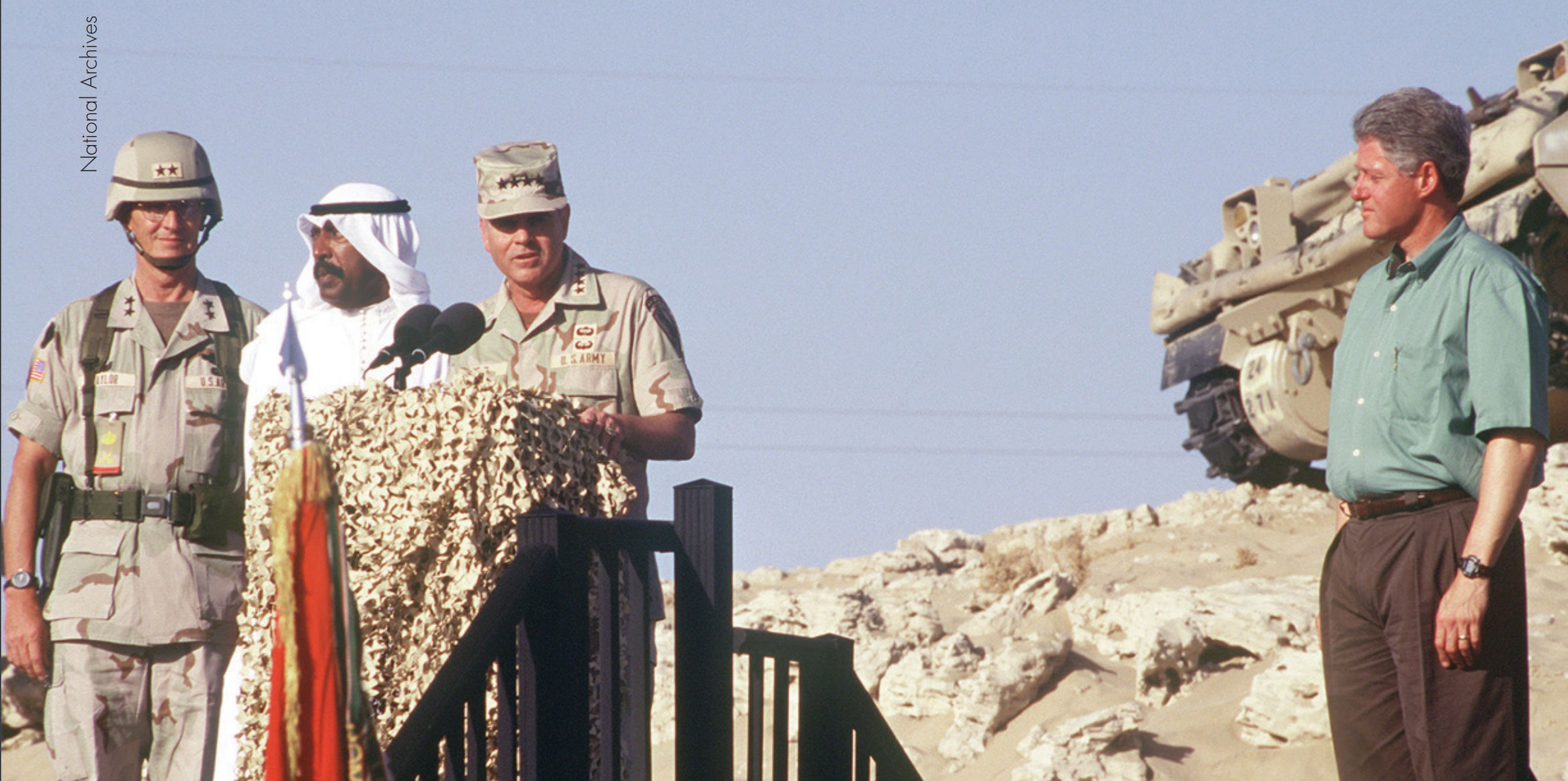
(From left to right) General Taylor; Saad Al-Salim Al-Sabah, the crown prince of Kuwait; General Peay; and President Clinton address troops during Operation Vigilant Warrior.
In most cases, soldiers found workarounds to problems. Because of a lack of engineering equipment in AWR‒5, a single company of engineers conducted split operations in support of two battalion task forces. A shortage of radios with encryption necessitated communicating tactical information “in the clear”—a cumbersome affair due to security precautions. S. Sgt. Grant R. Rosen of Company C, 3d Battalion, 69th Armor, explained how radio operators reported grid coordinates in code, using the words “camel turds” as the key in which each letter stands for a number from 0 to 9.78 Fortunately, the hastily assembled and minimally equipped force was not put to the test.
Some critics, including the French defense minister François G. M. Léotard, accused President Clinton of playing politics with the military ahead of the November midterm congressional elections.79 However, no evidence suggests that Clinton’s resolve in the face of Iraqi aggression was a ploy to gain more votes for members of his Democratic party. Senate minority leader Robert J. Dole, a Republican, supported the president’s decision to send troops to the Middle East, even though Dole had opposed U.S. intervention in Haiti the month before. In any case, Republicans won majorities in both houses of Congress, flipping the leadership of both chambers.
Others, including some in the intelligence community, claimed that the United States overreacted. Early in the crisis, General Peay told his staff that he “would rather take the heat for overreacting than be responsible for getting a lot of kids killed because we weren’t prepared.”80 At any rate, assessing the validity of the charge that Operation Vigilant Warrior was an overreaction would require knowing what was in Saddam’s mind, which no one did at the time. Years later, after being captured by American soldiers, Saddam told his CIA interrogator that the 1994 troop movements were just exercises meant to keep the United States and Kuwait guessing about his intentions.81 Although the threat seemed real, Saddam’s “October Surprise” may have been a misguided show of force intended to bully the UN Security Council into ending or easing sanctions and to distract from Iraq’s deteriorating domestic situation. Even though Saddam did not achieve sanctions relief and had to make concessions after withdrawing his troops from the border, he continued to test the resolve of the United States. But never again did Iraq use ground troops to threaten its neighbors
Footnotes
1 United Nations Security Council, Resolution (UNSCR) 661, Iraq-Kuwait, S/RES/661 (6 Aug 1990), https://undocs.org/S/RES/661(1990).
2 UNSCR 687, Iraq-Kuwait (3 Apr 1991) https://undocs.org/S/RES/687(1991).
3 Hans Blix, Disarming Iraq (New York: Pantheon, 2004), p. 20.
4 On the free flow of oil as a vital U.S. national interest, see Public Statements of William J. Perry Secretary of Defense, 1996–1997, vol. 3 (Washington, D.C.: Historical Office, Office of the Secretary of Defense, n.d.), p. 1533.
5 Phebe Marr and Ibrahim Al-Marashi, The Modern History of Iraq, 4th ed. (Boulder, Colo.: Westview, 2017), p. 239; for the full text of the resolution, see UNSCR 706, Iraq-Kuwait, S/RES/706 (15 Aug 1991), https://undocs.org/S/ RES/706(1991).
6 Marr and Al-Marashi, The Modern History of Iraq, p. 238; Thomas A. Sancton, “No Longer Fenced In,” Time, 23 May 1994, http://content.time.com/time/magazine/ article/0,9171,980767,00.html.
7 W. Eric Herr, “Operation Vigilant Warrior: Conventional Deterrence Theory, Doctrine, and Practice” (thesis, U.S. Air Force School of Advanced Airpower Studies, 1996), p. 13; Elaine Sciolino, “Kuwait Crisis: Hussein Gambles to Keep Power,” New York Times, 11 Oct 1994.
8 Marr and Al-Marashi, The Modern History of Iraq, p. 241; Sciolino, “Kuwait Crisis.”
9 Herr, “Operation Vigilant Warrior,” pp. 13–14.
10 Sancton, “No Longer Fenced In.”
11 Rpt, Stanley A. Puckett and Jay E. Hines, “The October Surprise: Operation Vigilant Warrior, 10 October–22 December 1994” (unpublished report, no date), p. 27, General Peay Collection (hereinafter Peay Coll), Box 23, U.S. Army Heritage and Education Center (USAHEC), Carlisle, Pa.
12 Rpt, Frank Williams, Jun 2015, sub: The Projection of Force: Two Weeks in the Life of Third United States Army, ch. 1, p. 6, Operation Vigilant Warrior Collection (hereinafter OVW Coll), U.S. Army Center of Military History (CMH), Washington, D.C.
13 Puckett and Hines, “October Surprise,” p. 32.
14 Ibid.; Anthony H. Cordesman, Iraq and the War of Sanctions (Westport, Conn.: Praeger, 1999), p. 202.
15 Puckett and Hines, “October Surprise,” p. 24.
16 Ibid., p. A 137.
17 Daniel L. Byman and Matthew C. Waxman, Confronting Iraq: U.S. Policy and the Use of Force Since the Gulf War (Santa Monica, Calif.: RAND, 2000), p. 55; Herr, “Operation Vigilant Warrior,” pp. 26–27.
18 Puckett and Hines, “October Surprise,” pp. 37–38.
19 Williams, “Projection of Force,” ch. 1, p. 10; ch. 2, pp. 3–4; Herr, “Operation Vigilant Warrior,” p. 26.
20 Williams, “Projection of Force,” ch. 1, p. 9.
21 Ibid., ch. 1, p. 15.
22 Ibid., ch. 1, p. 9.
23 The fact that the Kuwaiti government requested U.S. ground troops to reinforce their brigades suggests that they doubted their own military had the capability to defend the country against the threat.
24 Herr, “Operation Vigilant Warrior,” p. 27.
25 Puckett and Hines, “October Surprise,” p. 26.
26 Notes, Gen J. H. Binford Peay III, 6 Oct–9 Dec 1994, “XO’s Notes,” pp. 2–3, Peay Coll, USAHEC.
27 Peay, “XO’s Notes,” p. 4.
28 Ibid., p. 8.
29 Ibid., p. 5.
30 Williams, “Projection of Force,” ch. 1, pp. 26–27.
31 Ibid., ch. 1, p. 27.
32 Ibid., ch. 1, p. 5. On 8 October 1994, CENTCOM’s director of intelligence, Brig. Gen. James C. King, told General Peay that Saddam possessed both capability and intent of attacking Kuwait and threatening Kuwait City but not Saudi Arabia. Peay, “XO’s Notes,” p. 10.
33 Public Papers of the Presidents of the United States: William J. Clinton, 1994, bk. 1, January 1–July 31, 1994 (Washington, D.C.: Government Printing Office, 1995), p. 1726.
34 Ibid., p. 1725.
35 Peay, “XO’s Notes,” p. 5.
36 Williams, “The Projection of Force,” ch. 1, p. 14.
37 Ibid., ch. 2, p. 5, n. 4.
38 Ibid., ch. 1, p. 20.
39 Michael A. Knights, Cradle of Conflict: Iraq and the Birth of Modern U.S. Military Power (Annapolis, Md.: Naval Institute Press, 2005), p. 146.
40 Puckett and Hines, “October Surprise,” p. 42.
41 Gp Interv by Maj Michael W. Byrne with Co A, 2d Bn, 7th Inf, 28 Nov 1994 (CMH Catalog No. VWIT-A–027b), OVW Coll, CMH.
42 Peay, “XO’s Notes,” p. 4.
43 Puckett and Hines, “October Surprise,” pp. 43–44.
44 Herr, “Operation Vigilant Warrior,” p. 28.
45 Puckett and Hines, “October Surprise,” p. 47; Mark Matthews, “U.S. Sees No Iraqi Pullback, Beefs Up Airpower,” Baltimore Sun, 11 Oct 1994, http://www.baltimoresun.com/ news/bs-xpm-1994-10-11-1994284091-story. html.
46 Puckett and Hines, “October Surprise,” p. 47; “Iraq Says It’s Ending Border Build-Up,” St. Louis Post-Dispatch, 11 Oct 1994, https:// www.questia.com/newspaper/1P2-32899447/ iraq-says-it-s-ending-border-buildup.
47 Public Papers William J. Clinton, 1994, bk. 1, p. 1726.
48 Puckett and Hines, “October Surprise,” p. 47.
49 Williams, “The Projection of Force,” ch. 2, p. 5.
50 Quoted in Herr, “Operation Vigilant Warrior,” p. 31.
51 Puckett and Hines, “October Surprise,” p. 52.
52 Williams, “The Projection of Force,” ch. 2, p. 8; J. H. Binford Peay III, “The Five Pillars of Peace in the Central Region,” Joint Forces Quarterly (Autumn 1995): 32.
53 Quoted in Bradley Graham and Ruth Marcus, “U.S. Considers Further Restricting Iraq’s Military,” Washington Post, 12 Oct 1994.
54 UNSCR 949, Iraq, S/RES/949 (15 Oct 1994), https://undocs.org/S/RES/949(1994).
55 Ibid.
56 AAR, 24th Inf Div (Mech), 19 Jan 1995, “Chronological Summary of Events,” OVW Coll, CMH.
57 AAR, 6th Transportation Bn (Truck), 10 Jan 1995, n.p., OVW Coll, CMH.
58 Interv, Maj Michael W. Byrne with Capt Donald V. Phillips, Co A, 2‒69 Armor, 3d Bde, 24th Inf Div, 9 Nov 1994 (CMH Catalog No. VWIT–A–007B), OVW Coll, CMH.
59 AAR, 6th Transportation Bn (Truck), 10 Jan 1995, n.p., OVW Coll, CMH.
60 Interv, Byrne with Phillips, 9 Nov 1994.
61 Ibid.
62 Inal Ersan, “Tanker Captain Admits Loading Iraqi Diesel Oil,” Washington Post, 25 Oct 1994.
63 Looking back a year later, President Clinton said, “I have stood in the desert of Kuwait with our vigilant warriors who stopped Iraqi aggression this time before it could start.” Public Papers of the Presidents of the United States: William J. Clinton, 1995, bk. 1 (Washington, D.C.: Government Printing Office, 1996), p. 1733.
64 Herr, “Operation Vigilant Warrior,” p. 8.
65 Speaking on 22 August 1995, Perry said, “There have been some unusual deployments of Iraqi military forces—nothing that leads us to believe that any invasion is underway or planned—in particular, nothing like we saw in October of 1994 which we believed was clearly indicative an invasion was planned” (emphasis added). Public Statements of William J. Perry Secretary of Defense, 1995, vol. 4 (Historical Office, Office of the Secretary of Defense, n.d.), p. 2676.
66 Michael Jansen, “Saddam’s Phoney Crisis,” Middle East International (21 Oct 1994): 4‒5.
67 Judith Perera, “Russia’s Measured Response,” Middle East International (21 Oct 1994): 5‒6.
68 Ibid.
69 Gordon R. Sullivan, “A Vision for the Future,” Military Review (May–Jun 1995): 6.
70 Stephen L. Y. Gammons and William M. Donnelly, Department of the Army Historical Summary, Fiscal Year 1995 (Washington, D.C.: CMH, 2004), p. 47.
71 Williams, “The Projection of Force,” ch. 2, p. 17.
72 Puckett and Hines, “October Surprise,” p. 76.
73 Quoted in Herr, “Operation Vigilant Warrior,” p. 24.
74 “CINC [Gen Peay] remarked that few understand the real threat—that Iraq possessed capability to attack through Kuwait and into Saudi Arabia and to destroy a lot of the oil industry infrastructure during the period 7–10 October. The U.S. was poorly positioned to respond.” MFR, R. J. Kolton, Peay’s speechwriter, sub: “Notes from General Peay’s Meeting with CJCS [Gen Shalikashvili], 16 Oct 1994, Washington, D.C.” (16 Oct 1994), p. 1, Peay Coll.
75 AAR, 24th Inf Div (Mech), 19 Jan 1995, Tab B, “Initial Impressions Report,” p. 10.
76 Interv, Maj Michael W. Byrne with Maj Gen Joseph E. DeFrancisco, 9 Nov 1994, p. 32, (CMH Catalog No. VWIT‒A‒010), OVW Coll, CMH.
77 Puckett and Hines, “October Surprise,” p. 78; AAR, 24th Inf Div (Mech), 19 Jan 1995, pp. 5–6.
78 Interv, Maj Michael W. Byrne with Co C, 3d Bn, 69th Armor, 28 Nov 1994, (CMH Catalog No. VWIT‒A‒0282b), OVW Coll, CMH.
79 William Drozdiak, “France Implies Domestic Politics in U.S. Sparked Response to Iraq,” Washington Post, 13 Oct 1994, https:// www.washingtonpost.com/archive/politics/1994/10/13/france-implies-domestic-politics-in-us-sparked-response-to-iraq/63549b58- 1ba3-45ad-8ea8-6ed4d972dc2a/
80 Peay, “XO’s Notes,” p. 11.
81 John Nixon, Debriefing the President: The Interrogation of Saddam Hussein (New York: Blue Rider Press, 2016), pp. 113–14.
